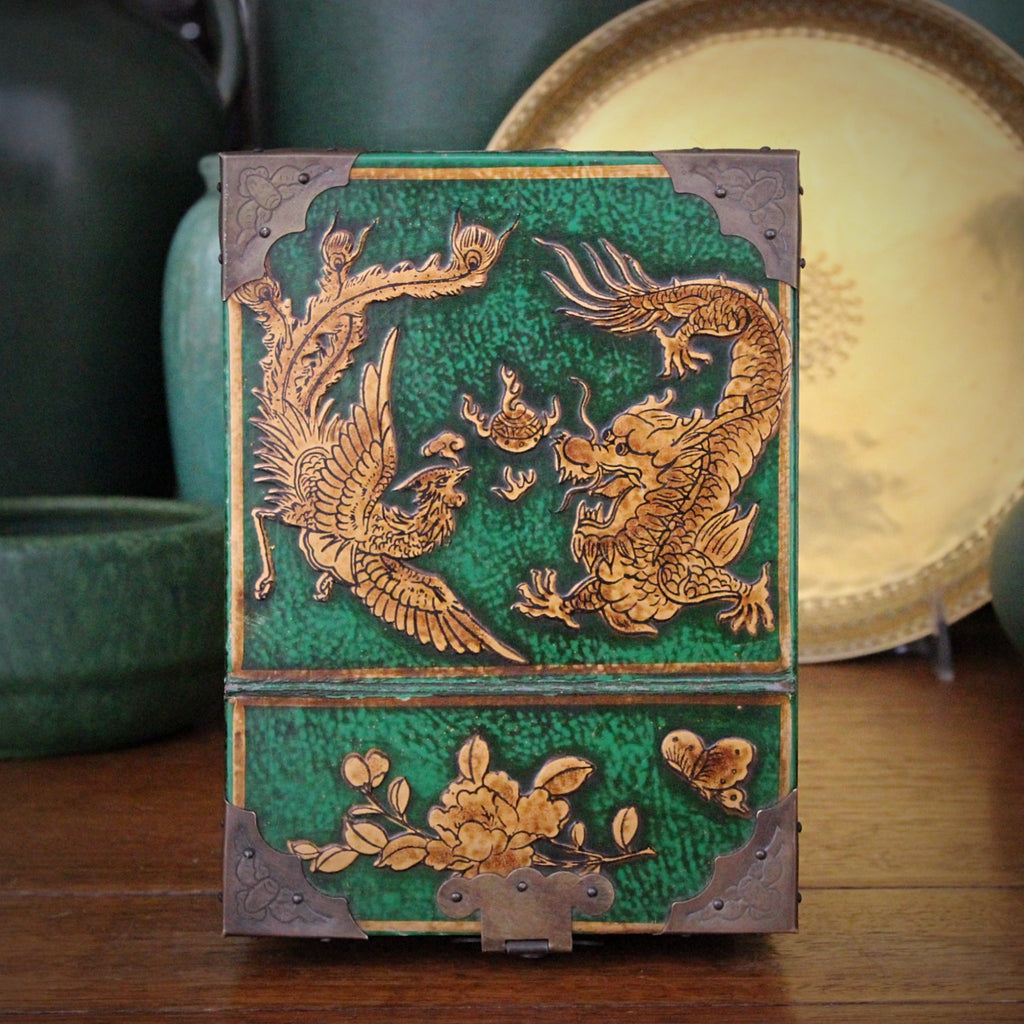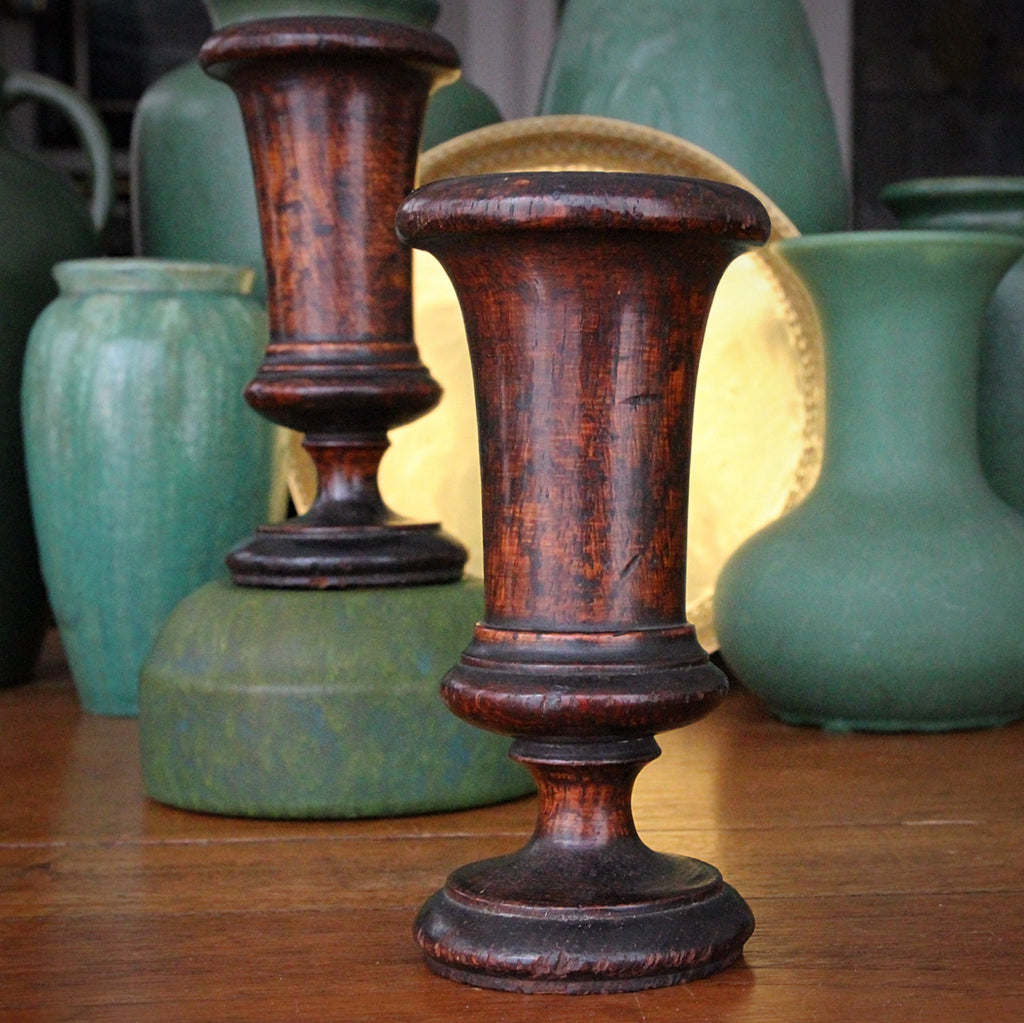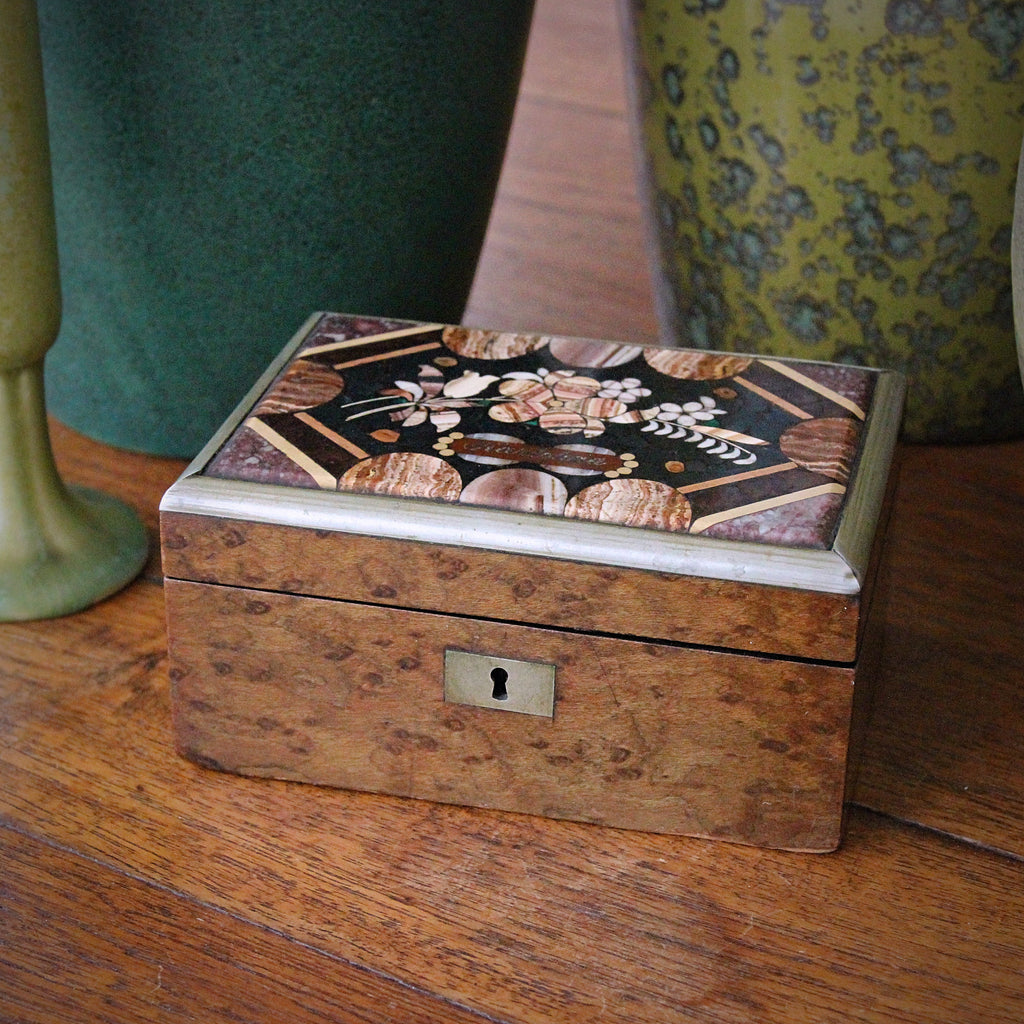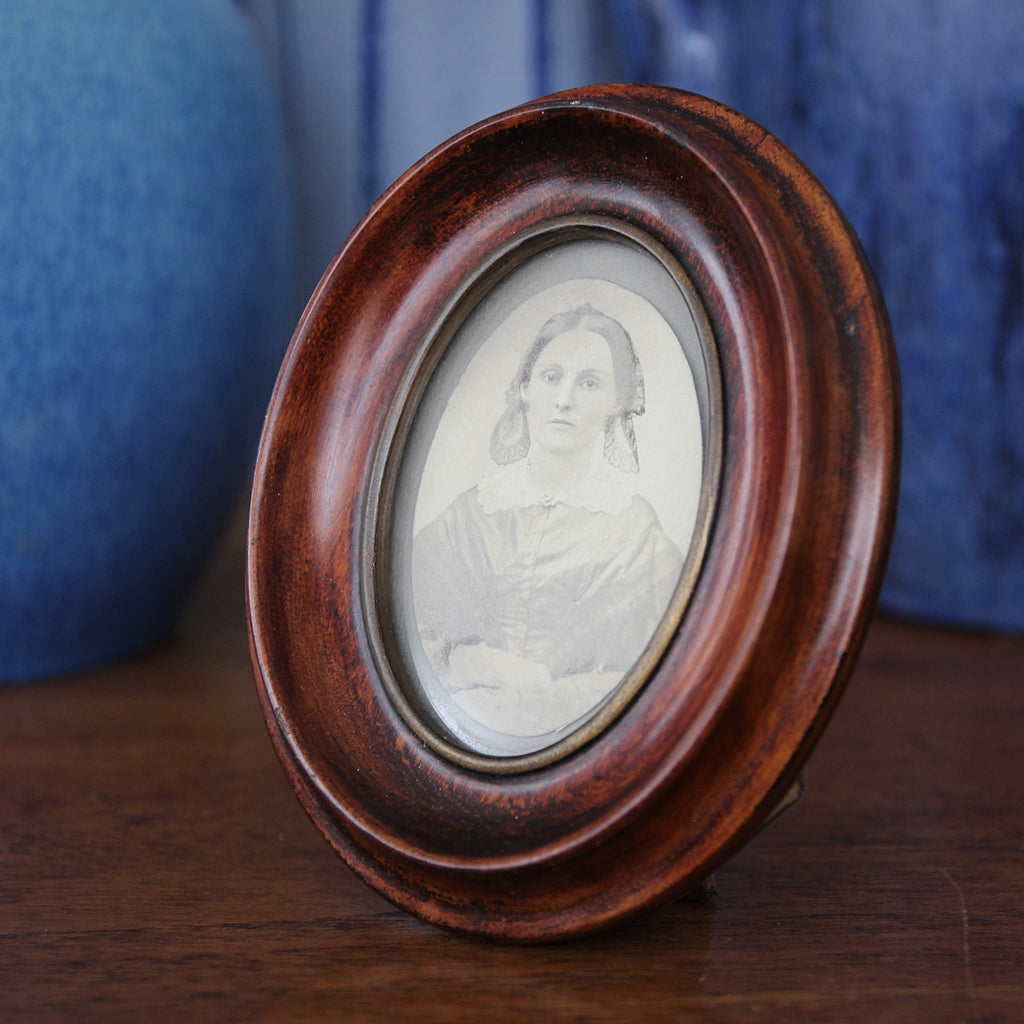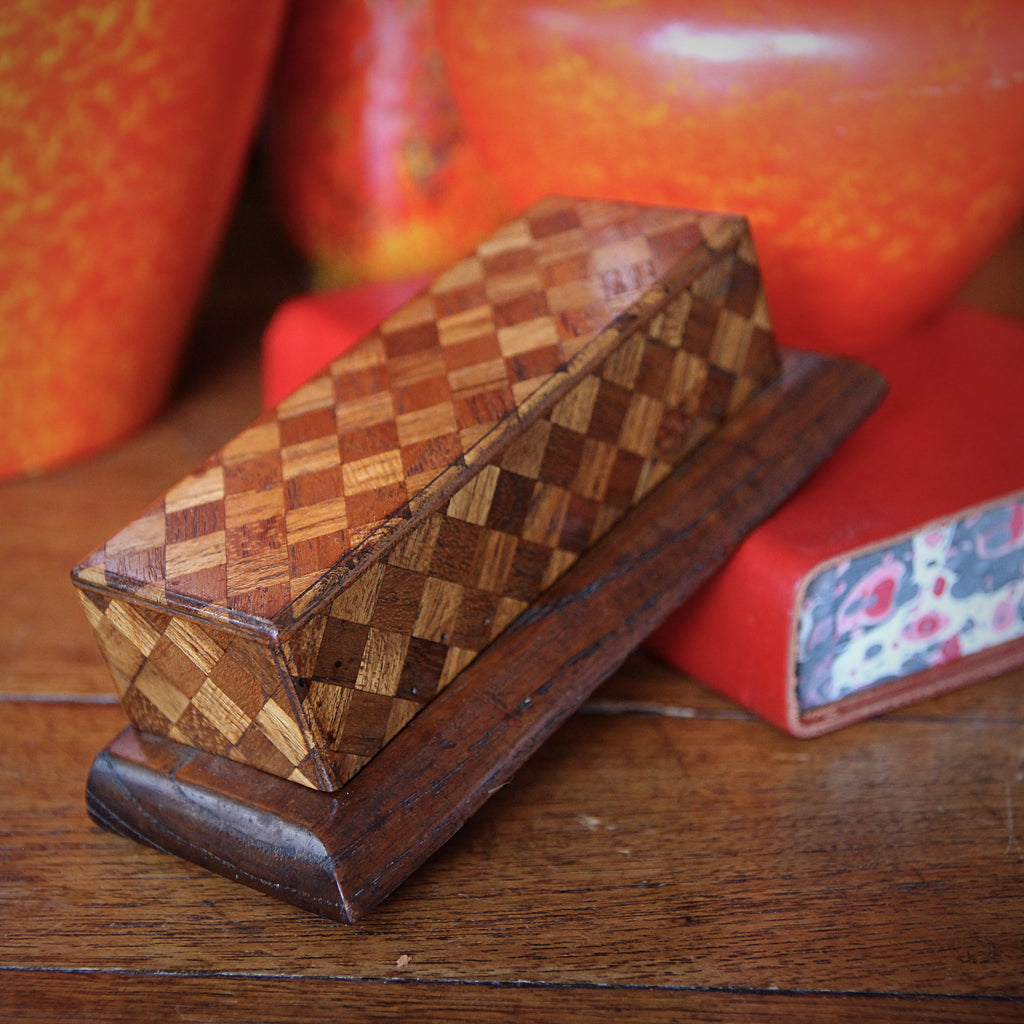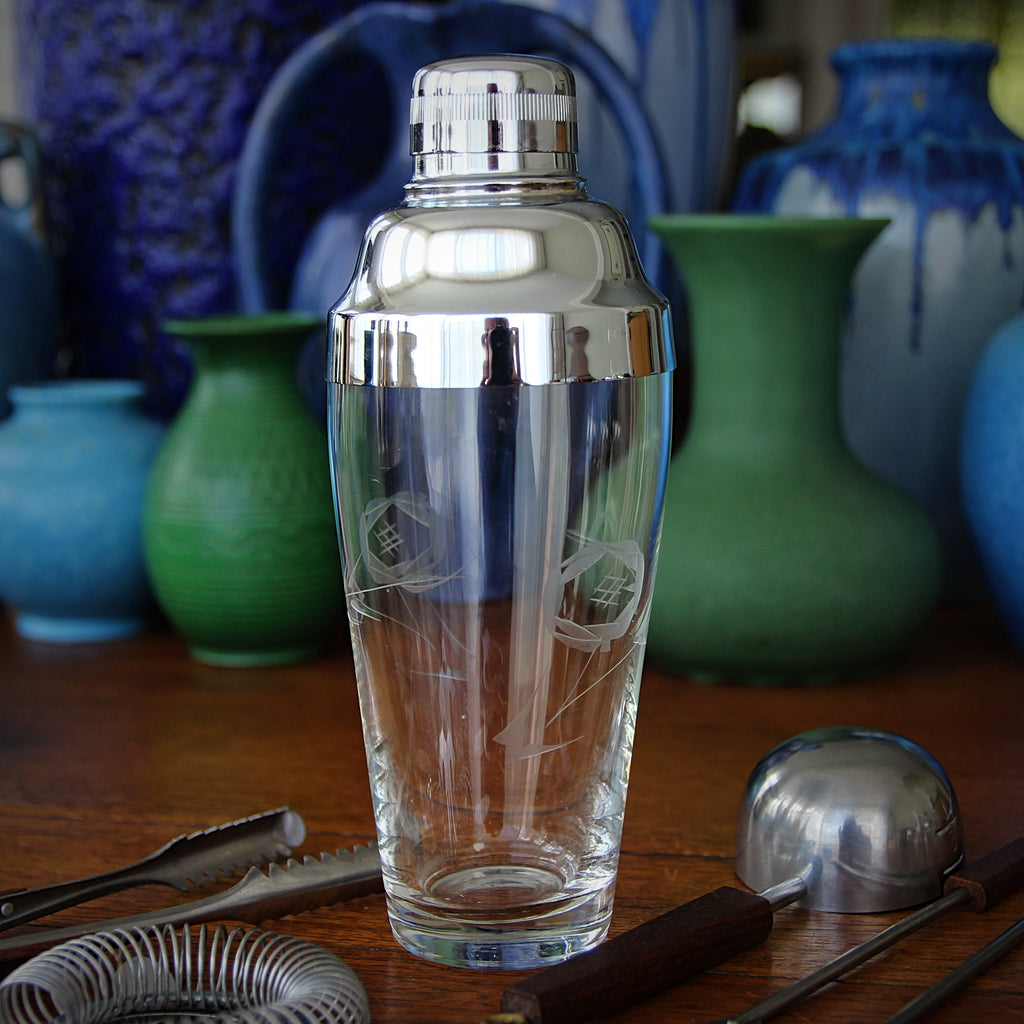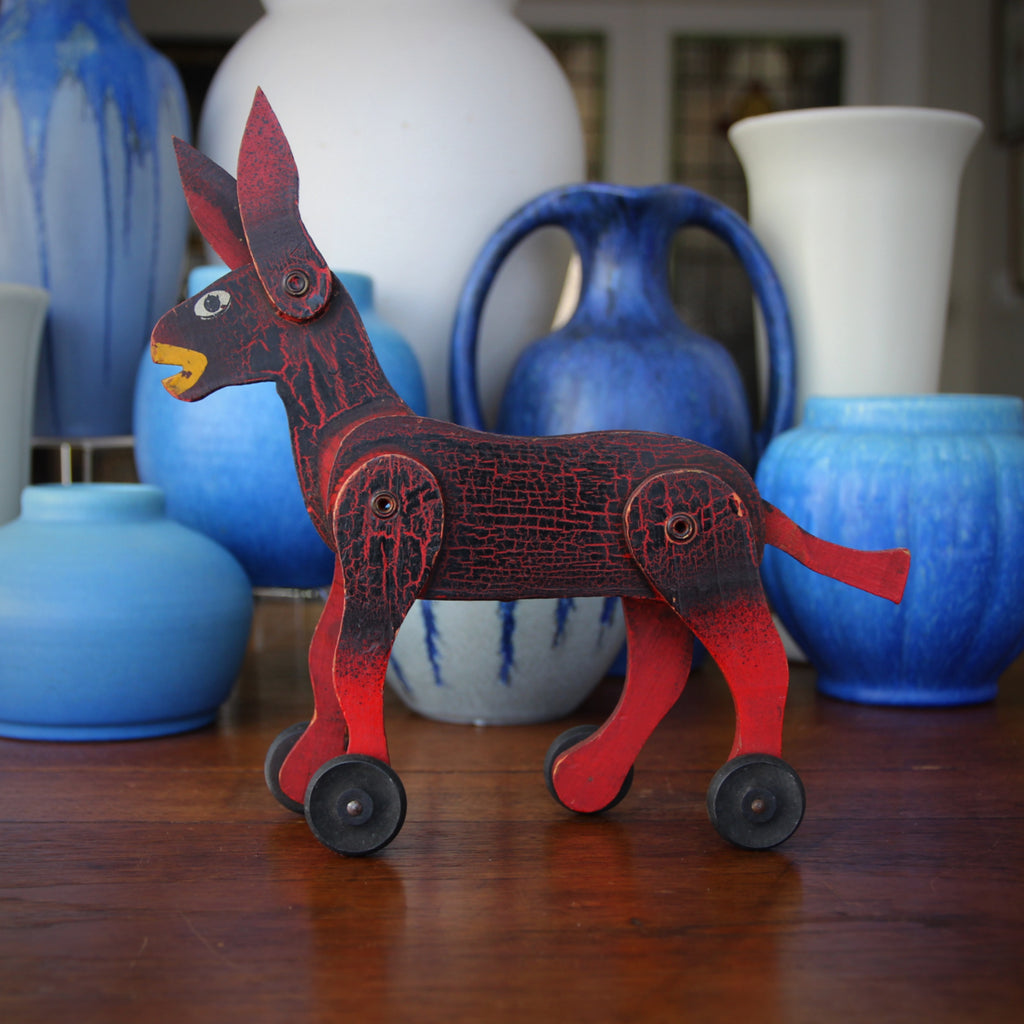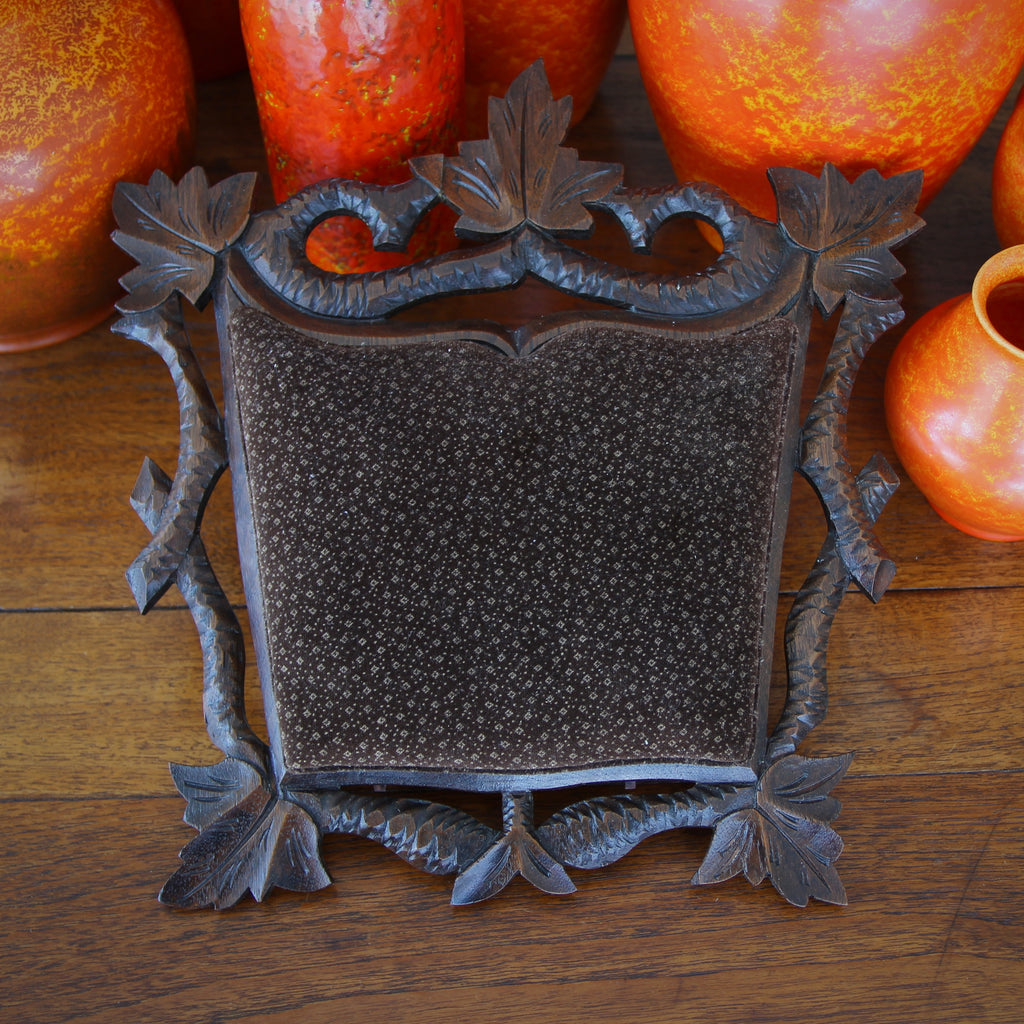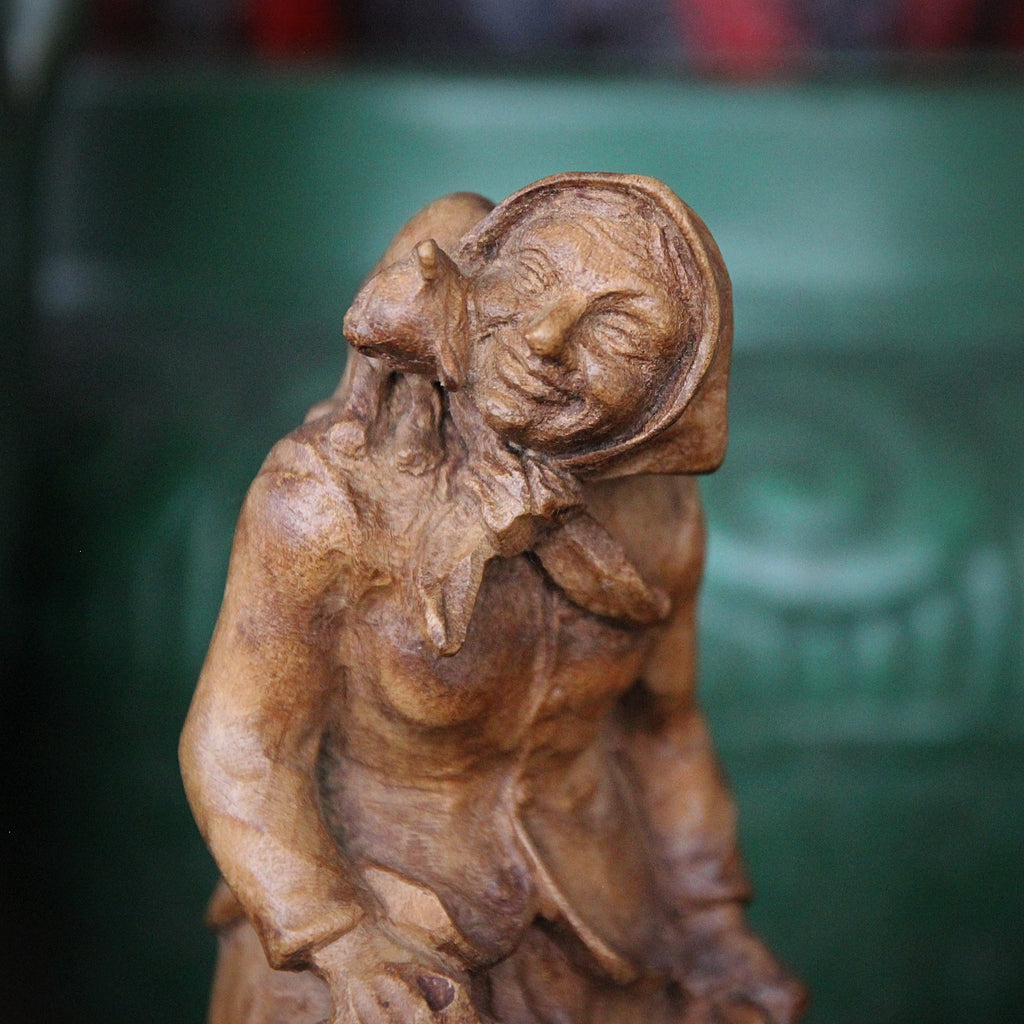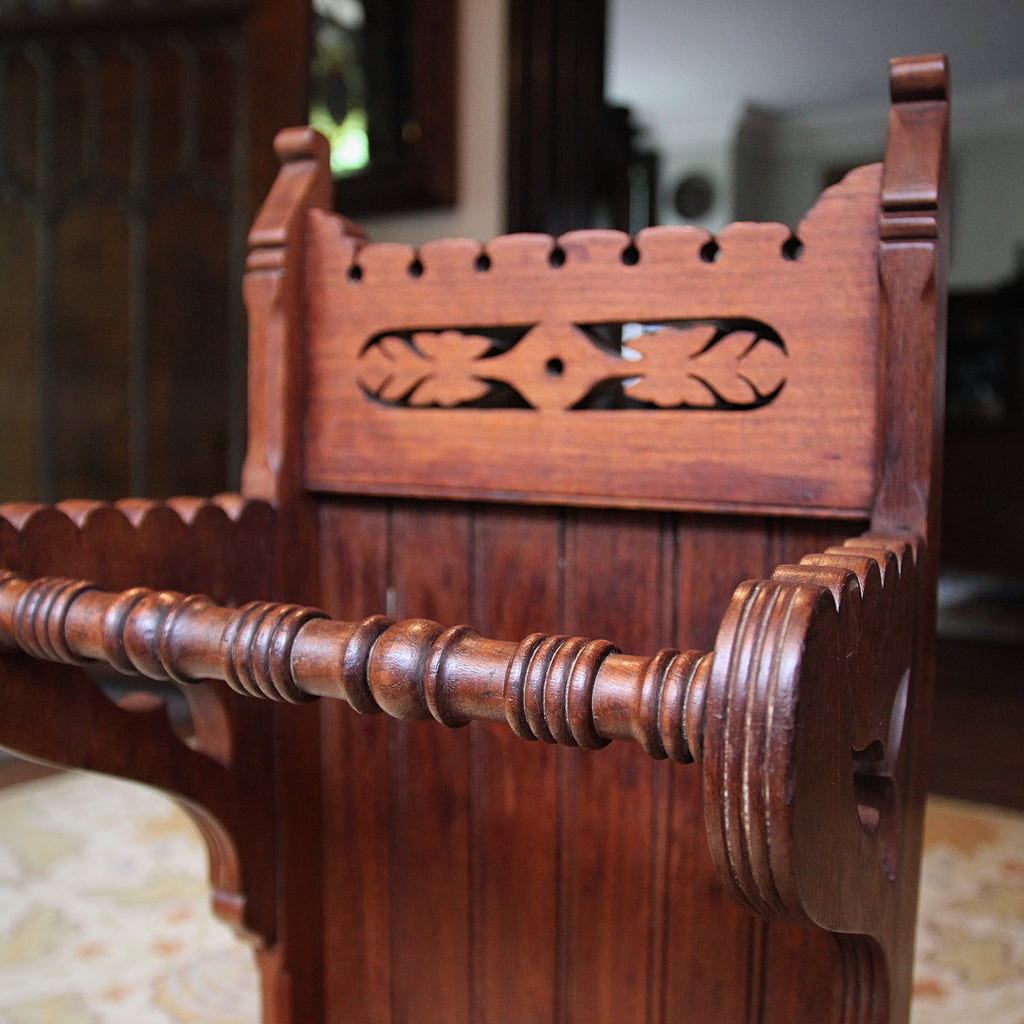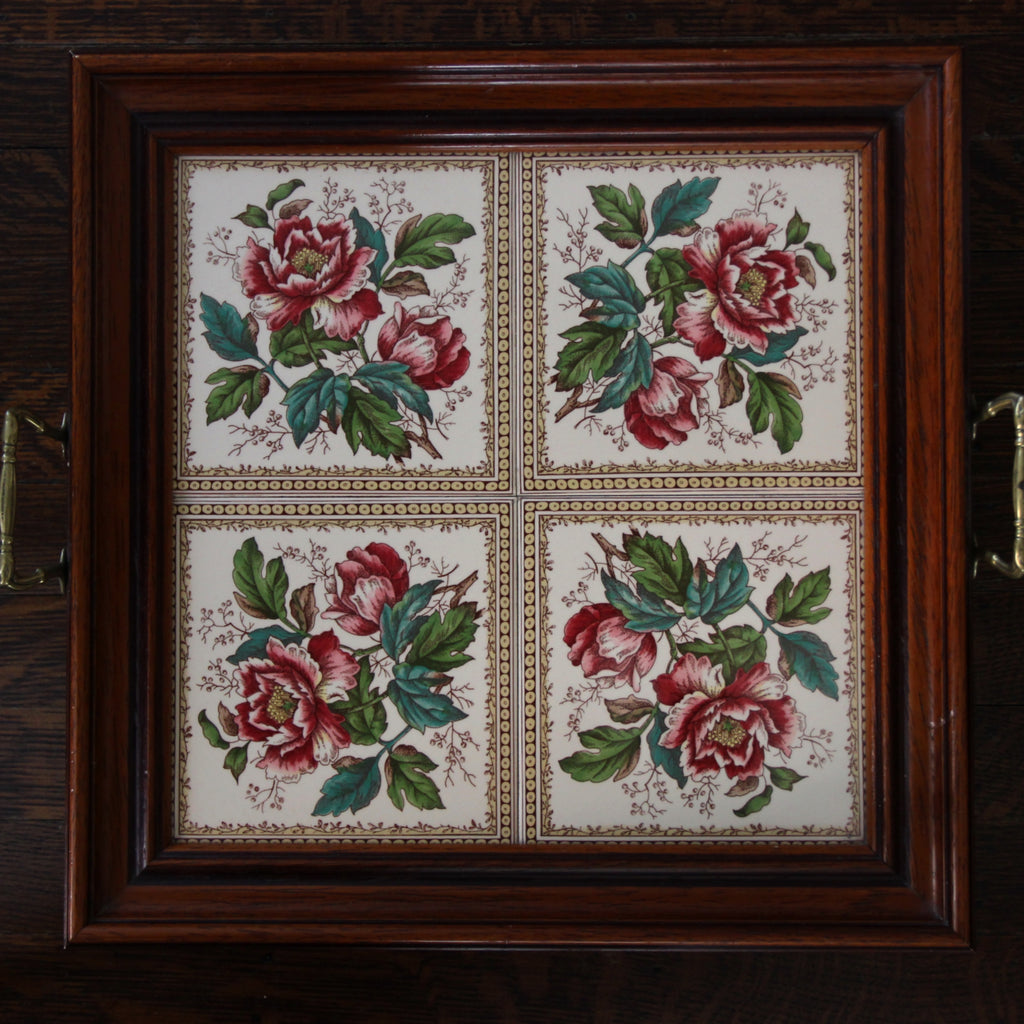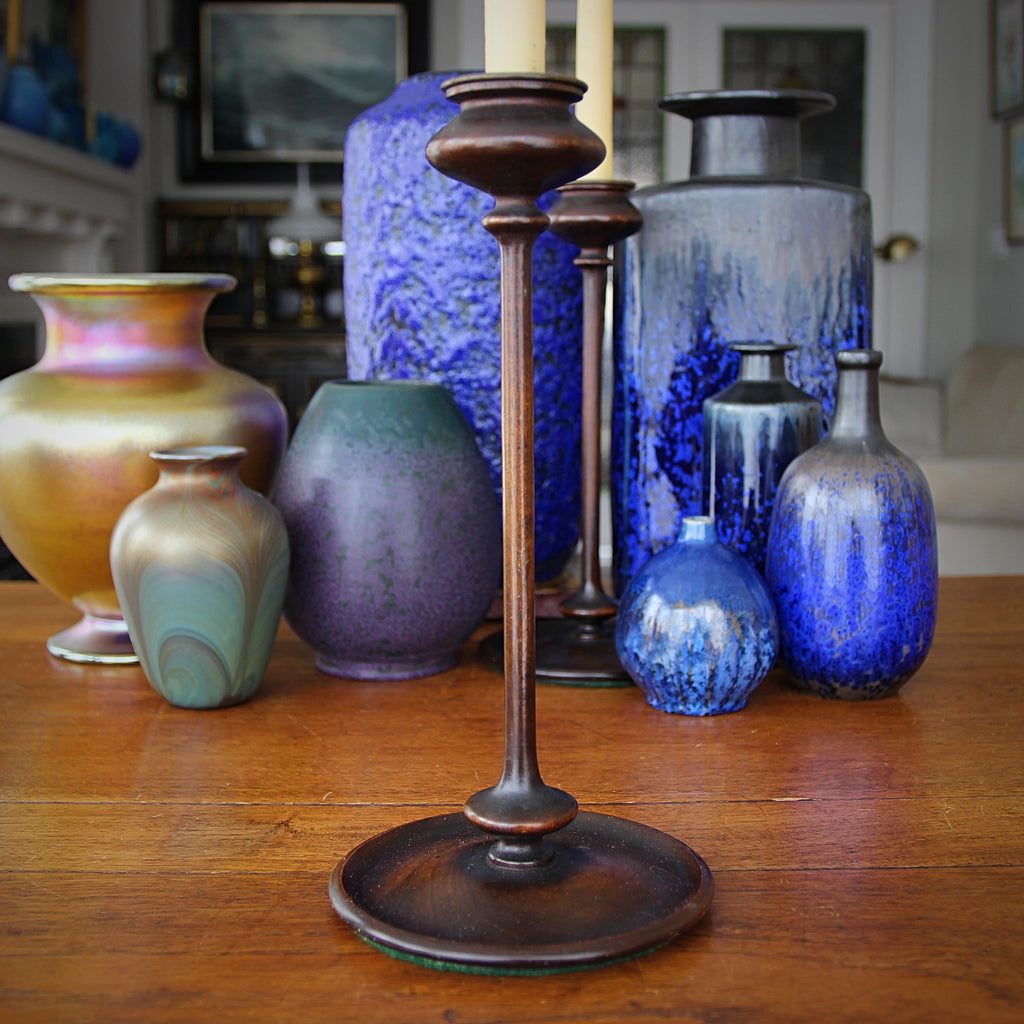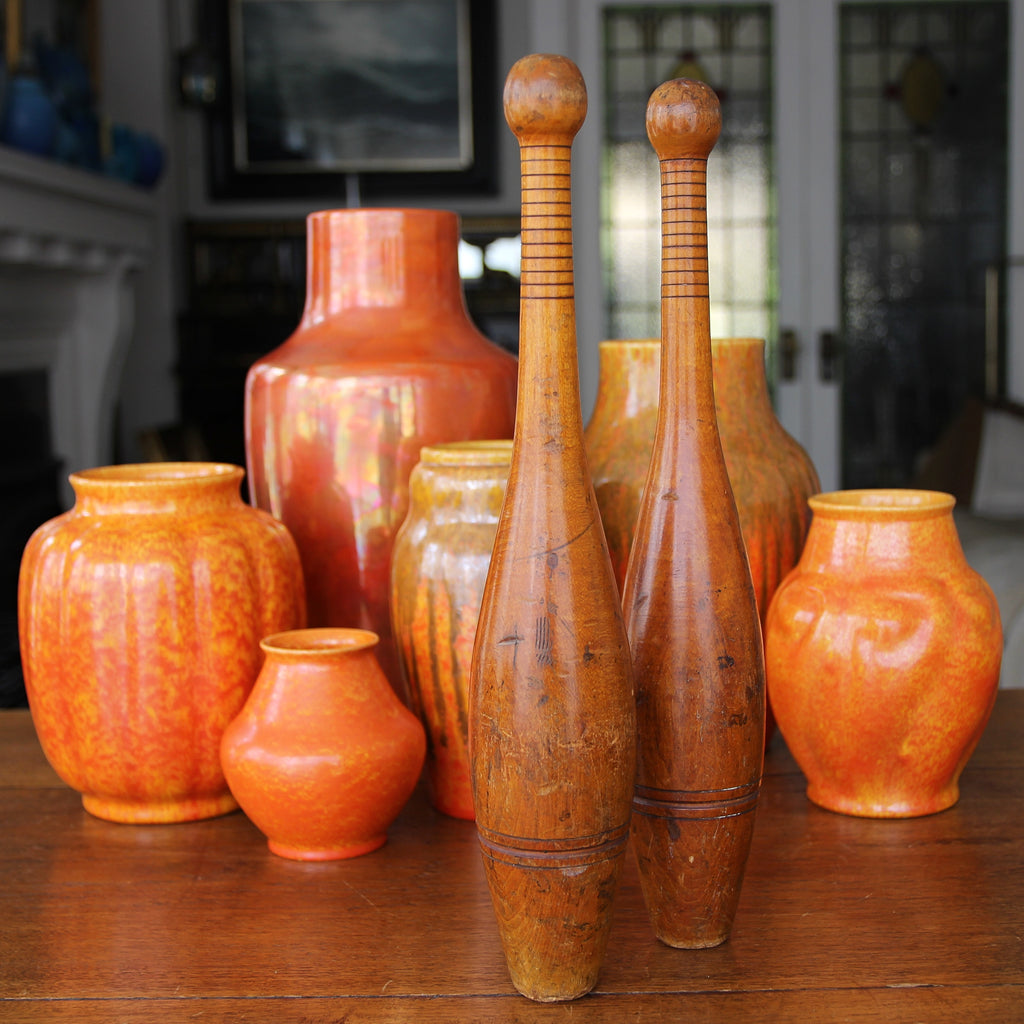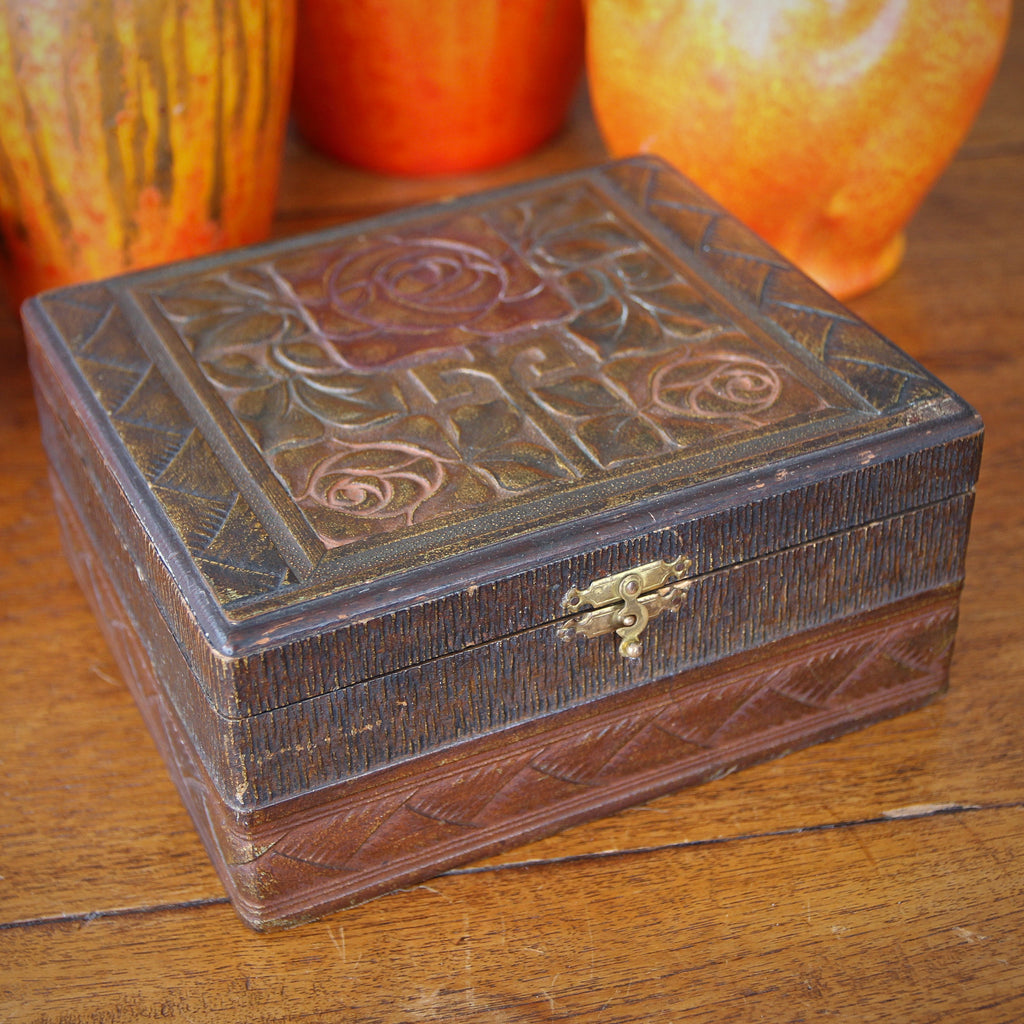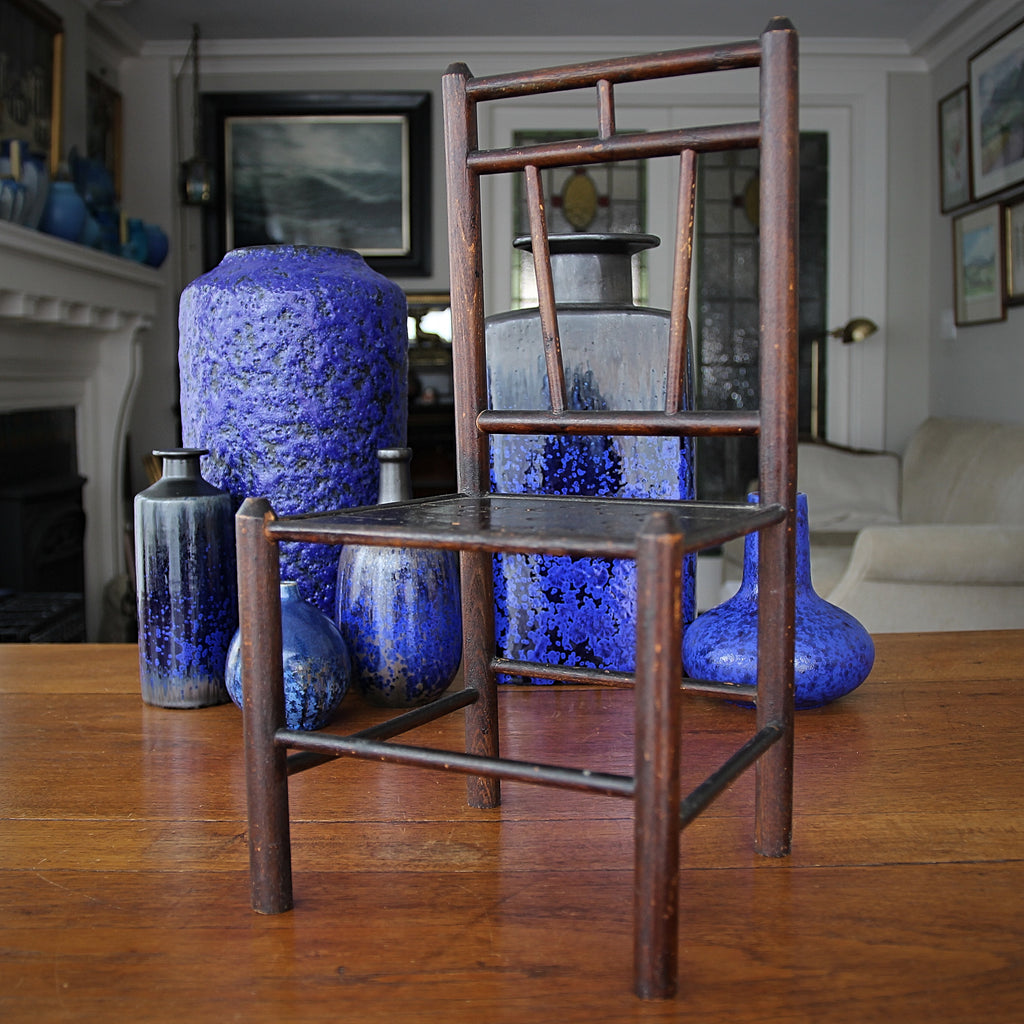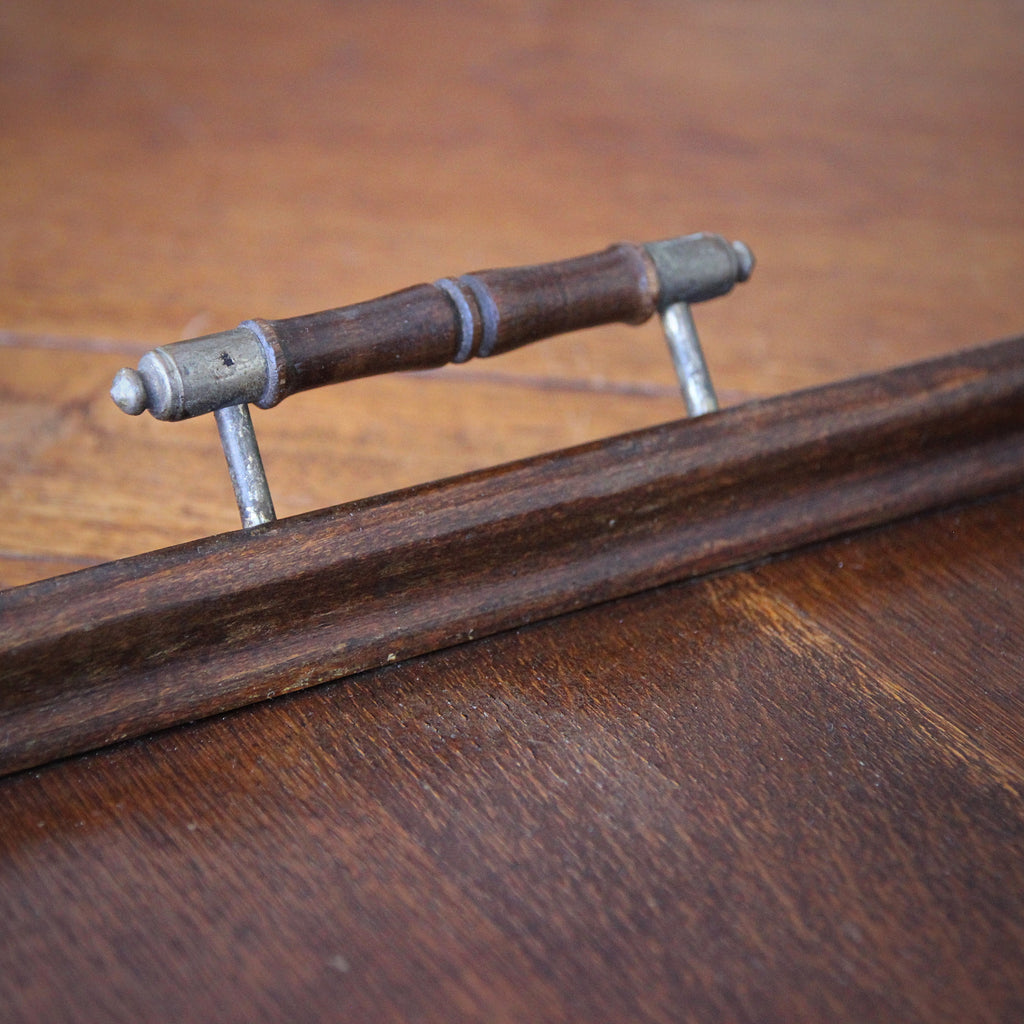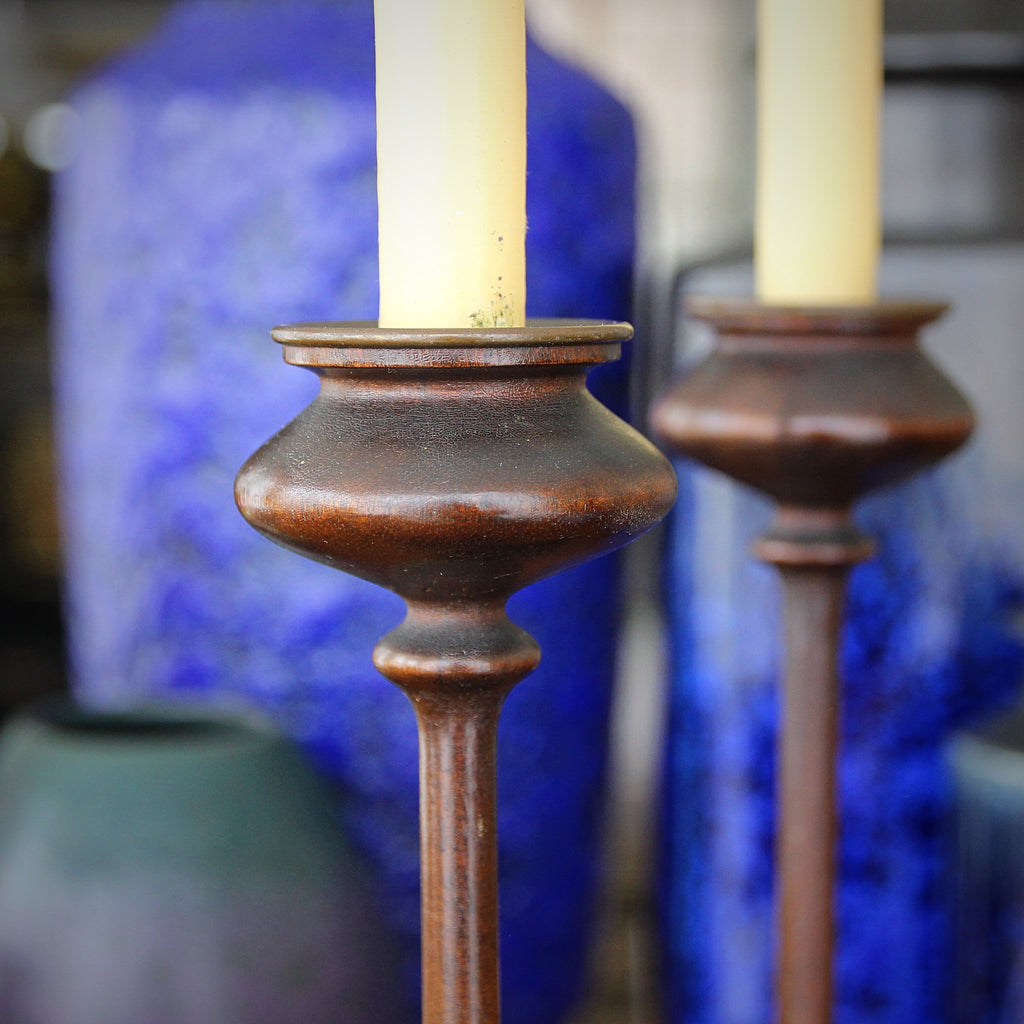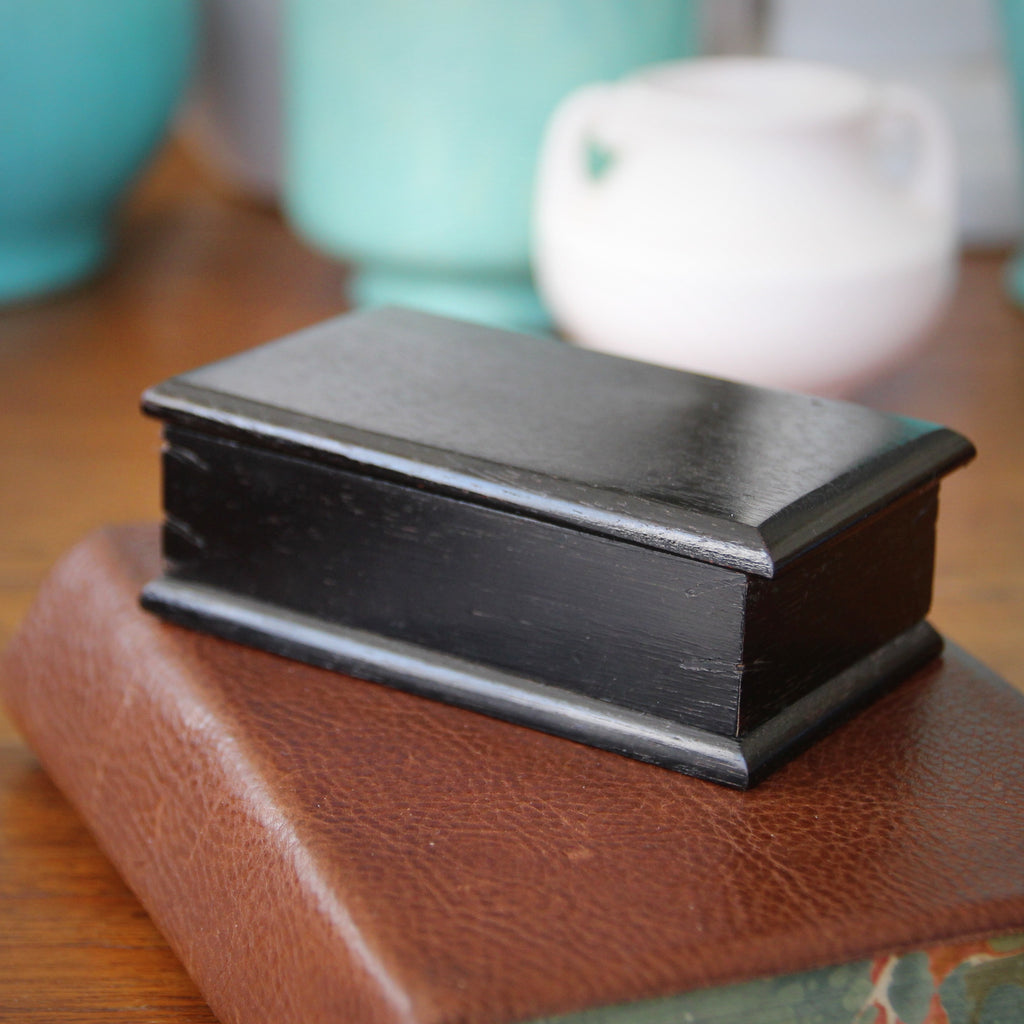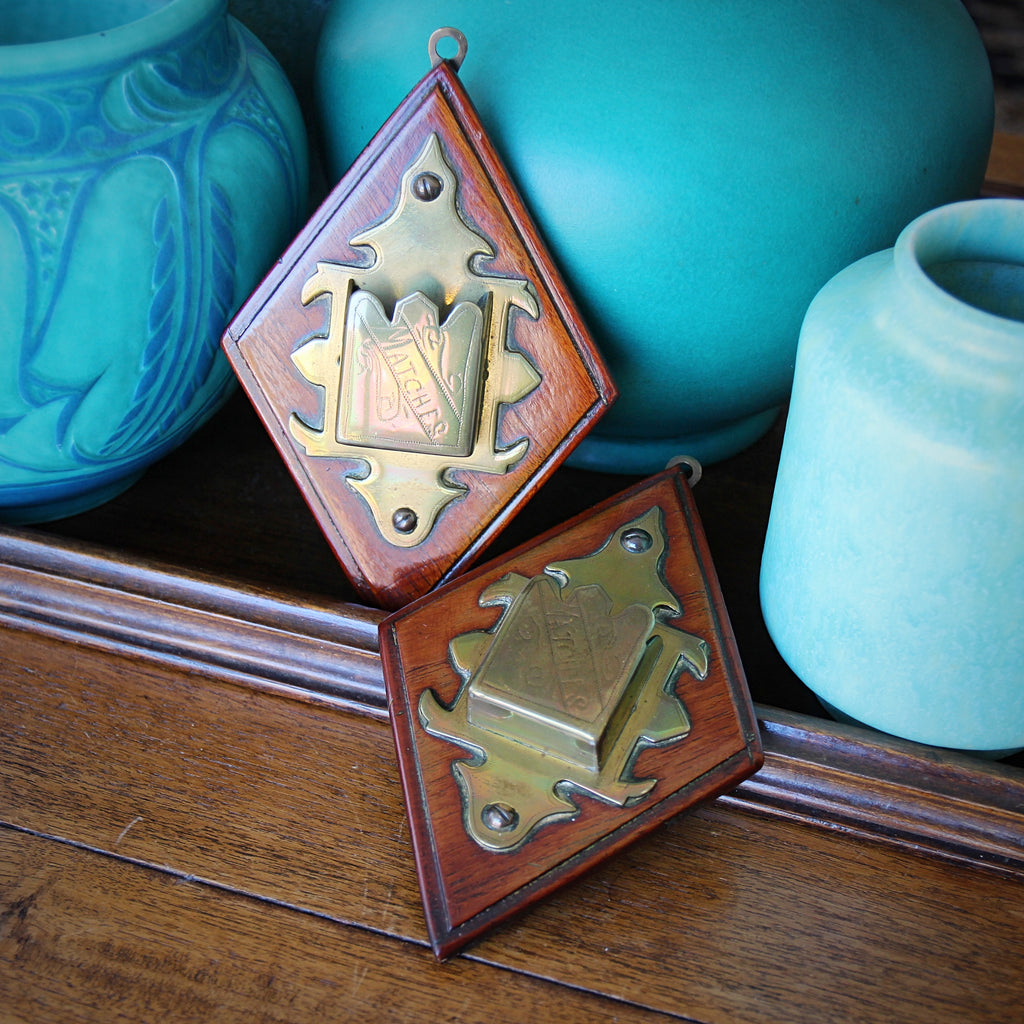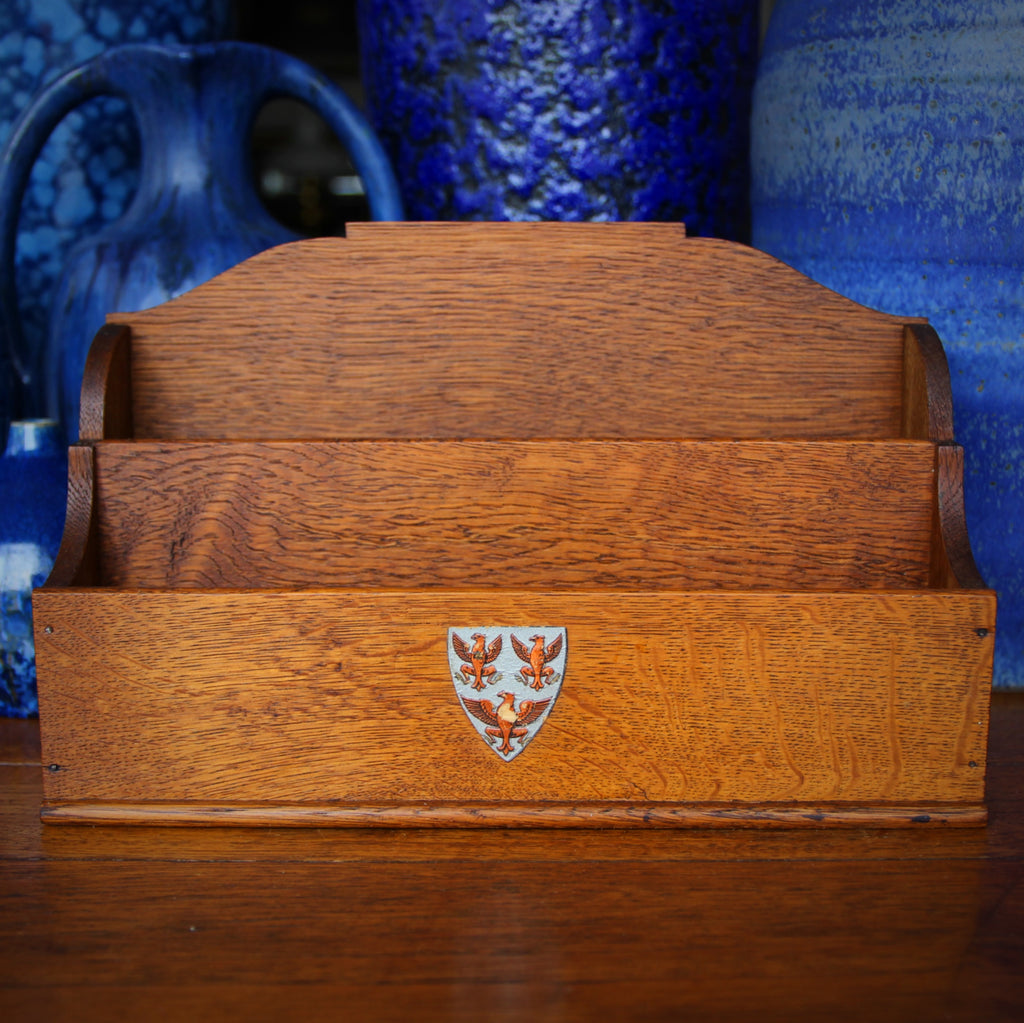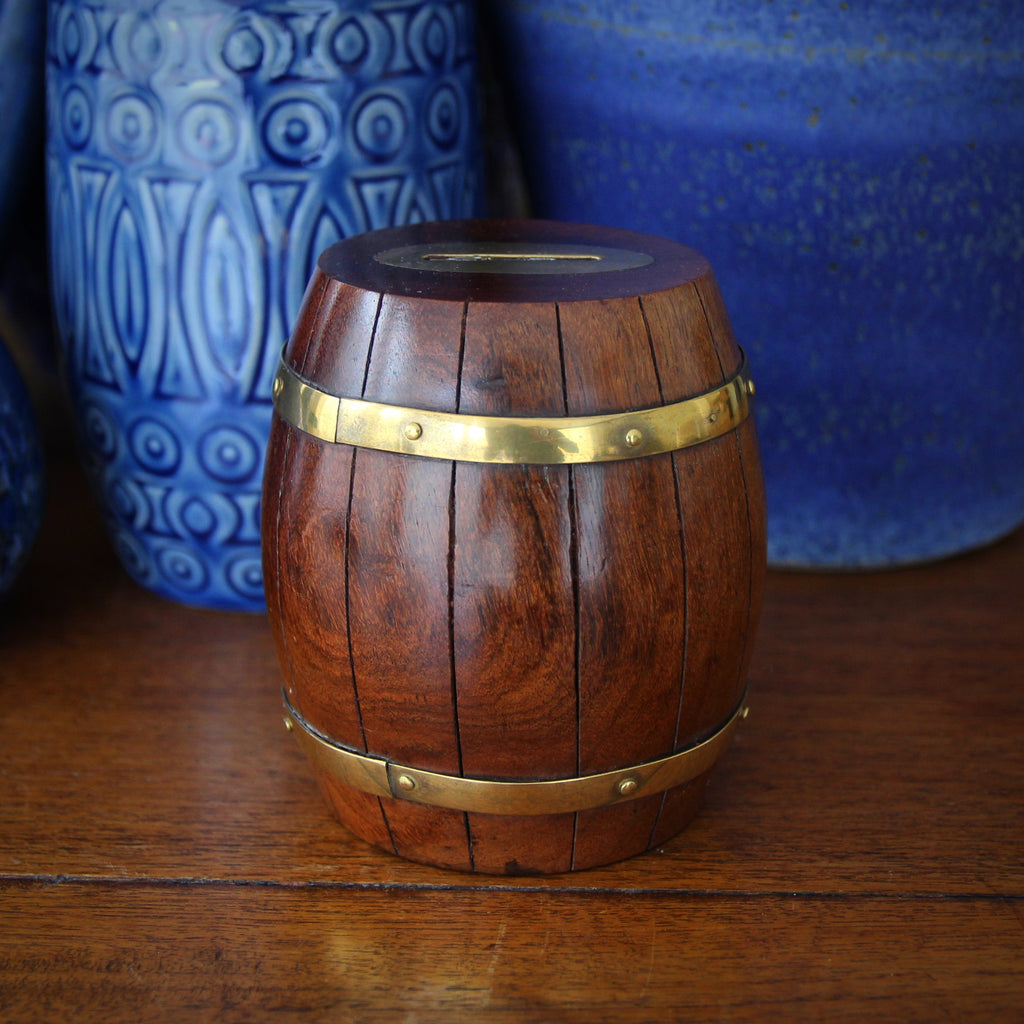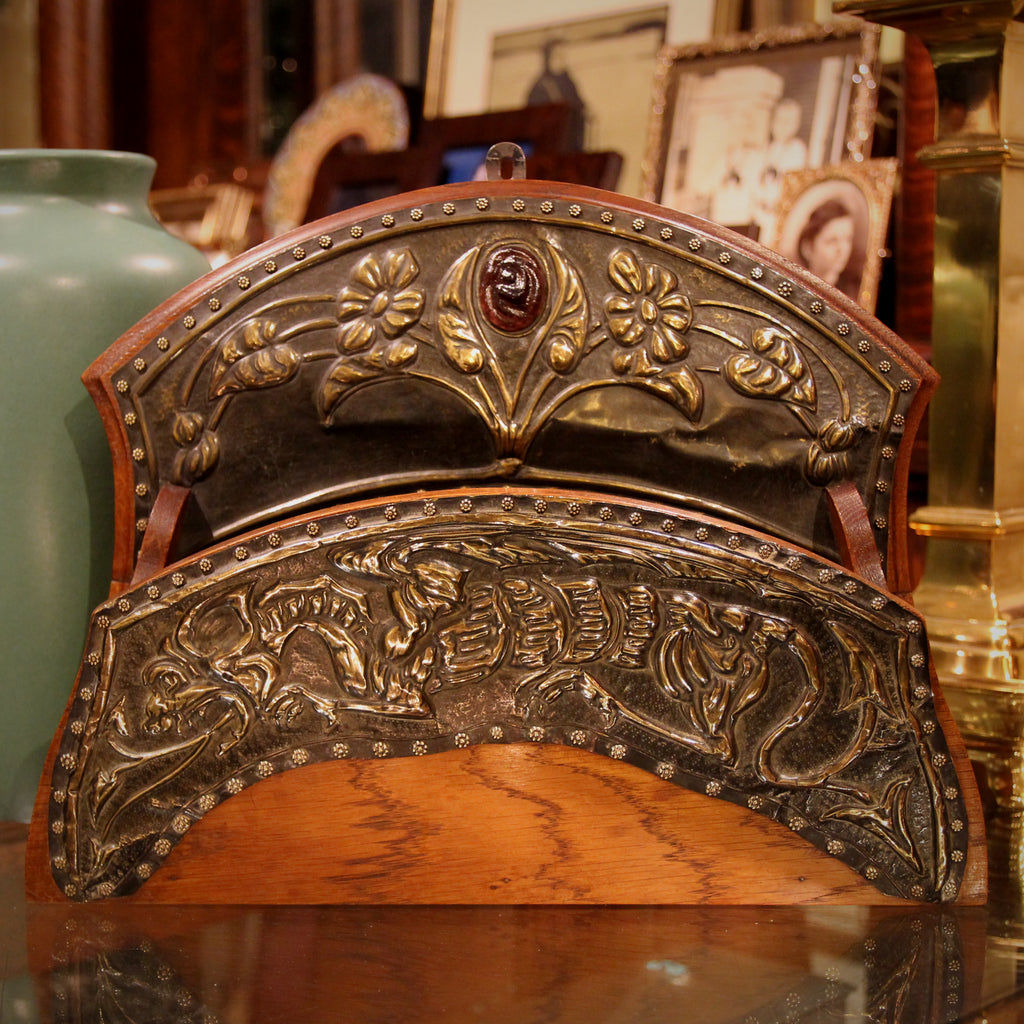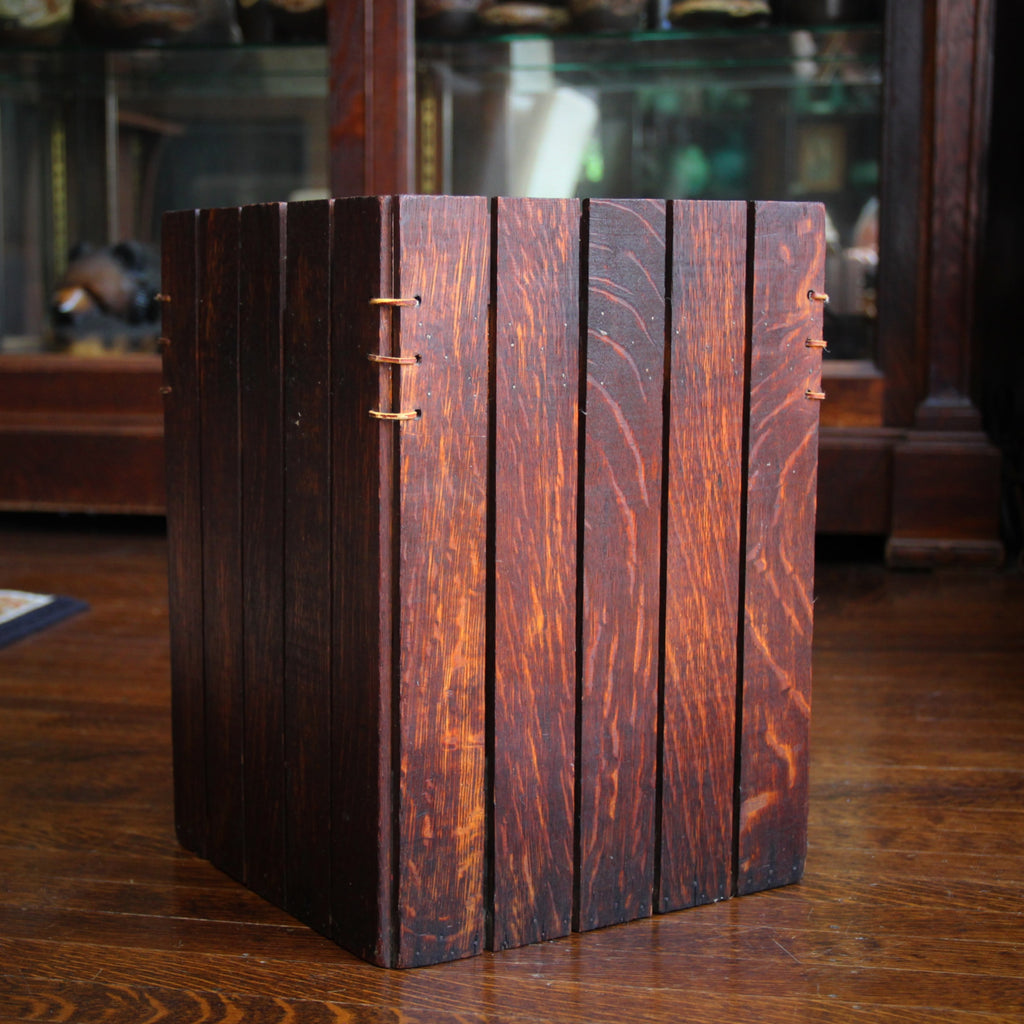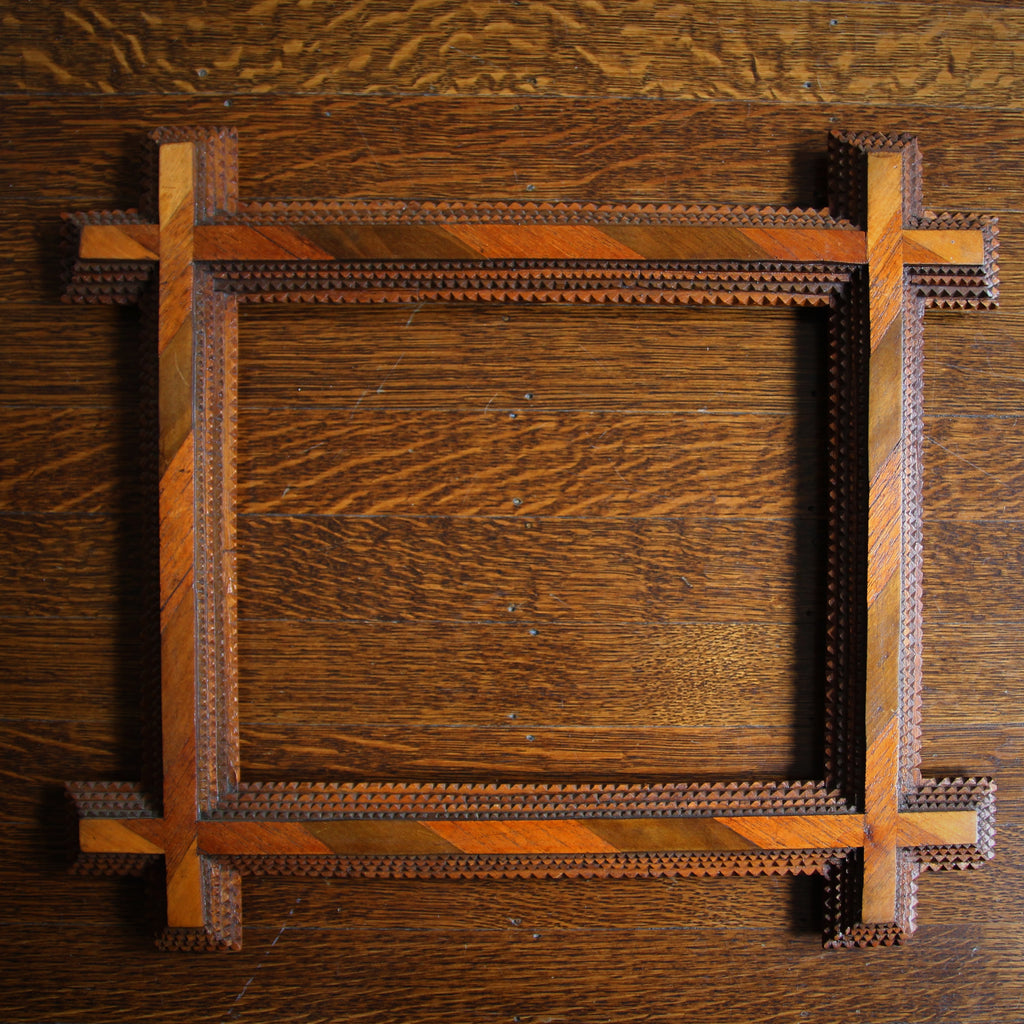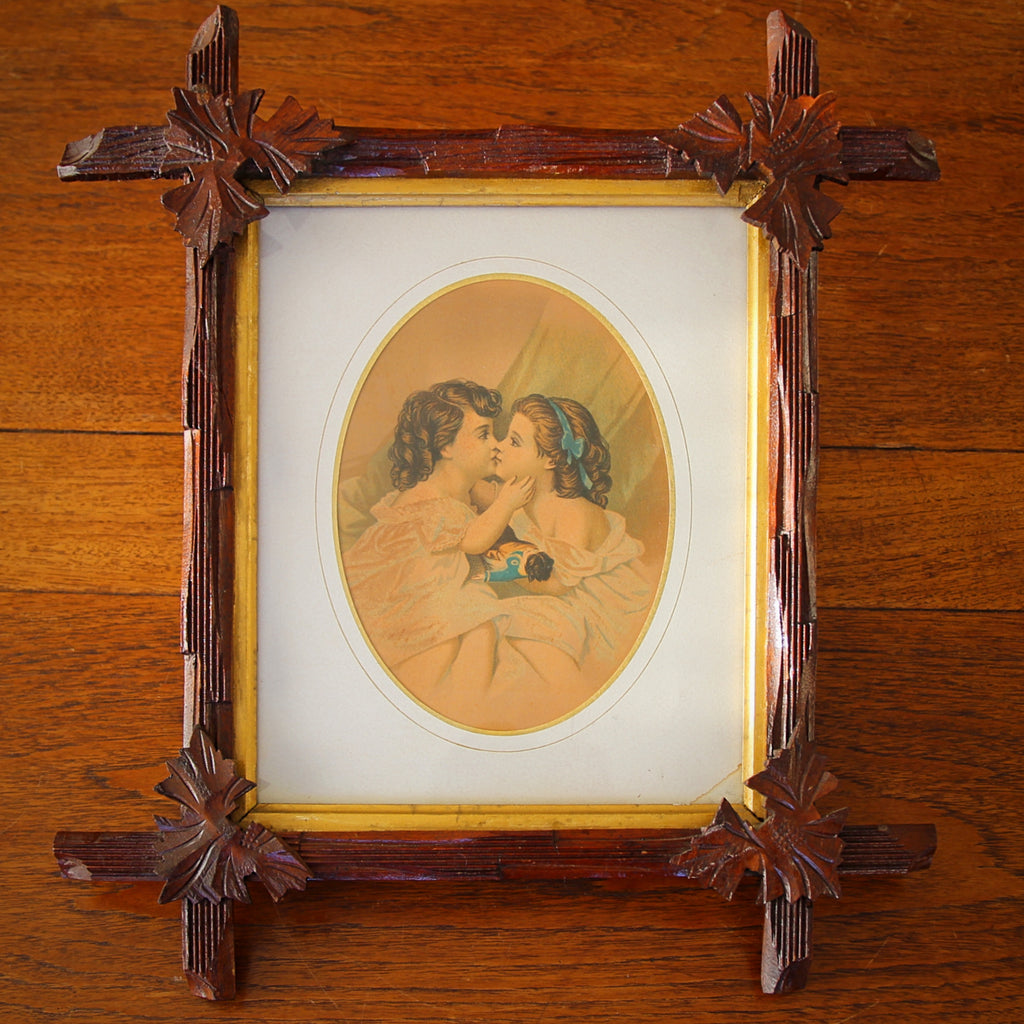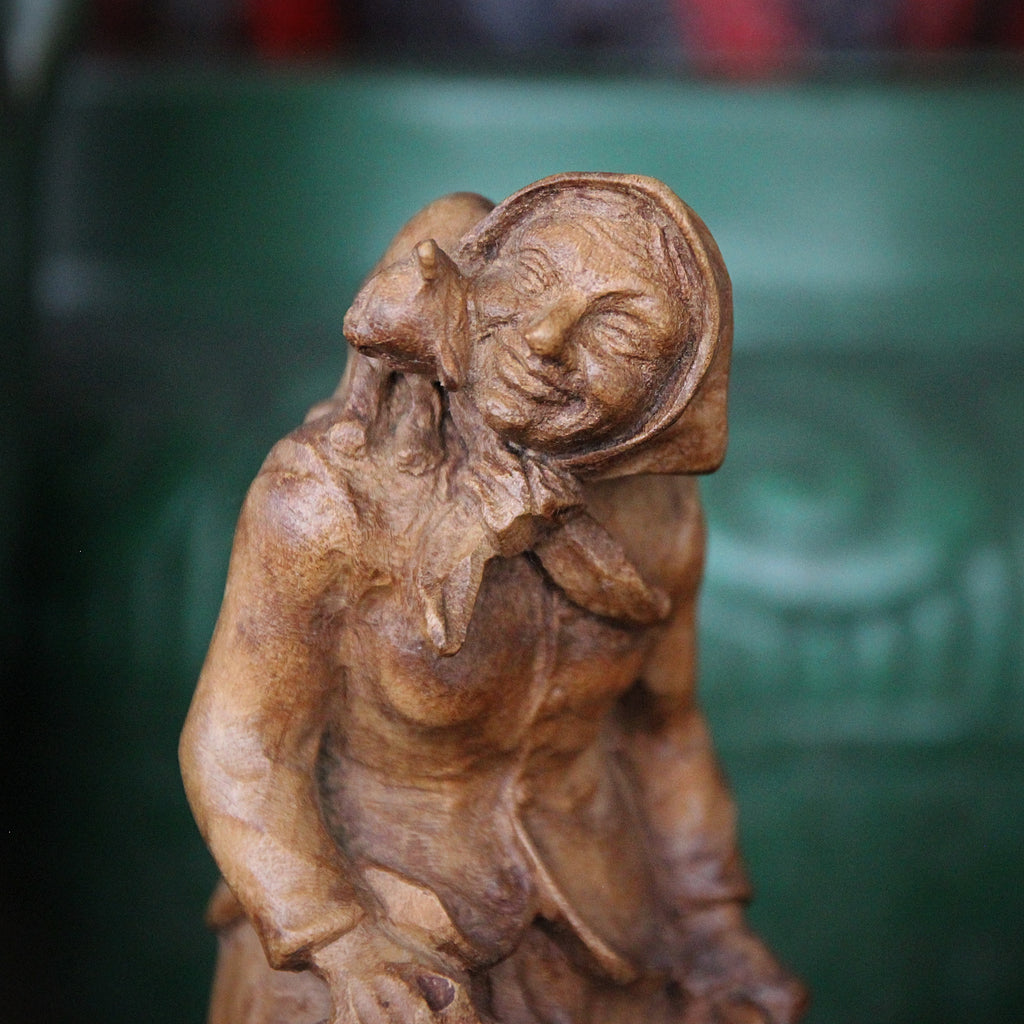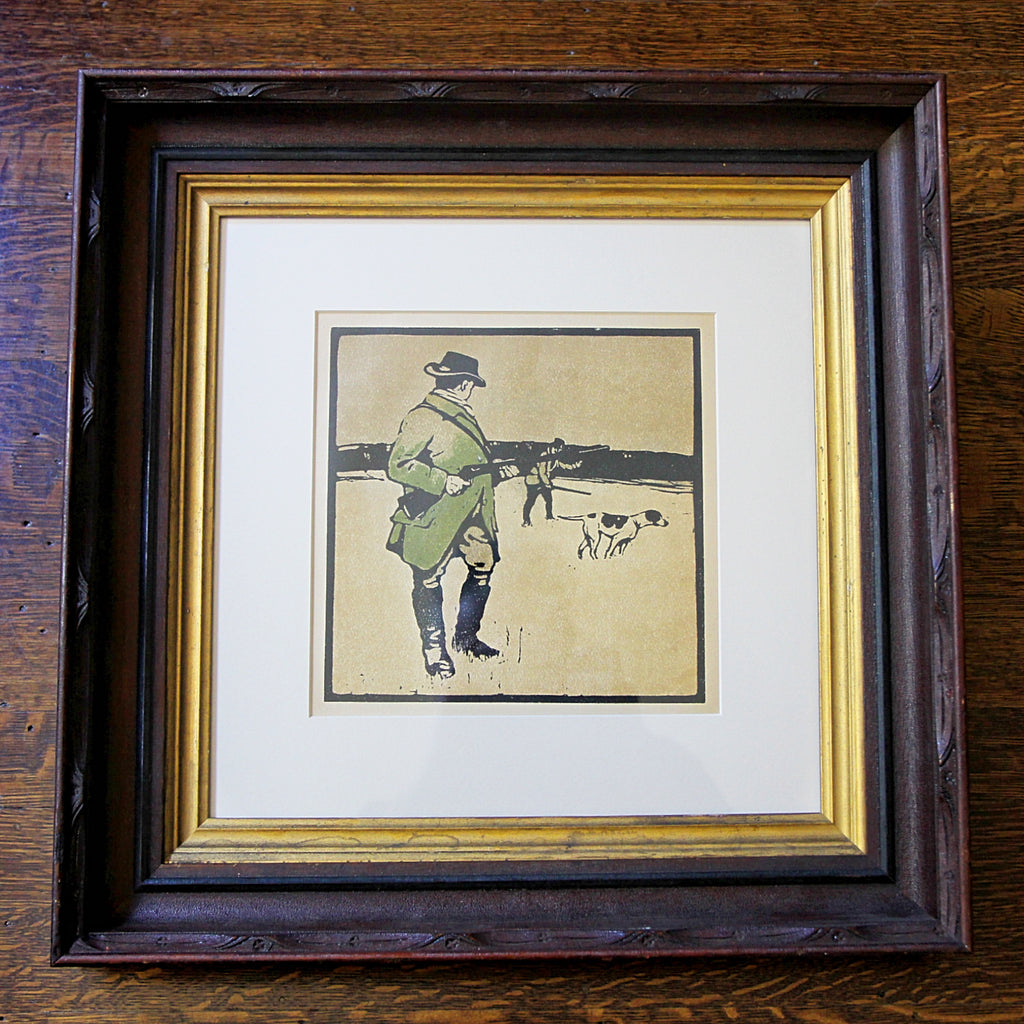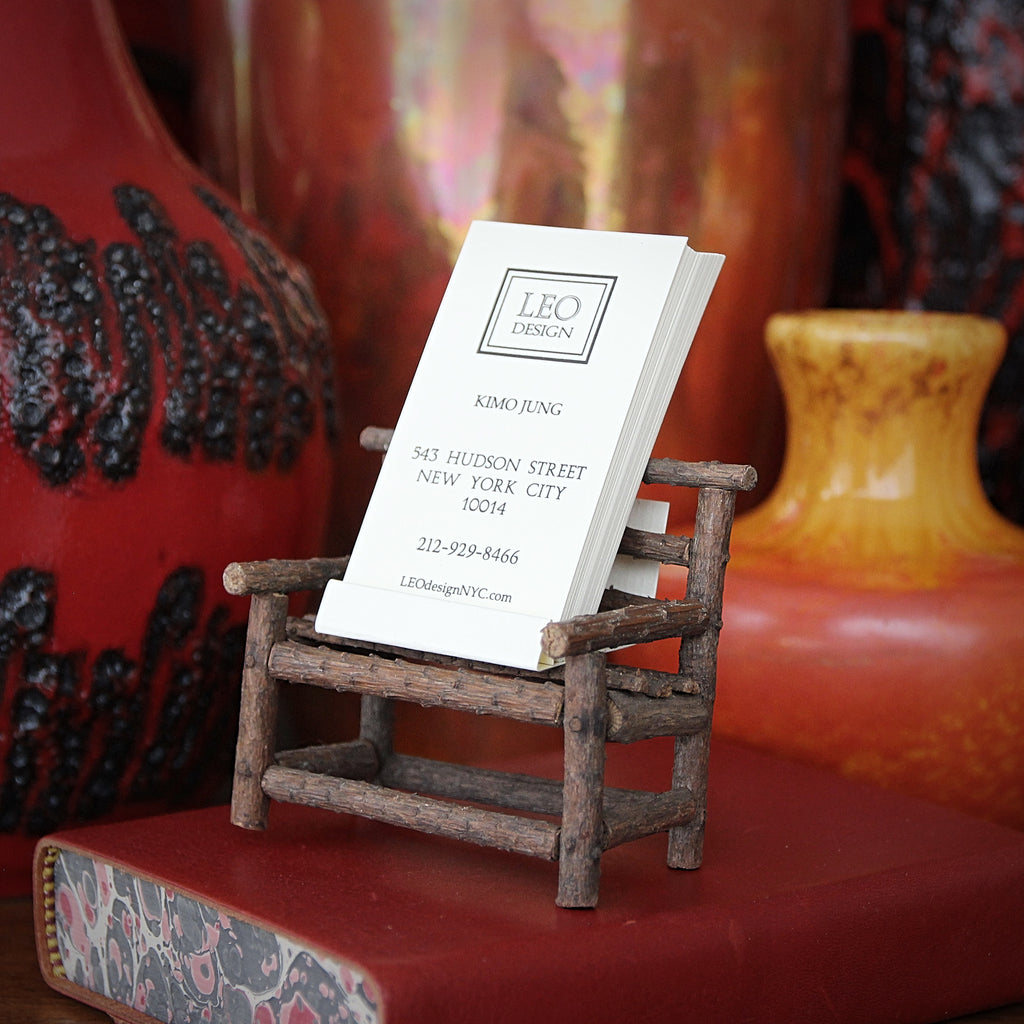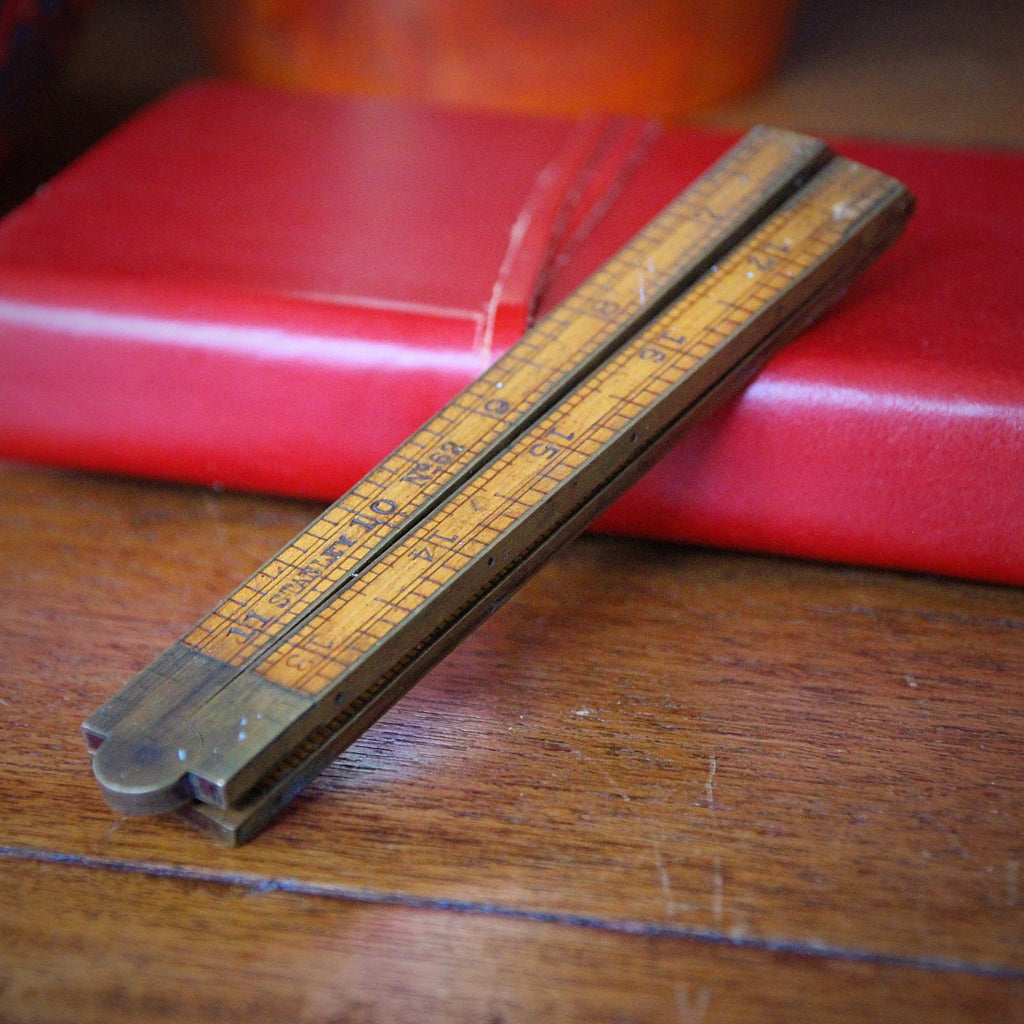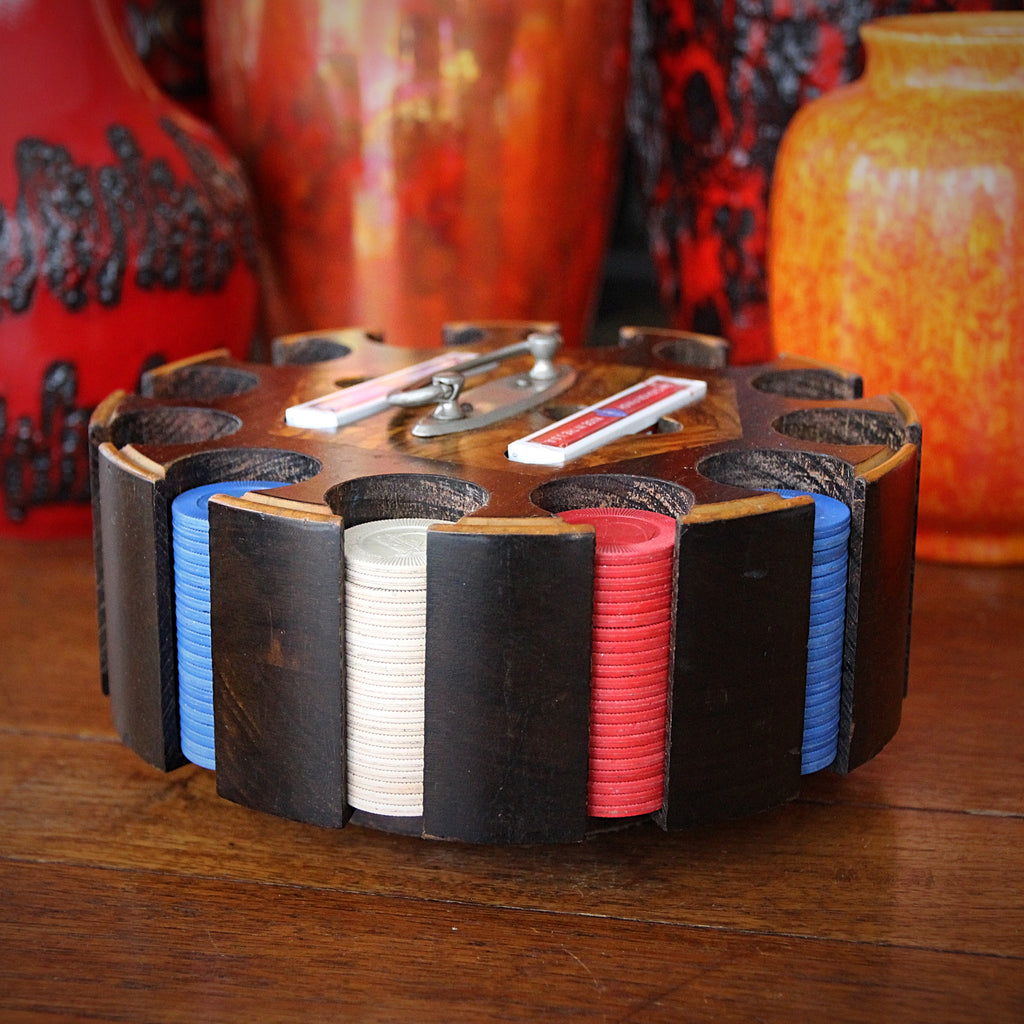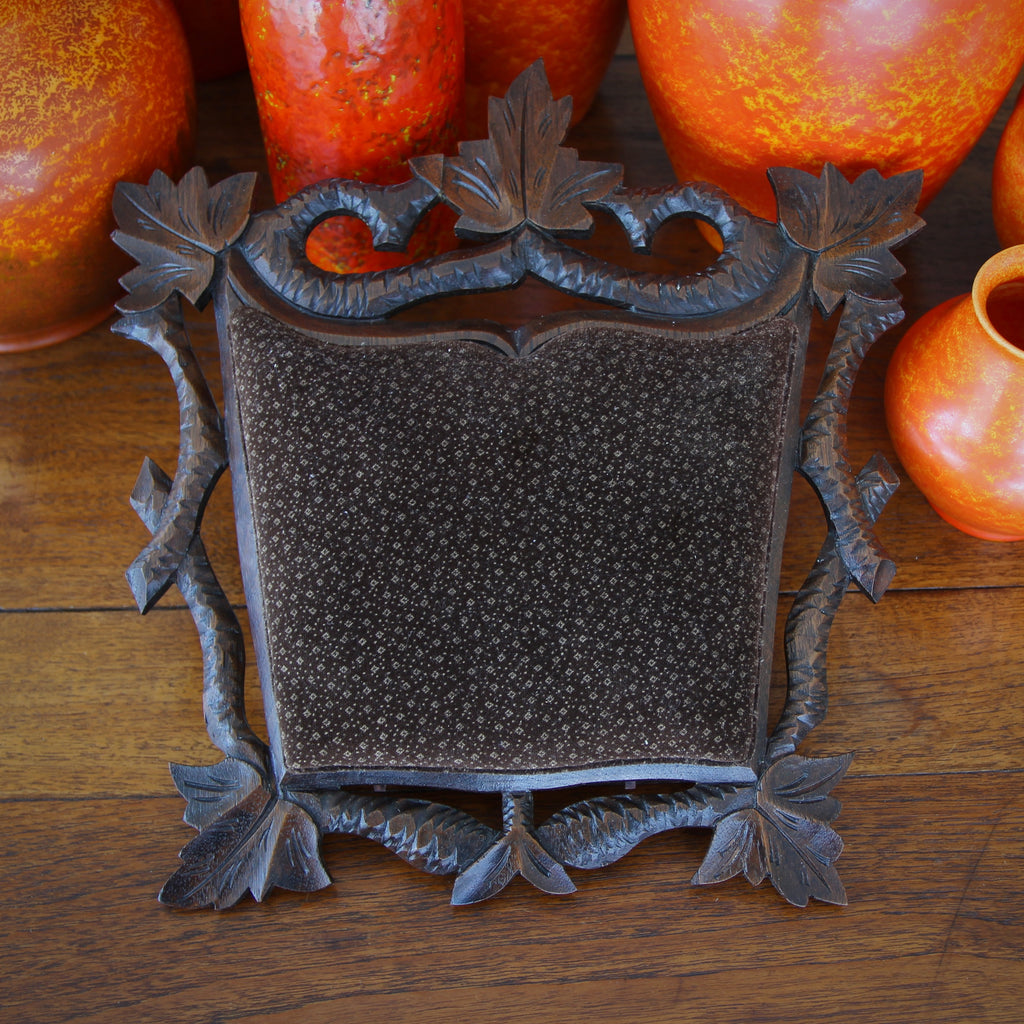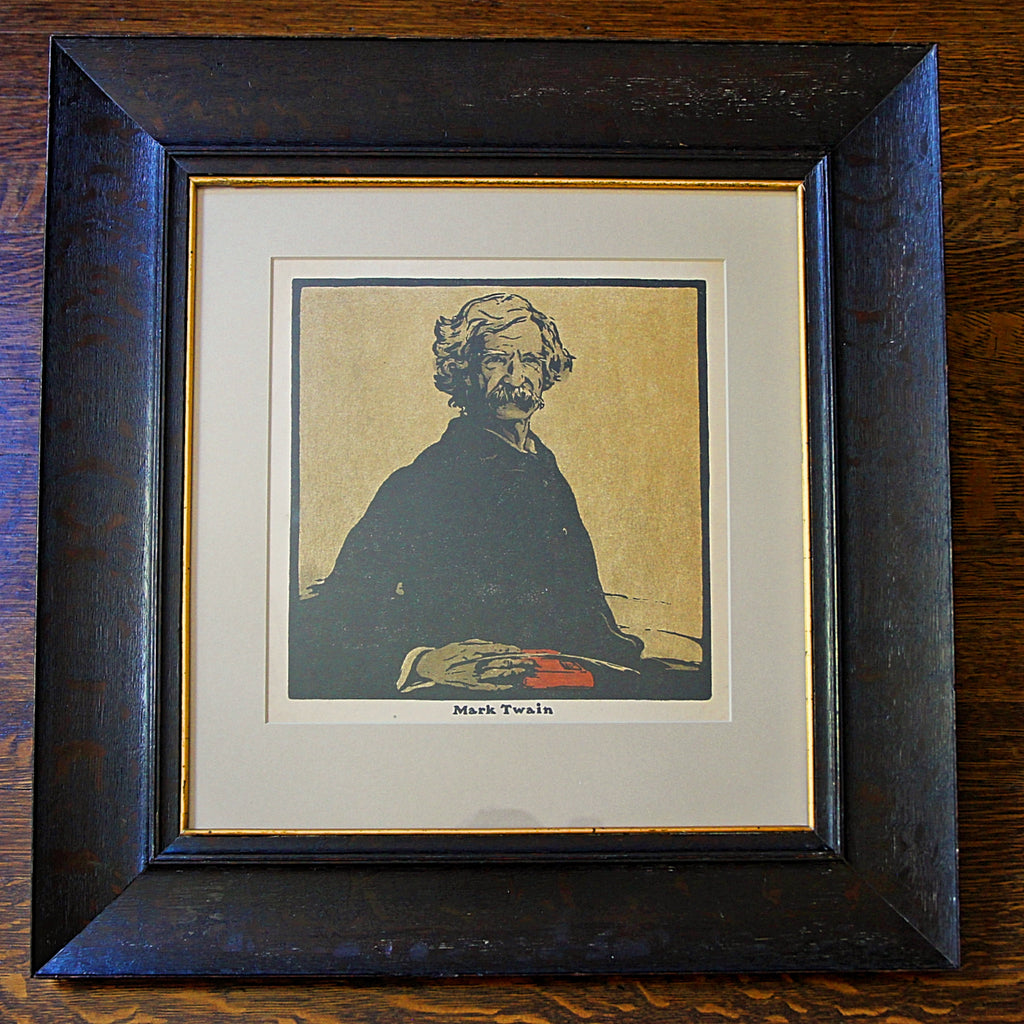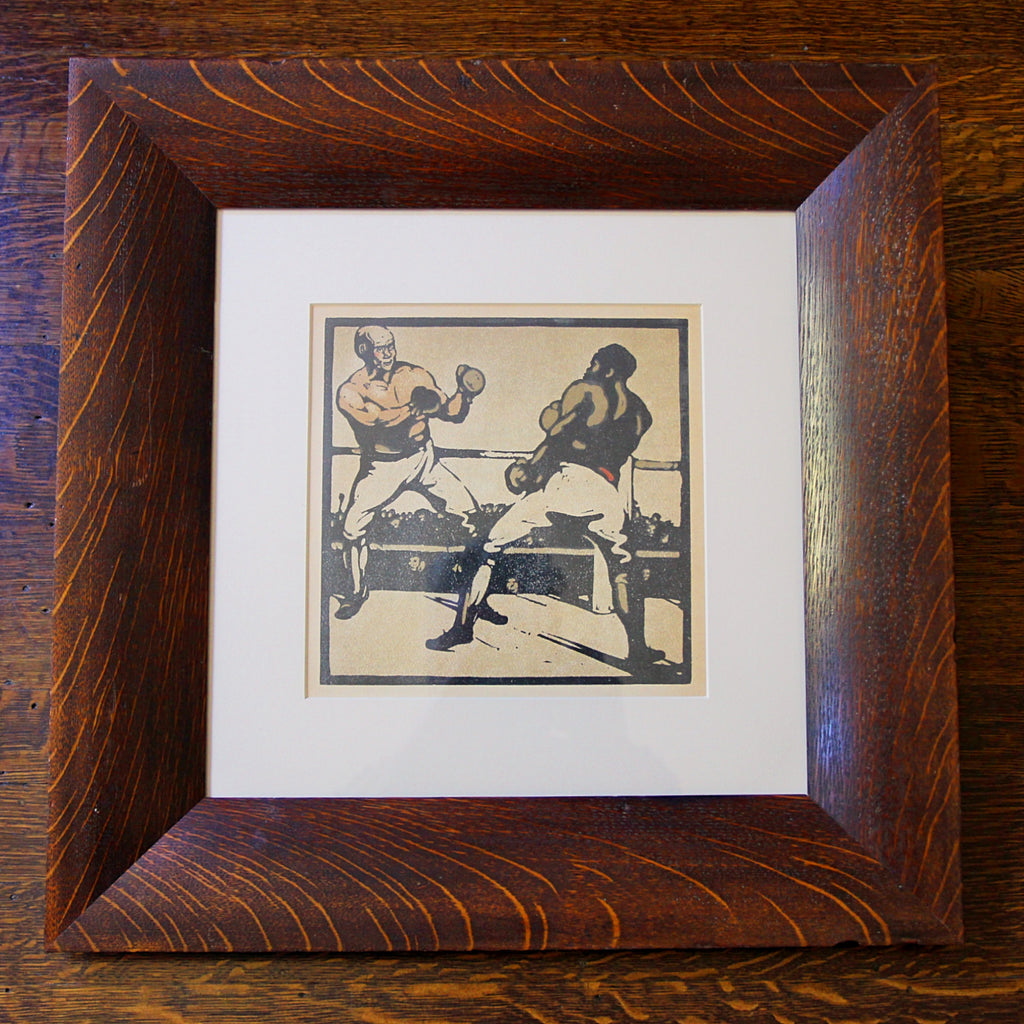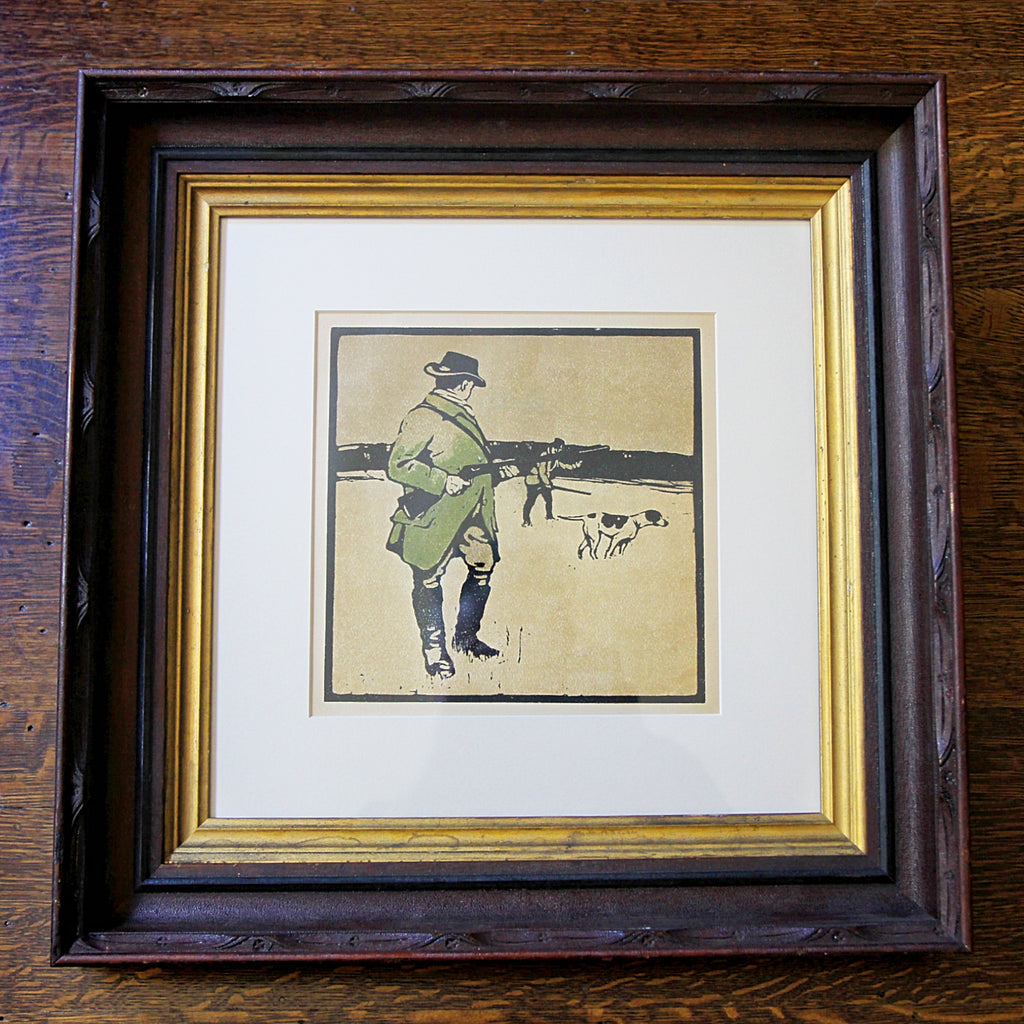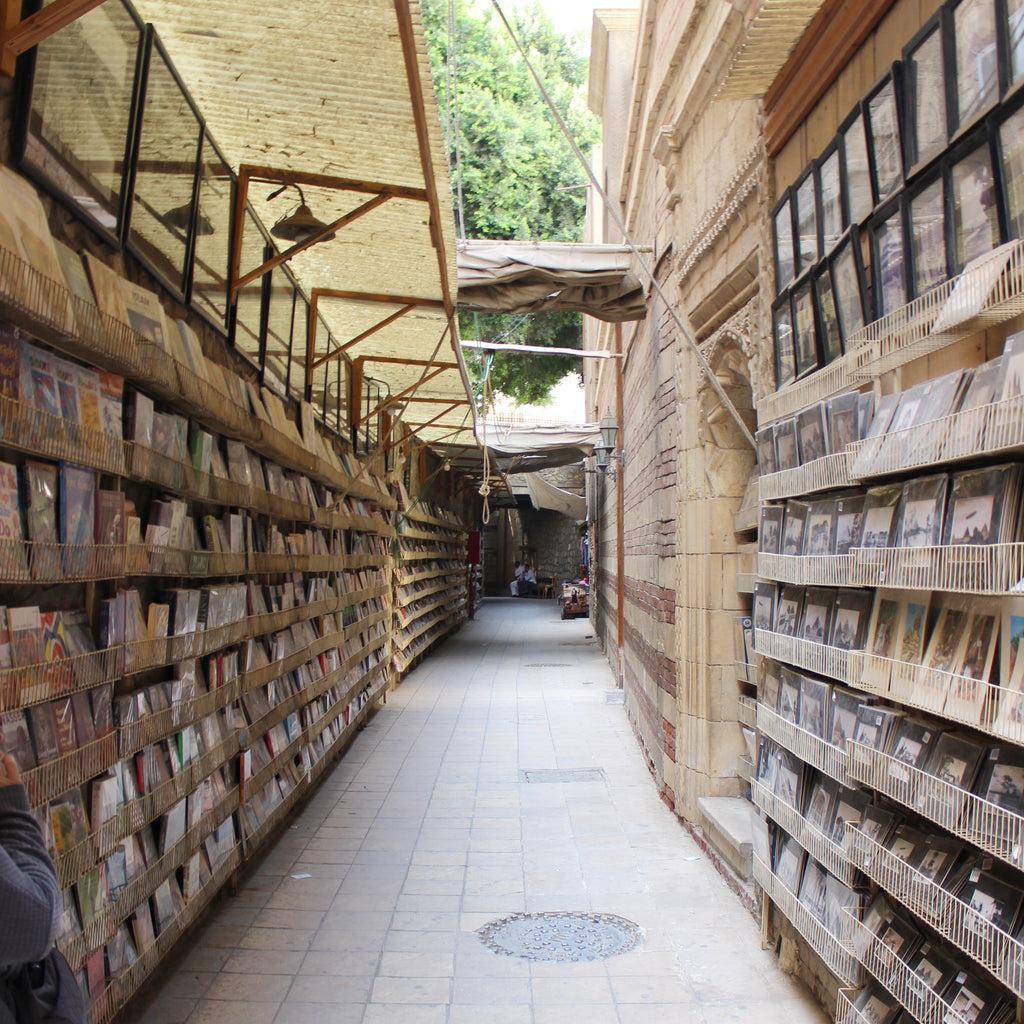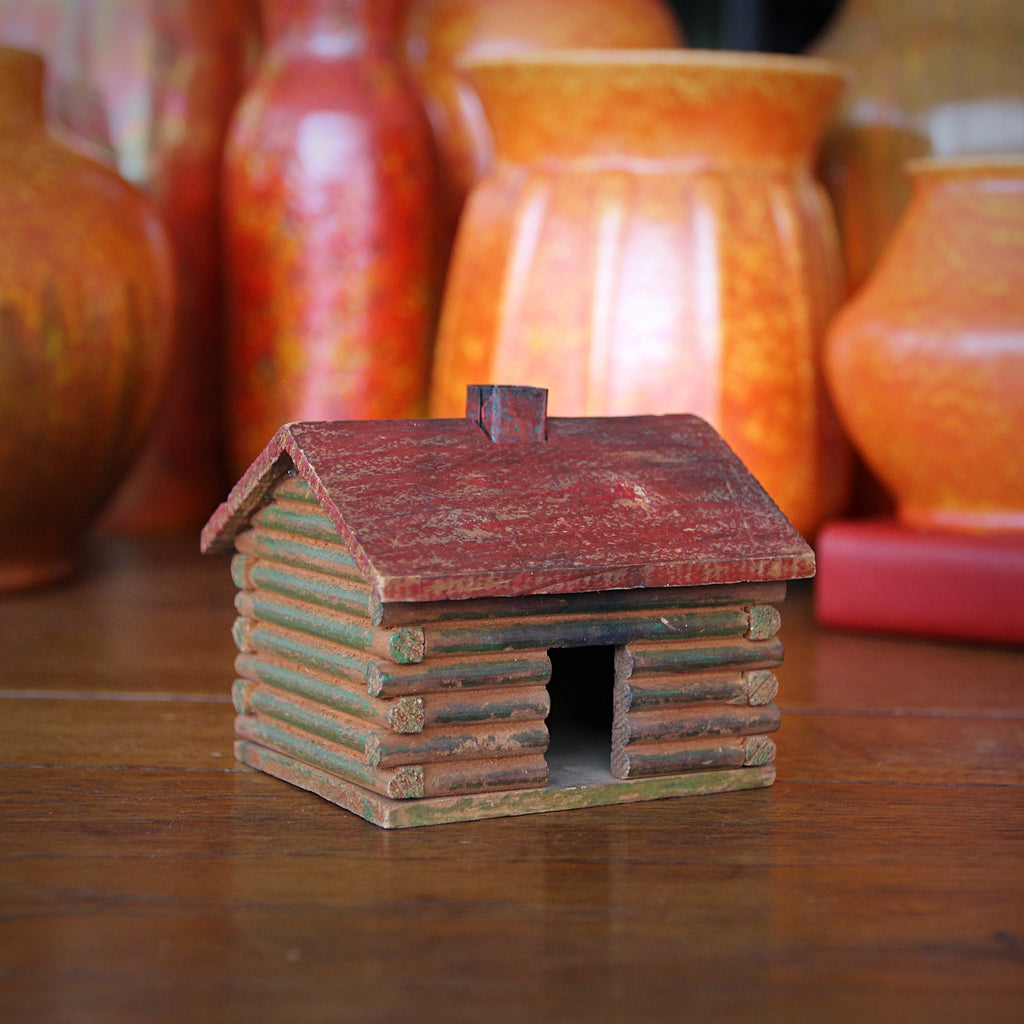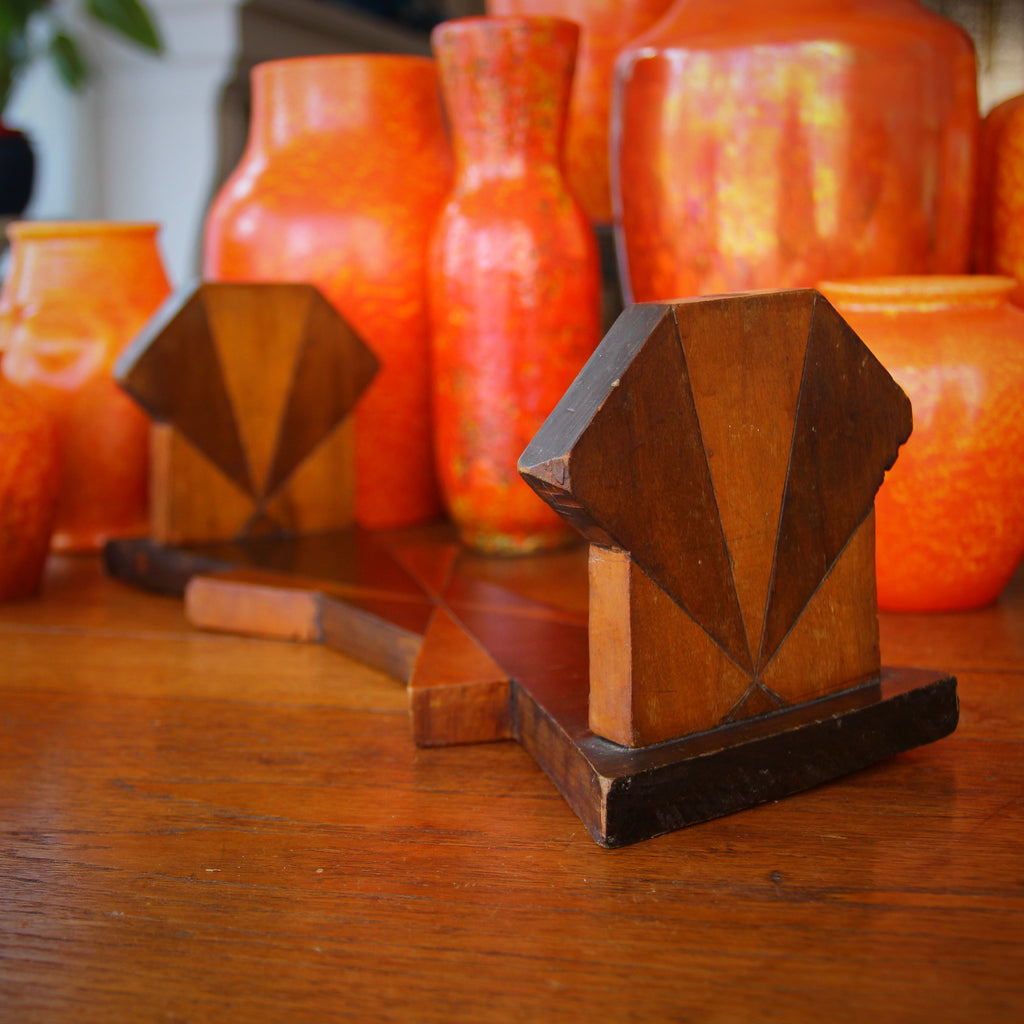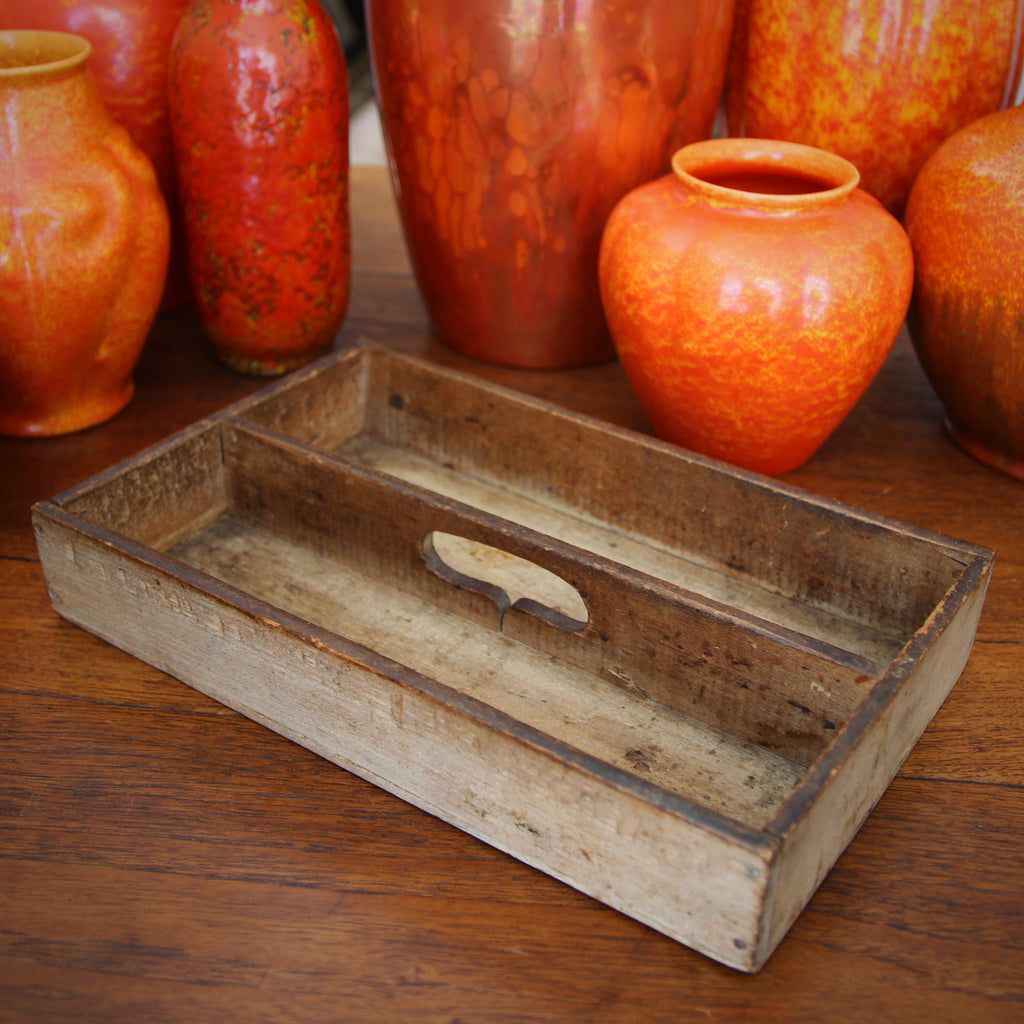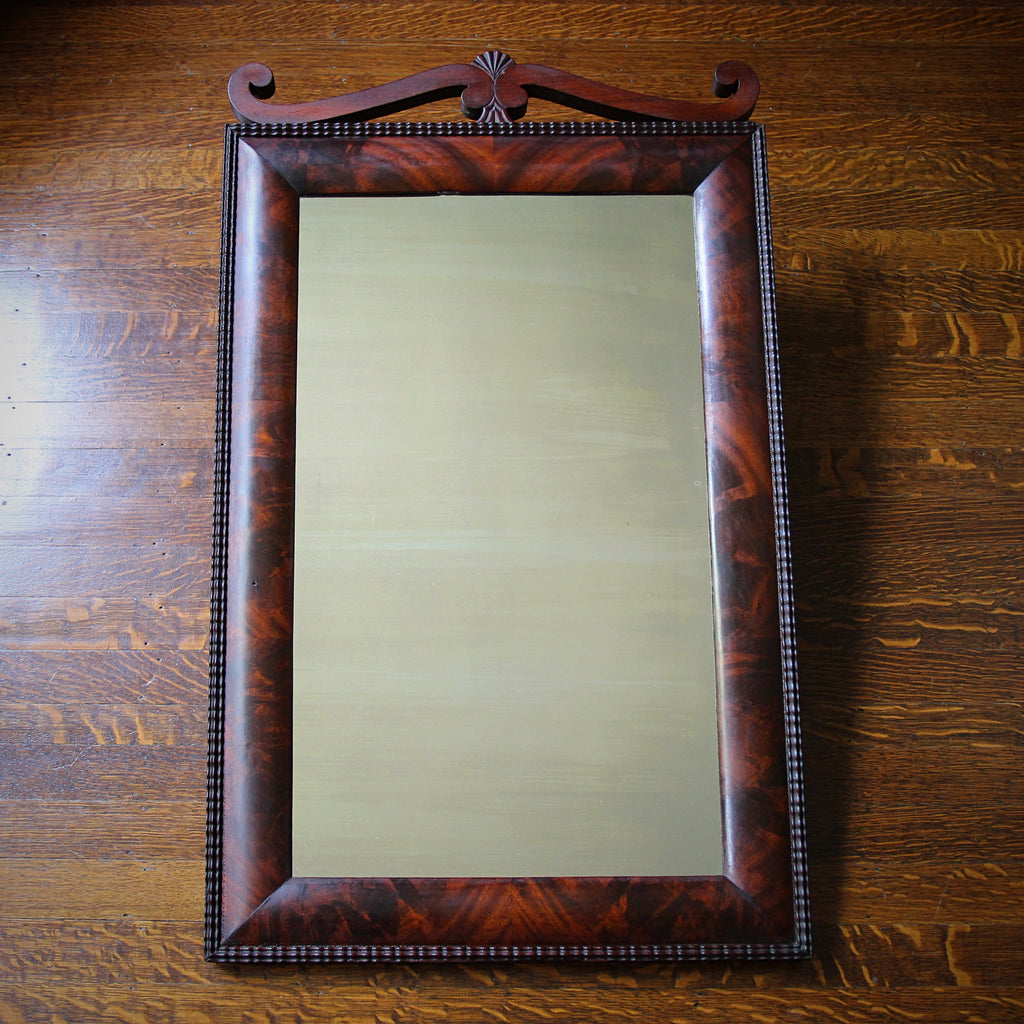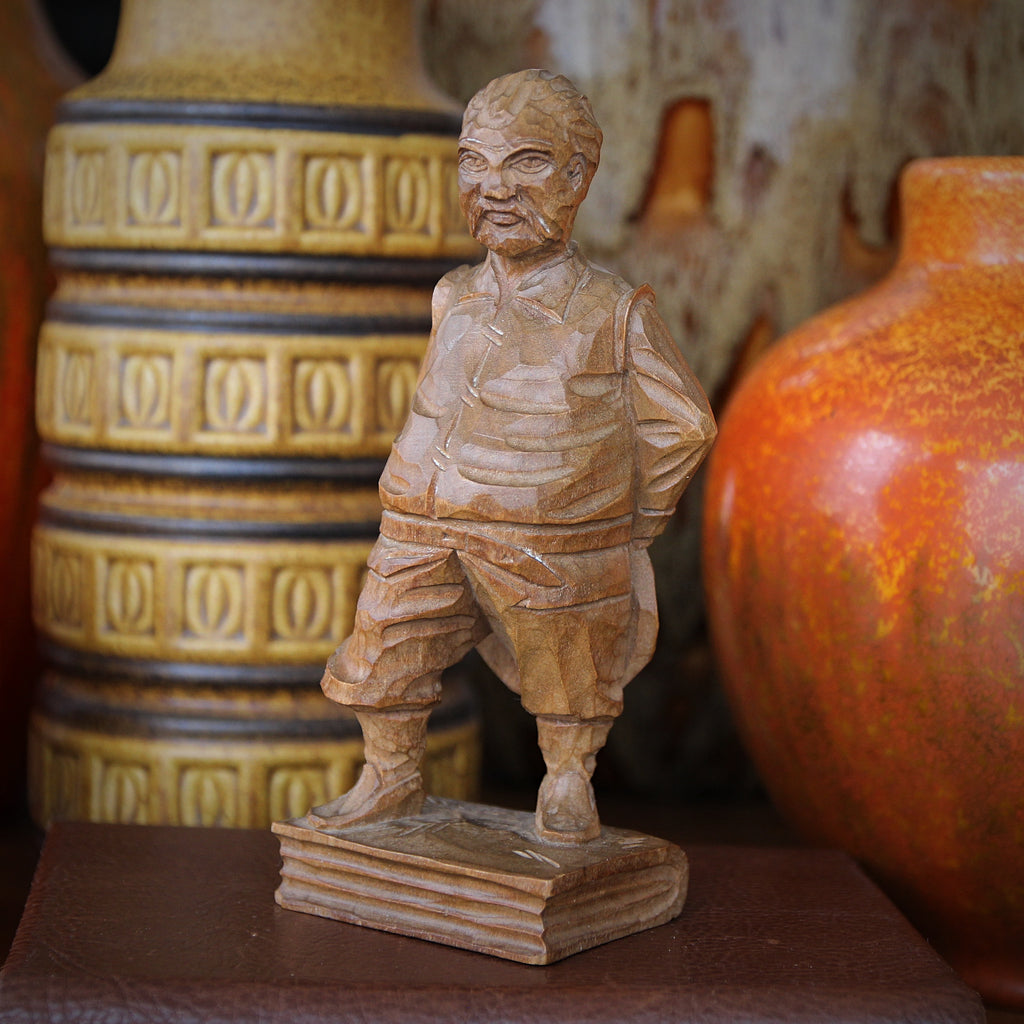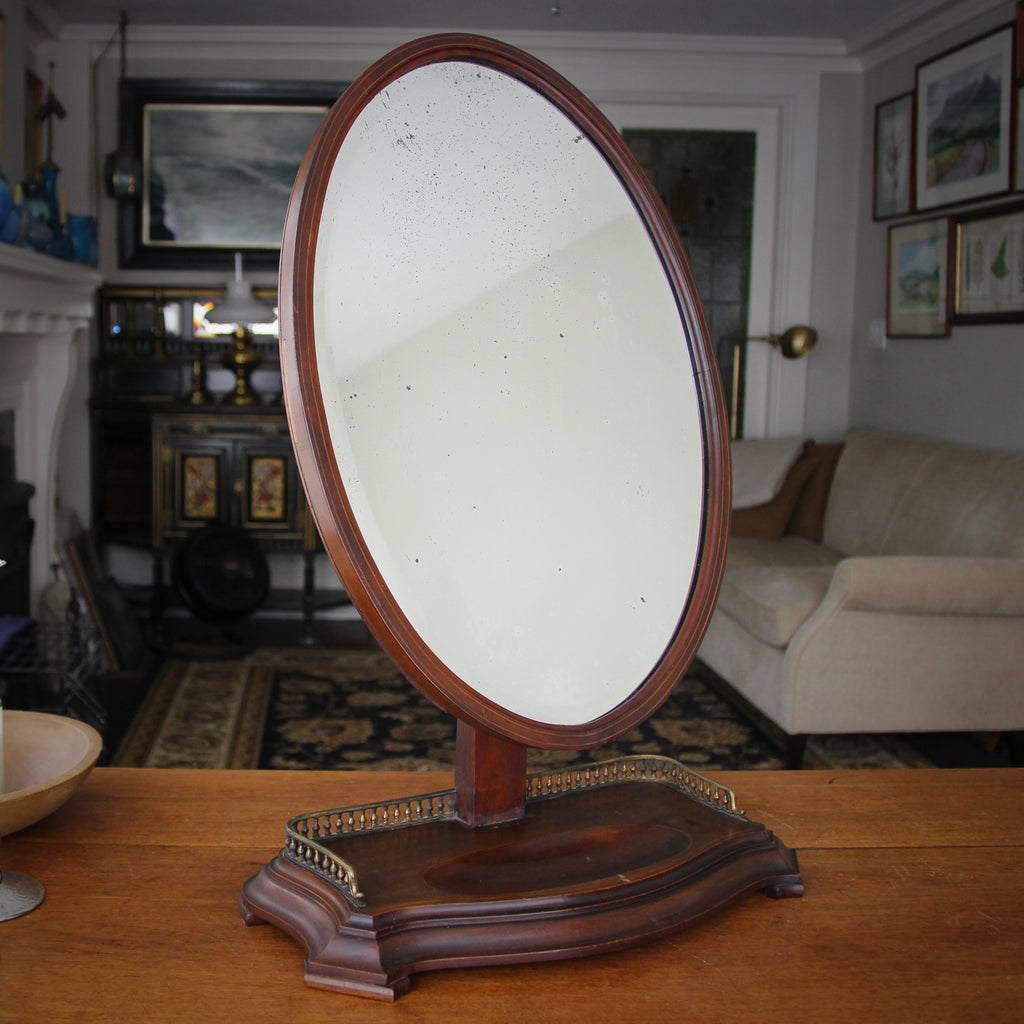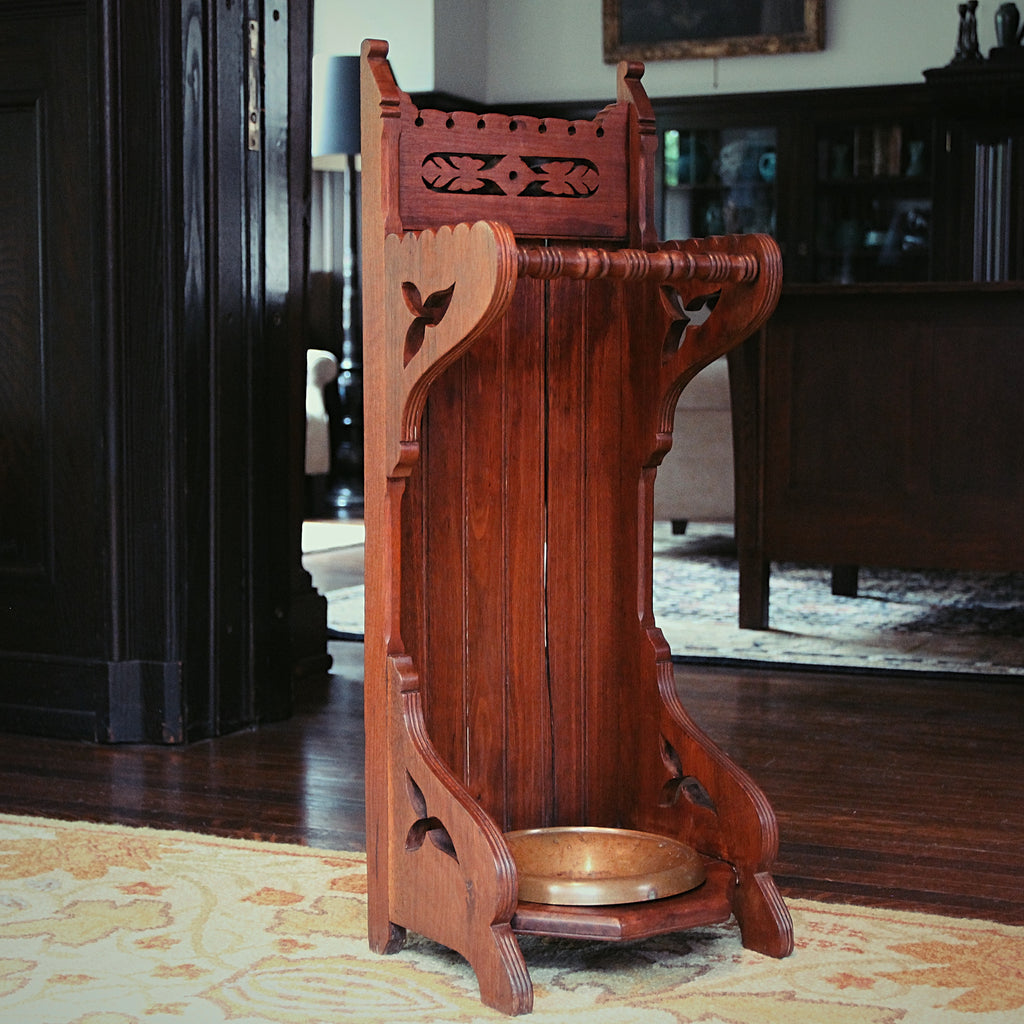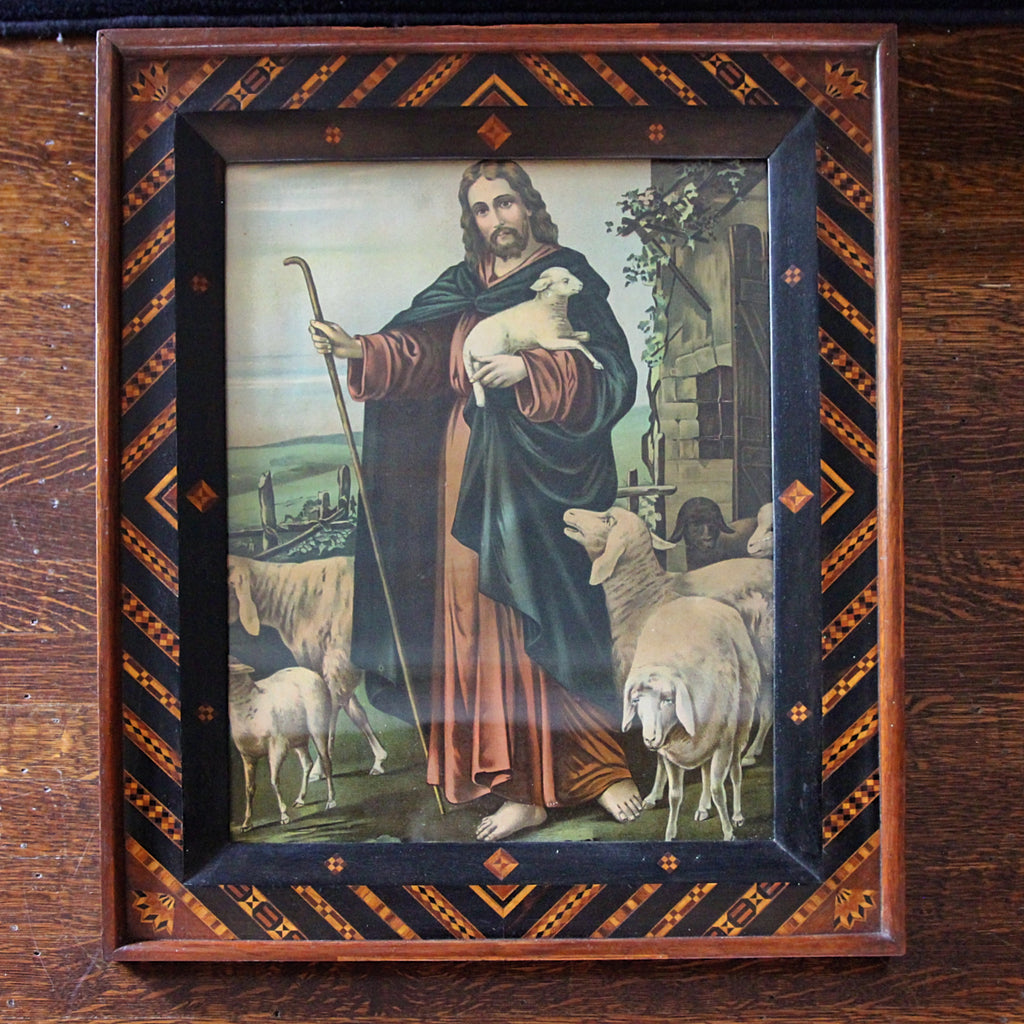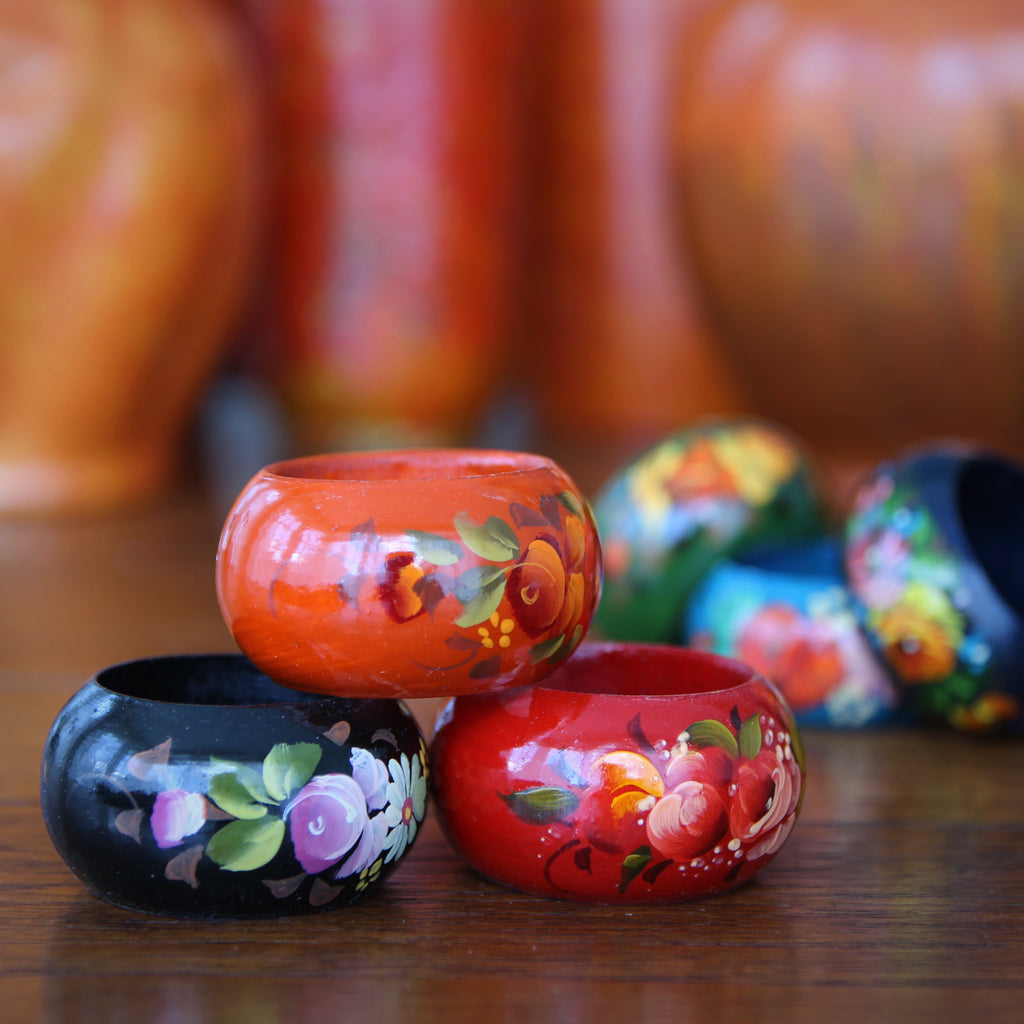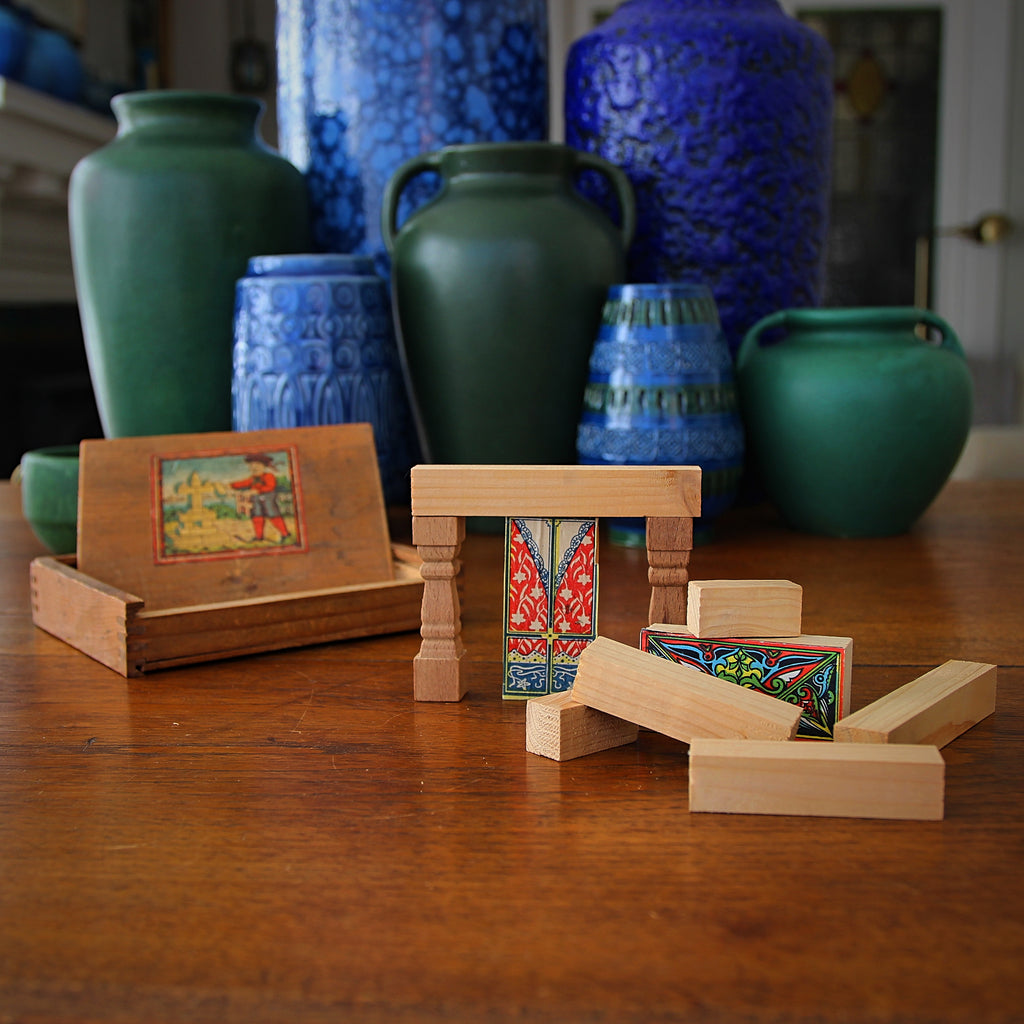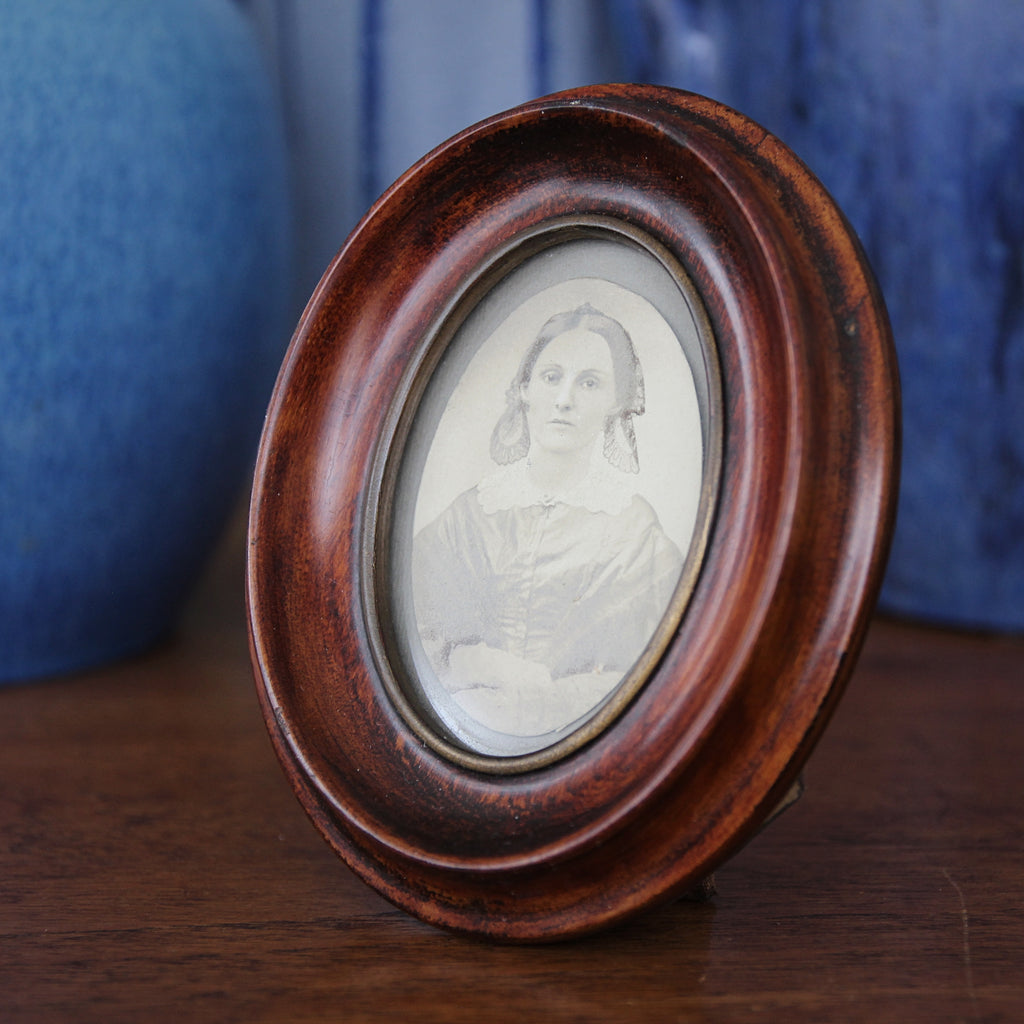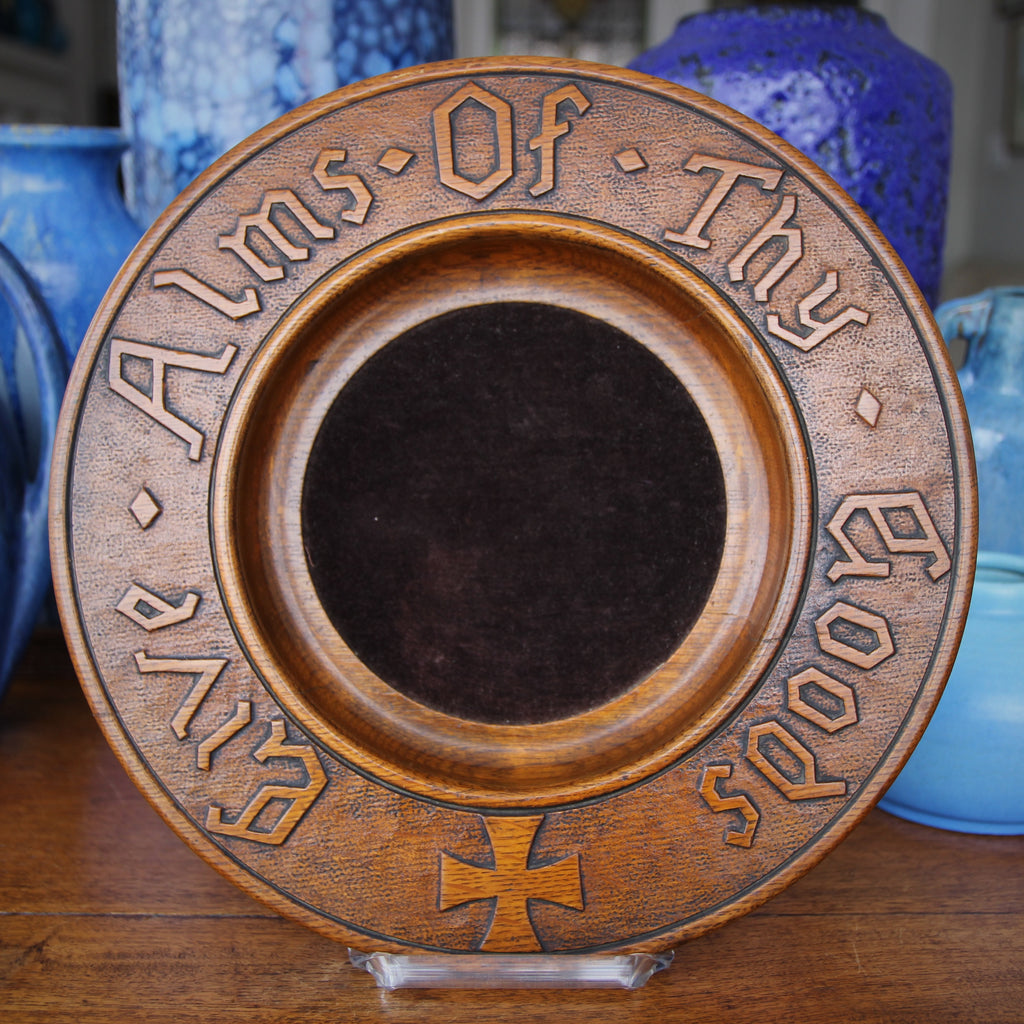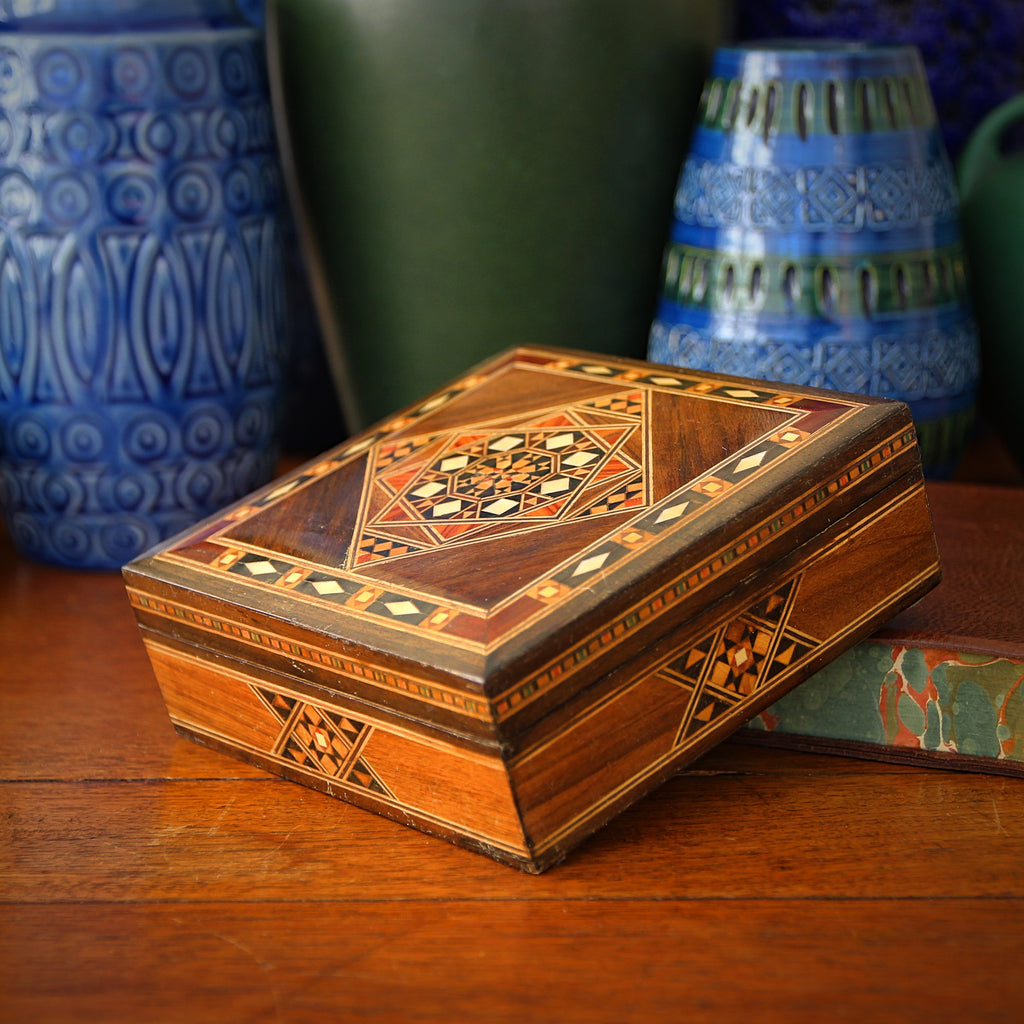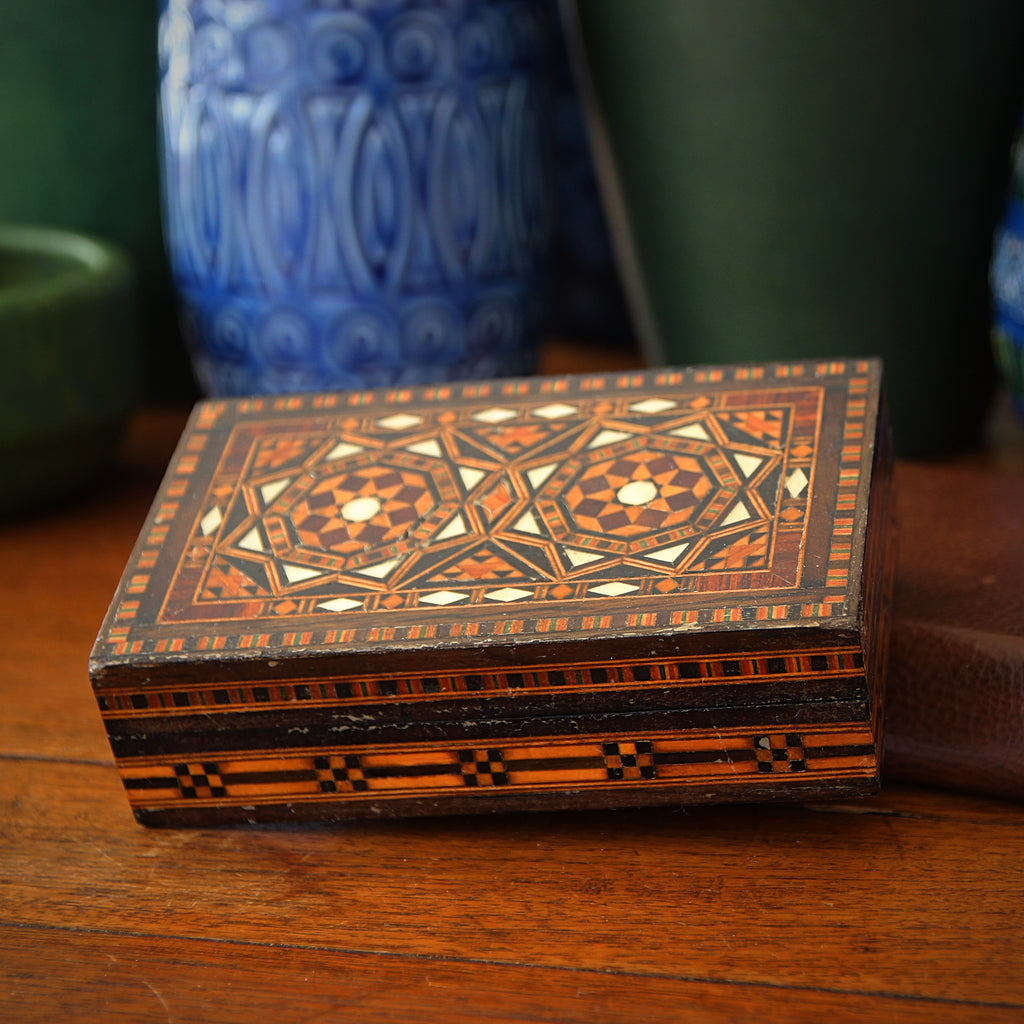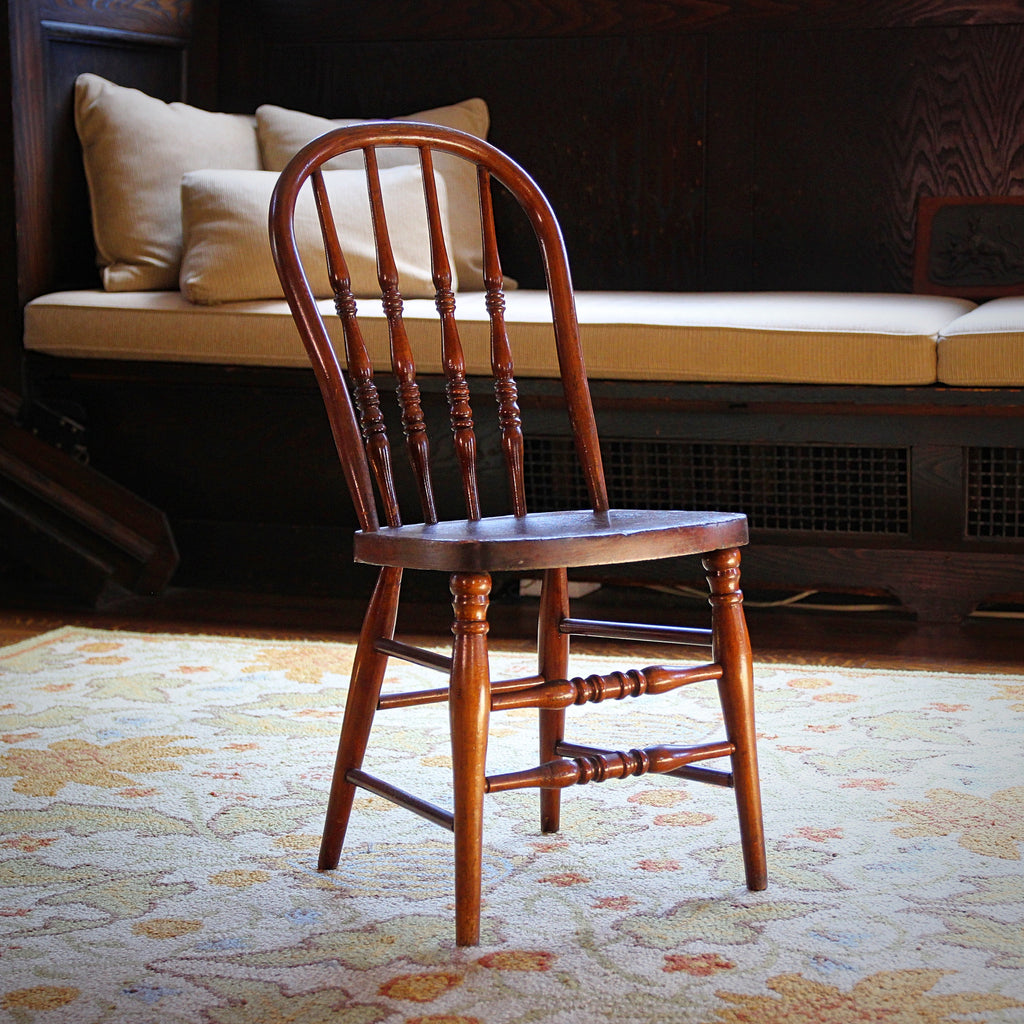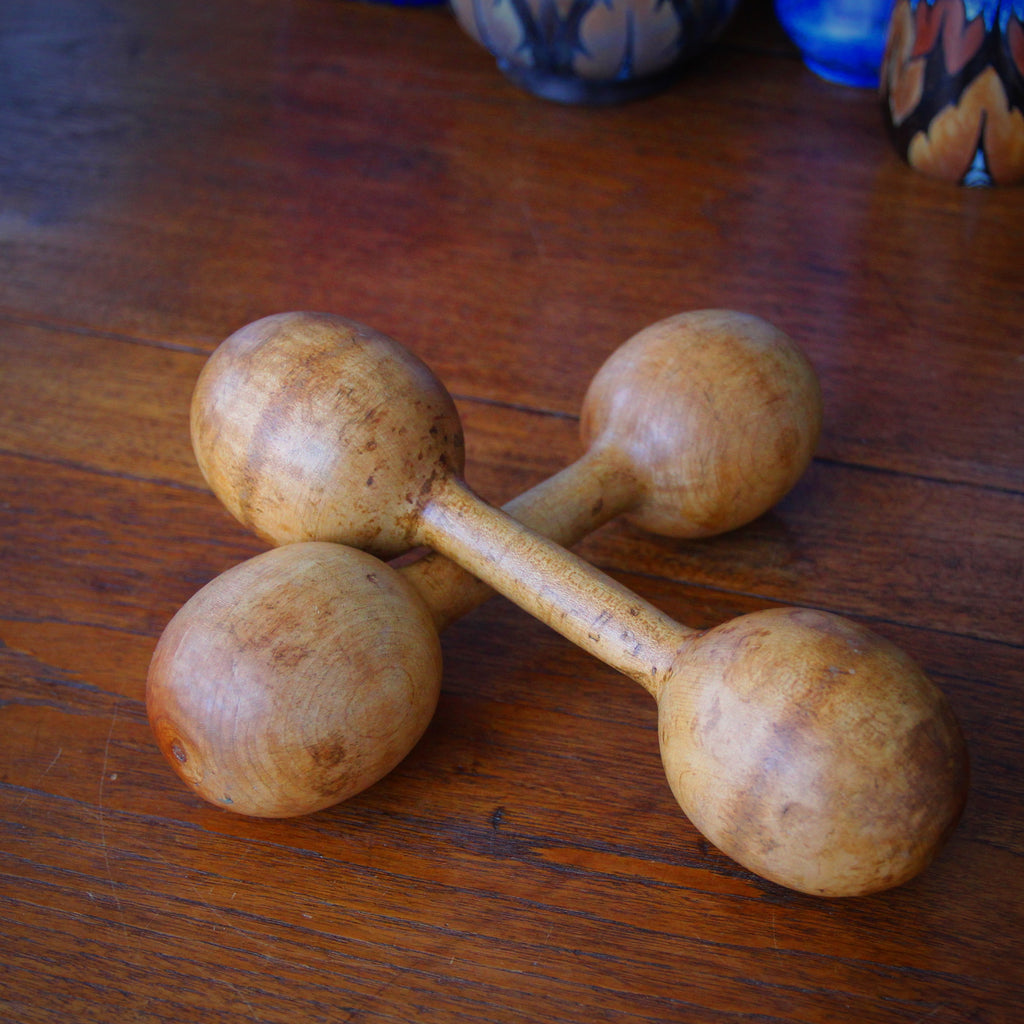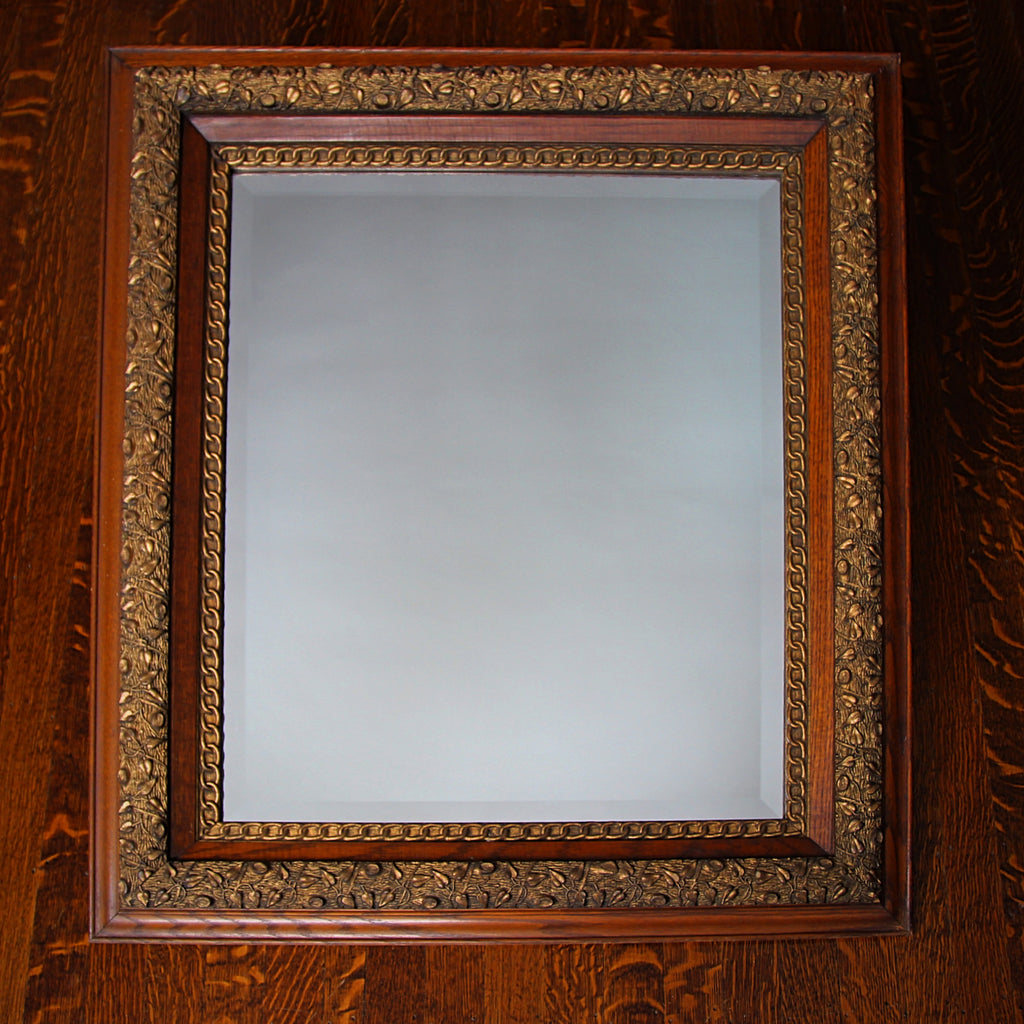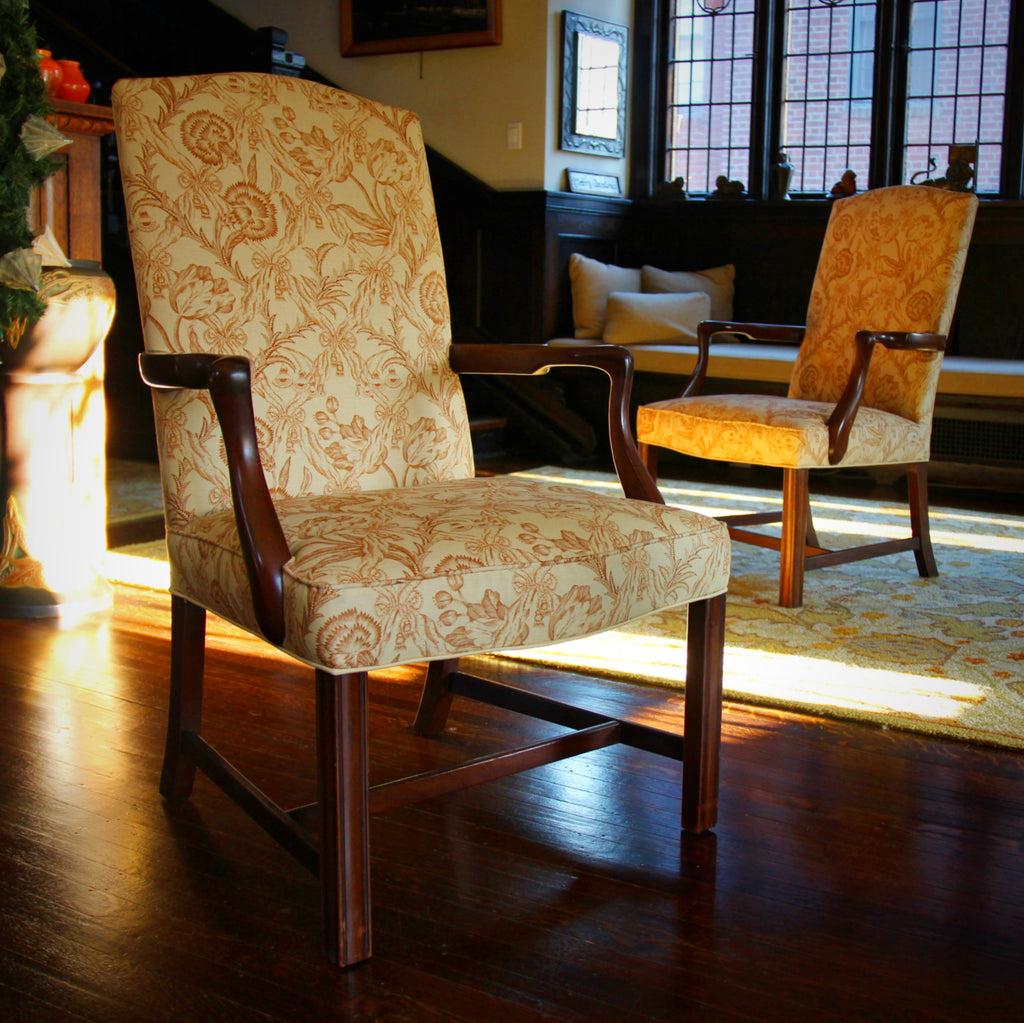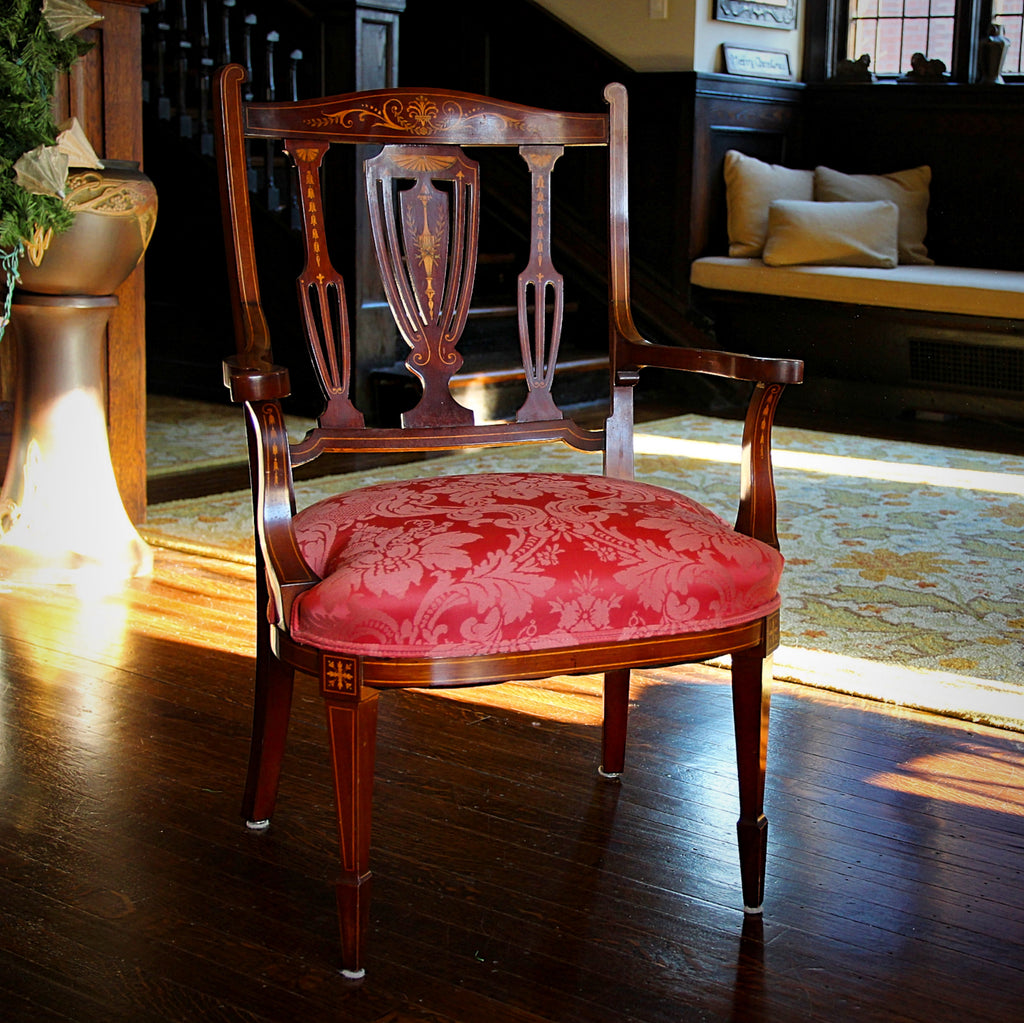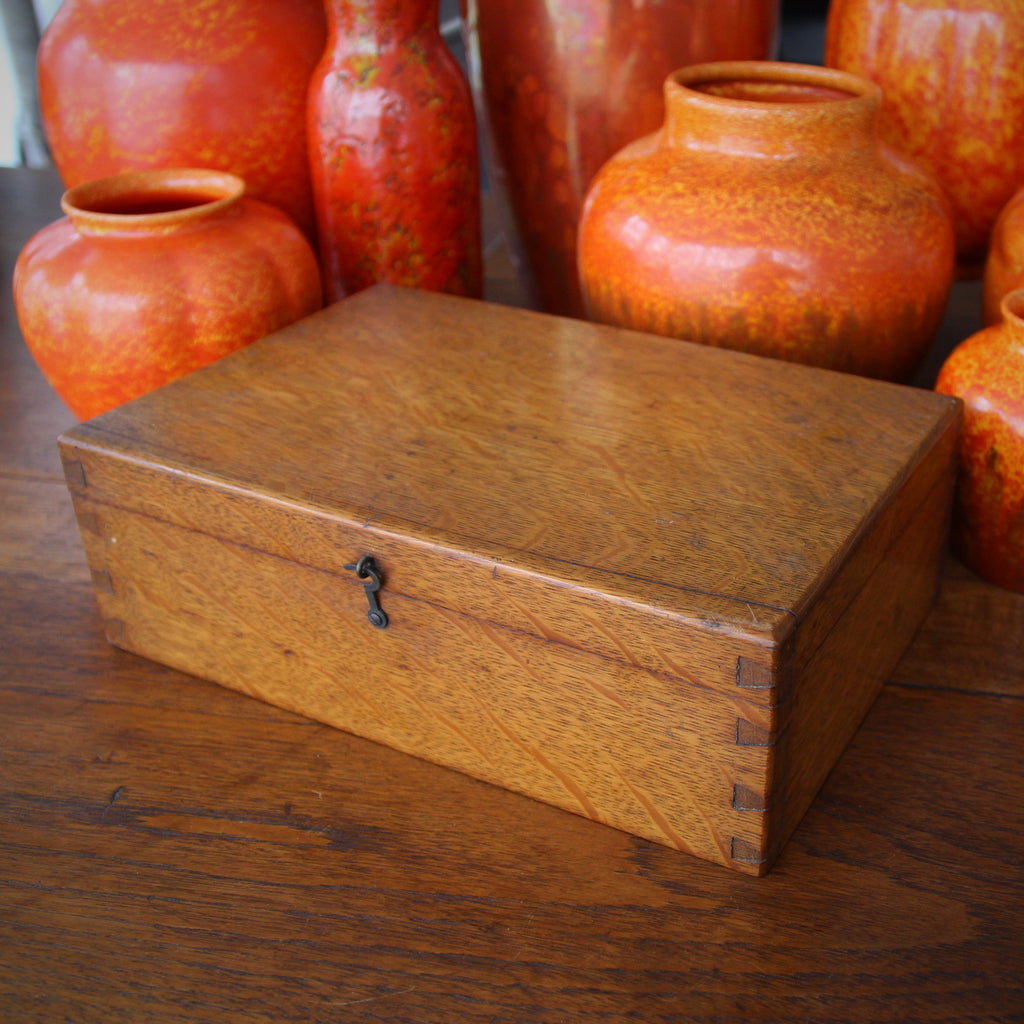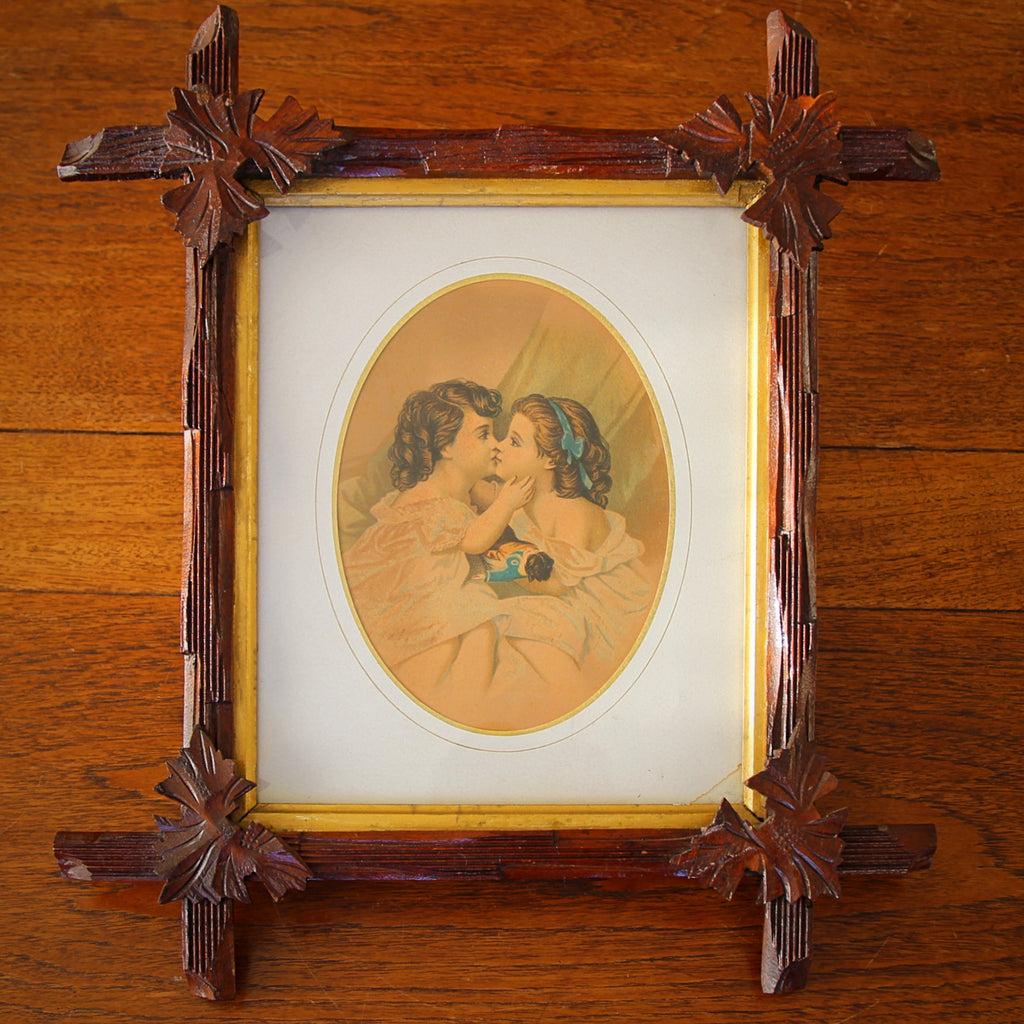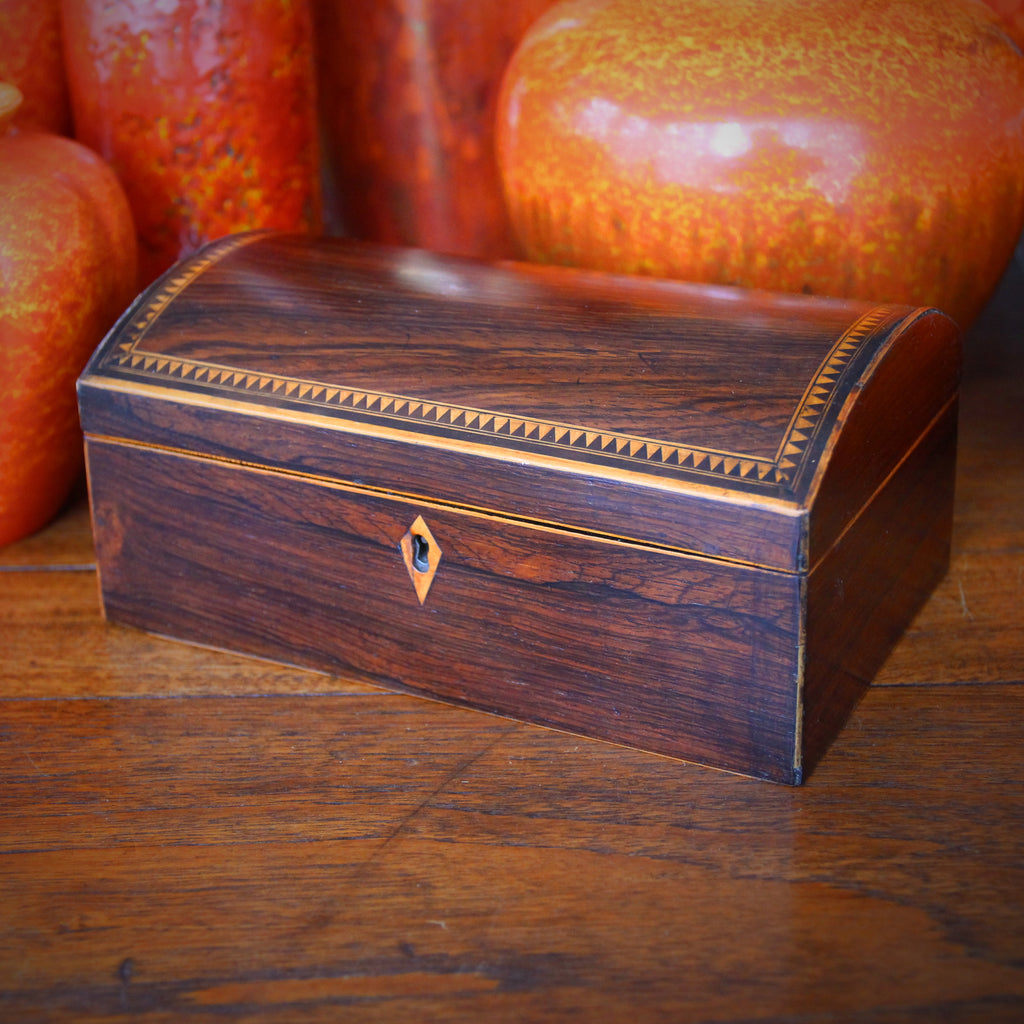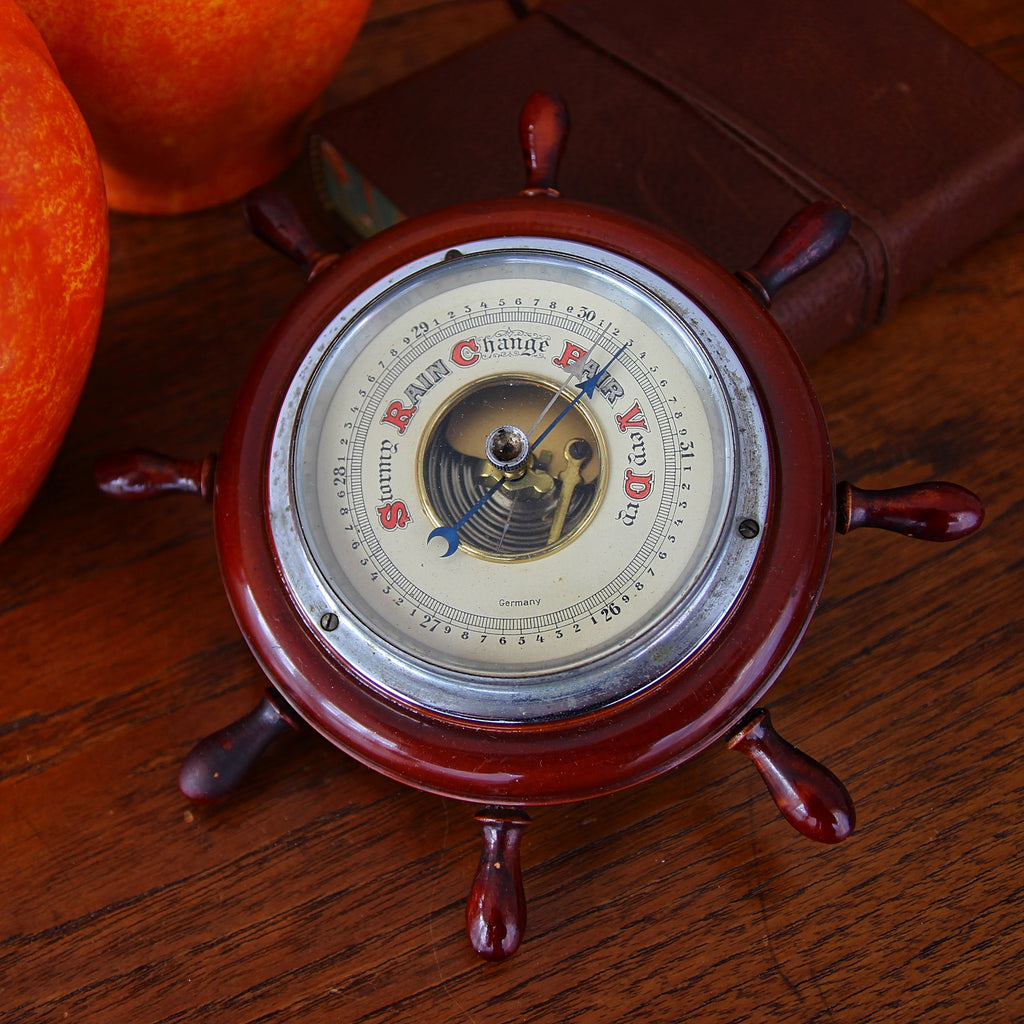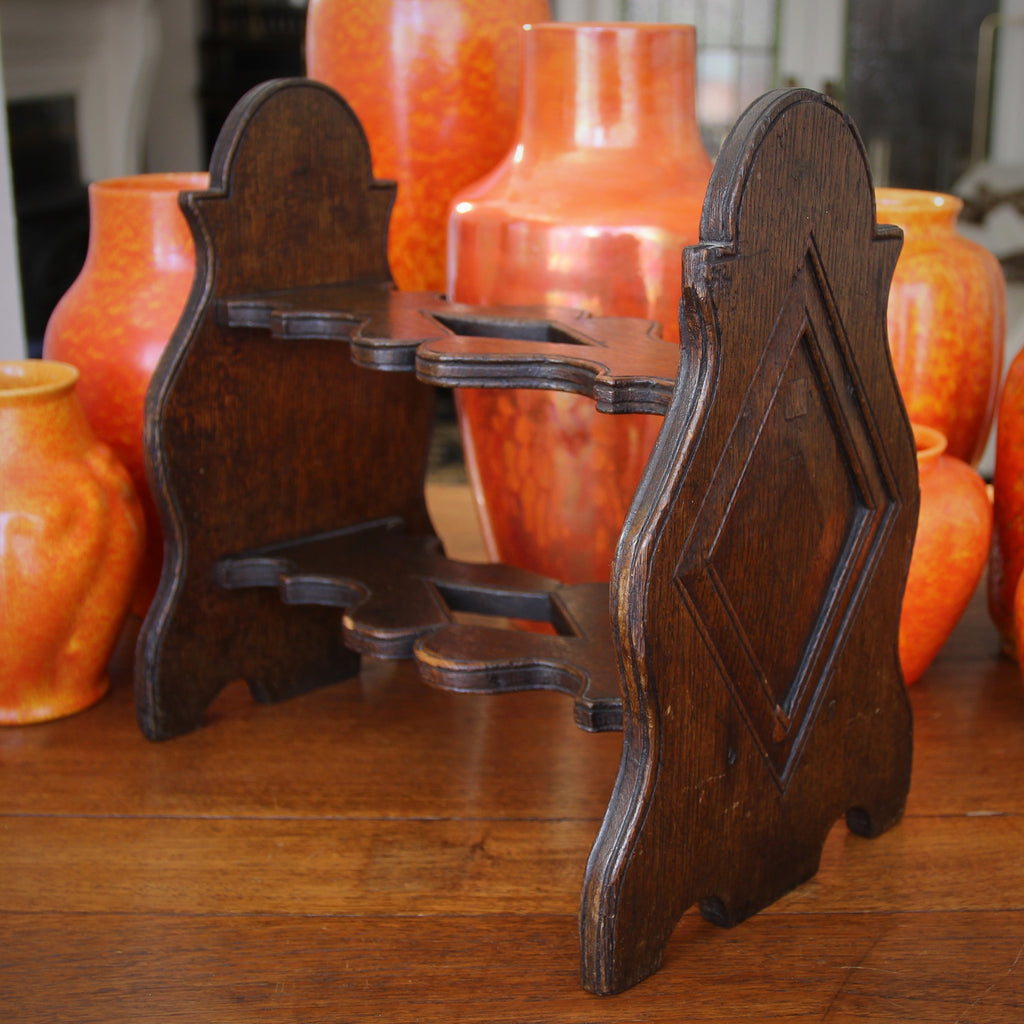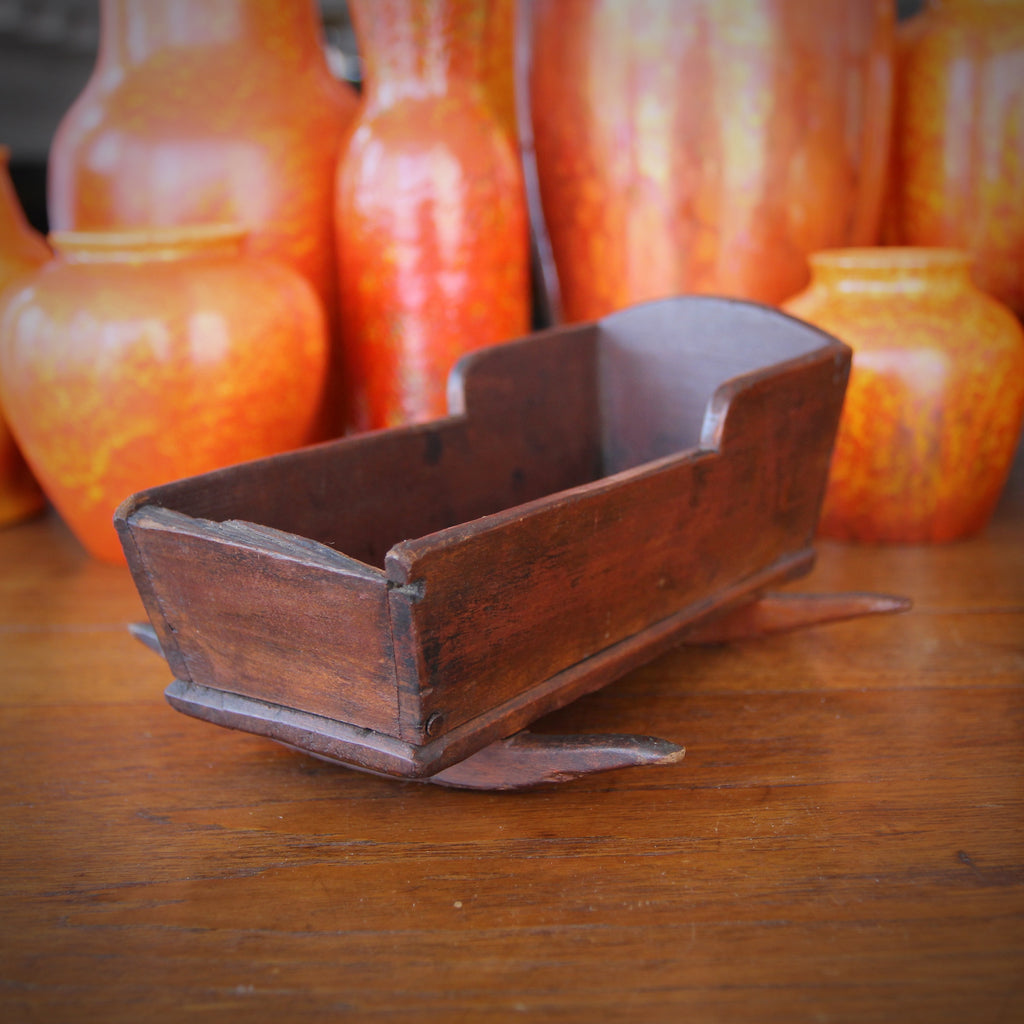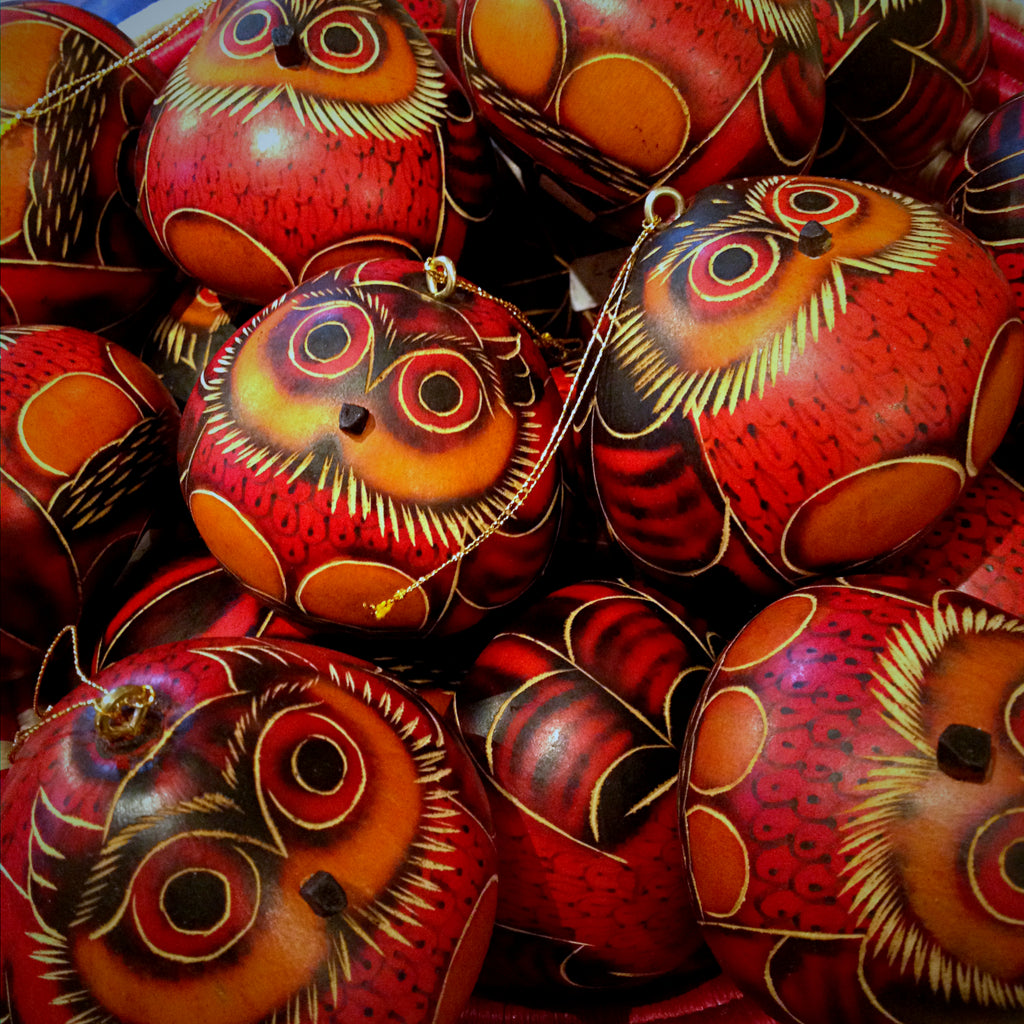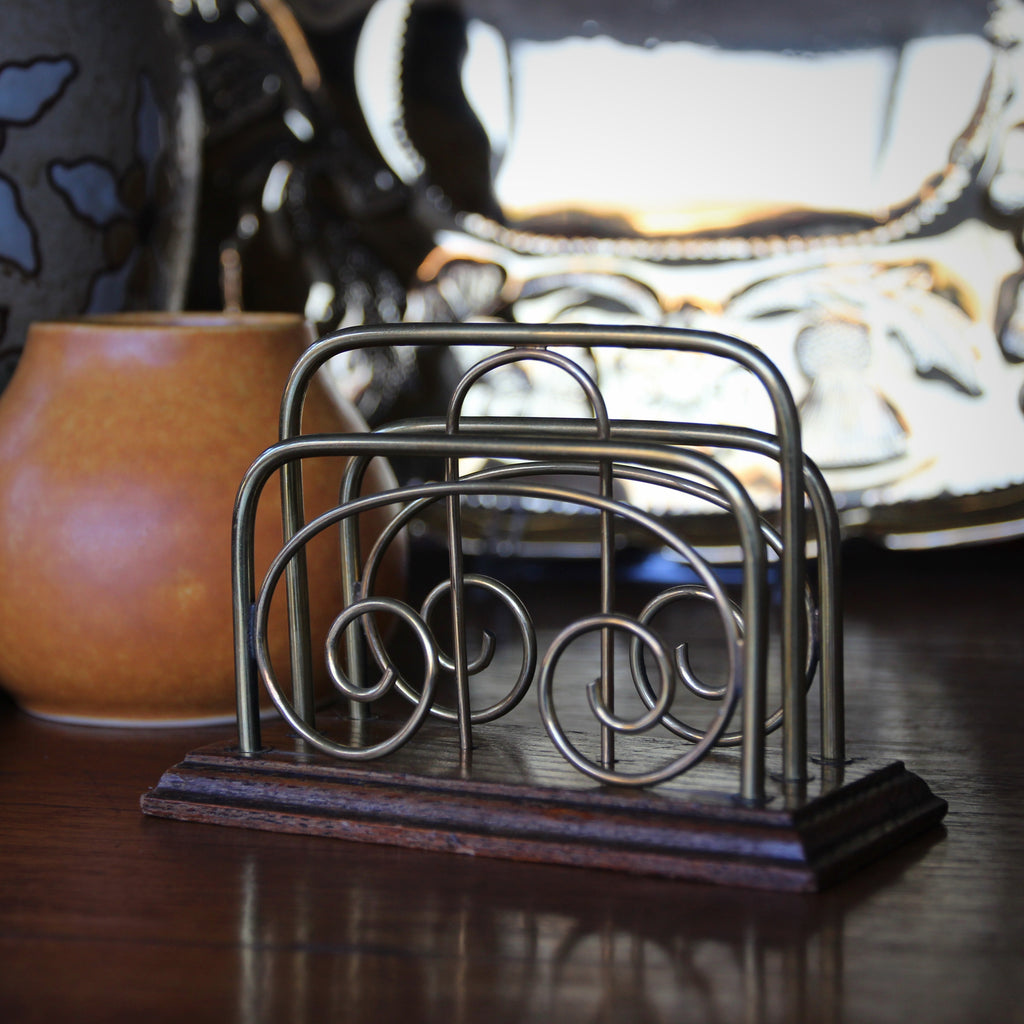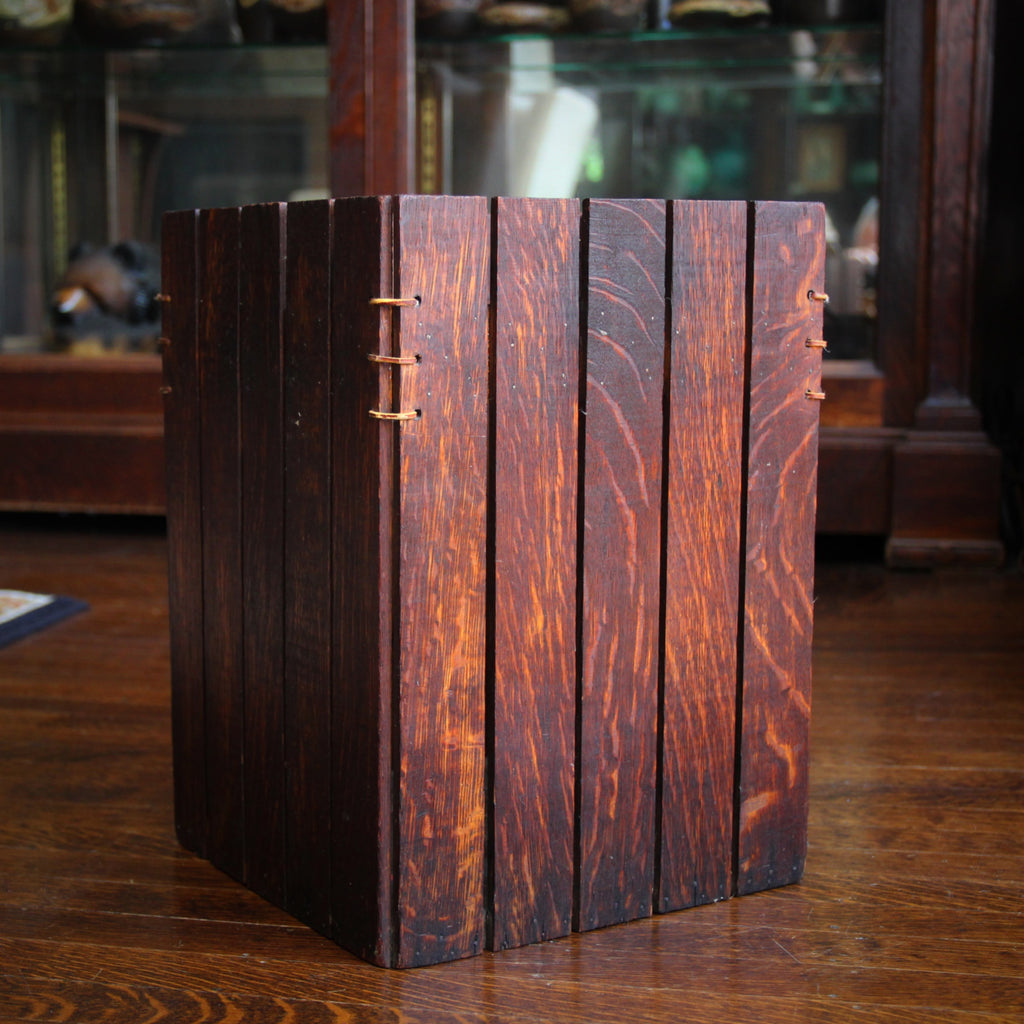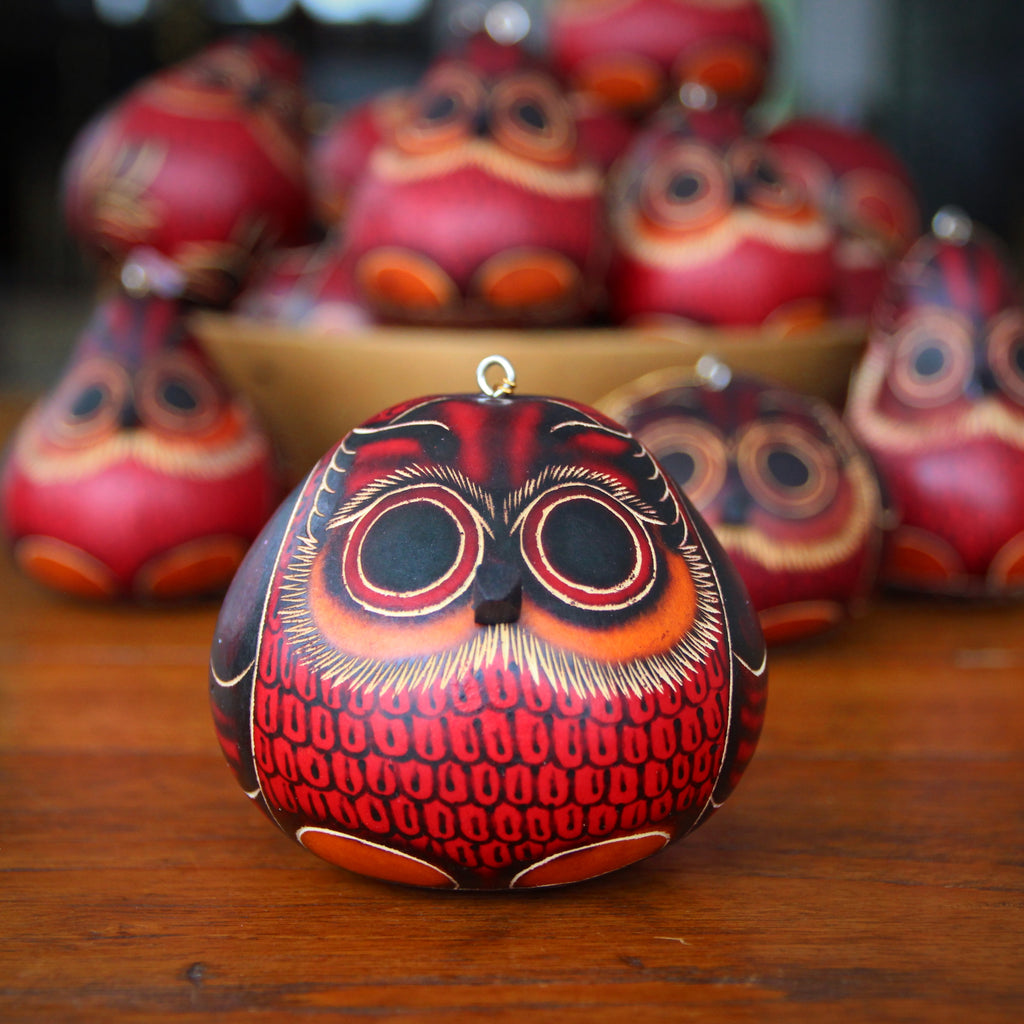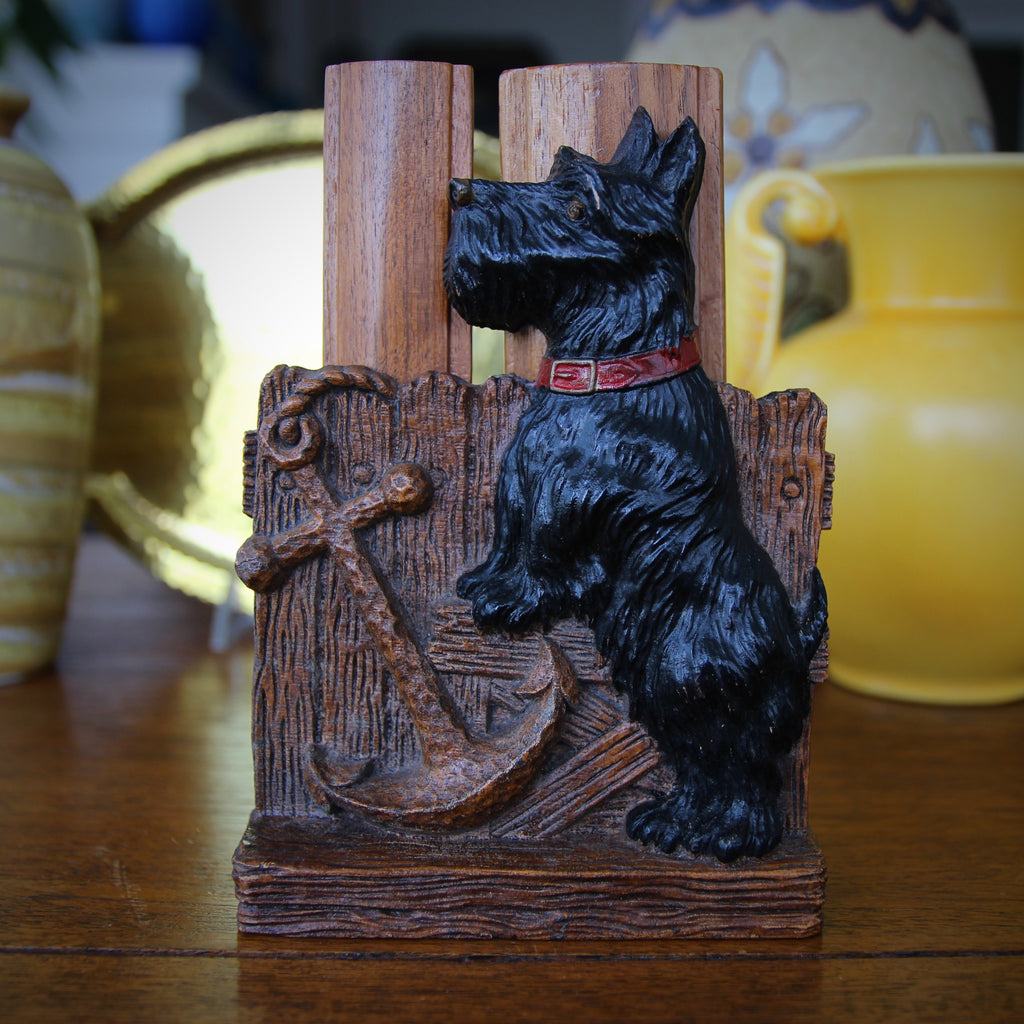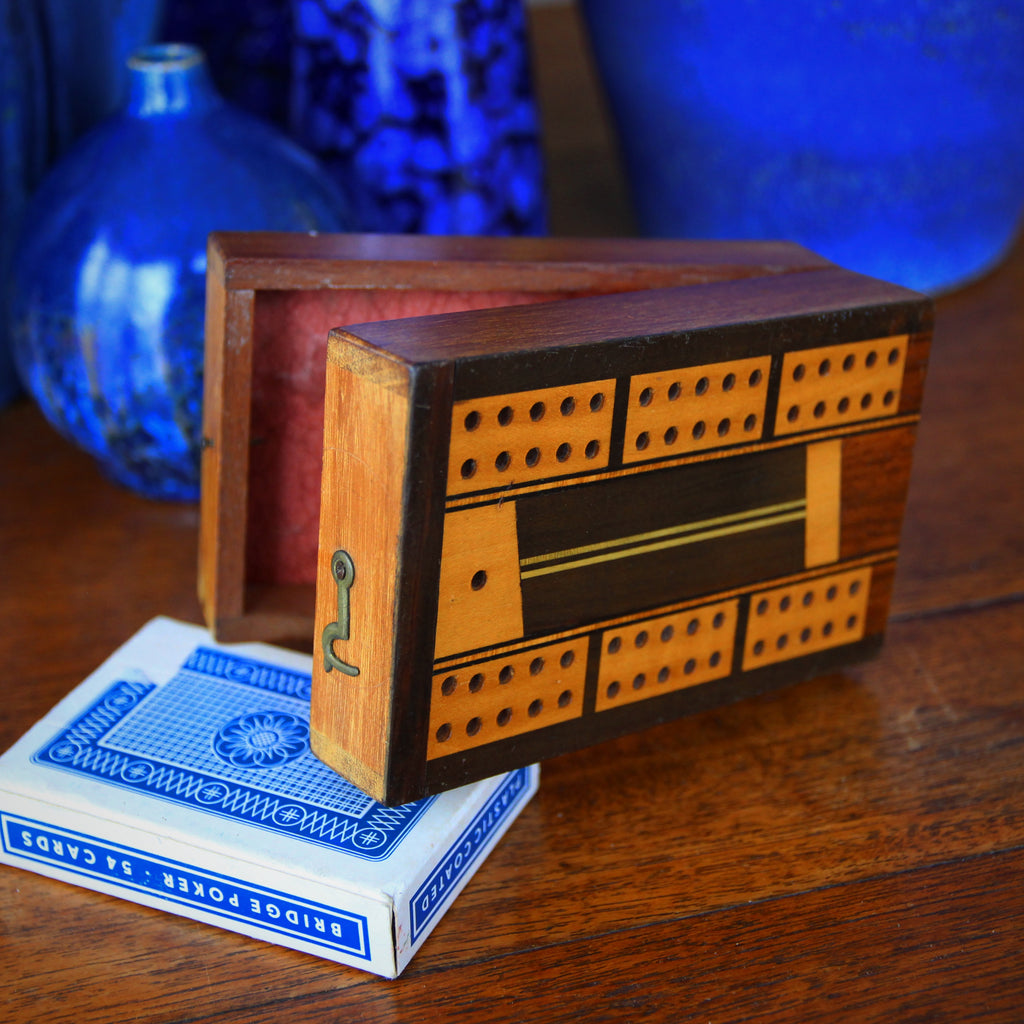JOURNAL — Woodwork RSS
Despite several 7° days—and many inches of snow—Winter only begins today. It is the Winter Solstice, the day when the Northern Hemisphere is most tipped-away from the Sun in the Earth's annual "axis-wobble," toward and away from the Sun. That makes today the "shortest day of the year," the day with the least amount of daylight. And, starting tomorrow, the daylight will begin to shine longer and longer. But the coldest months of the year are yet to come. The mercury thermometer, shown above, was made at the Turn-of-the-Century as an "advertising piece"—a giveaway to customers of the Gall & Lembke Optical Company, 21 Union Square, New York City. The thermometer is mounted to an engraved brass plate, attached to...
Extra Help for the Holidays
Trays are amongst the simplest—yet most useful—of household accoutrements. Compared to carrying-by-hand, trays allow one to transport three (or four) times the amount of volume of that which must be carried. Trays can be fancy and decorative or they can be handsomely utilitarian (like the Edwardian English Oak Butler's Tray, shown above). I use trays when setting the table. In the kitchen, I pile-on all the plates, glasses, napkins, silverware, and serving pieces (pitchers and utensils). Using the tray allows me to make one trip to the dining room. I use trays when serving my guests (first drinks, then supper, then dessert). And the tray is useful for clearing-away the table at the end of the night. When I head...
Coming Soon: Boxing Day
Boxing Day is one month away!
26 December, known as Boxing Day, has been celebrated (in various ways) for centuries. It is associated with the Tenth Century Bohemian "Good King Wenceslas" (in what's now part of Czechoslovakia) who braved terrible cold and snow to bring alms to a poor peasant on the Feast of Stephen (26 December). In England, the term "Boxing Day" has been found in print since 1833. Charles Dickens also used the term in The Pickwick Papers (1837).
Boxing Day, the day after Christmas, is when servants were given their day off to celebrate the holiday (since they were expected to serve their masters on Christmas Day).
Treen
"Treen" refers to those small, useful objects handcrafted out of wood—not including architecture, furniture, clocks or cabinetry. The word "Treen," itself, means "of the tree." In the old days, metal tools and objects tended to be expensive (and plastic had not, yet, been invented). Therefore, many useful tools and household implements were crafted of wood. With the advent of the Industrial Revolution—with its mass production and economies of scale—metal became affordable to a greater percentage of the population. Laboriously hand-carved wooden items became a little less common.
Technically speaking, treen items can be found all over the world. Most of the treen I encounter today—especially from England, where I often shop—was made in the late Nineteenth and early Twentieth Centuries.
Cervantes
On this day in 1547, (it is believed that) Miguel de Cervantes Saavedra was born outside of Madrid, Spain. He would go on to become one of the most-admired writers in the world and his masterpiece, Don Quixote, is foundational to the Western literary canon. Many consider this book the first modern novel and many consider it the world's greatest novel. But much of Cervantes's early life was lived in poverty and obscurity. He and his family often found themselves dodging creditors or the law. Miguel was one of seven children born to a cash-strapped family—a family which some scholars believe were "New Christians" (that is, Spanish or Portuguese Jewish converts to Catholicism). While this heritage may or may not...
Pin-the-Tail-on-the-Donkey
On several occasions, while traveling, I have been offered a donkey ride, up a steep hill (for a fee), which I have declined on principle. I can't bear the thought of making this poor little creature's life any more difficult than it already is. Besides, a brisk climb up a steep hill is great exercise for me—and it makes the ultimate view that much the sweeter. In England, donkey rides are a popular beach-time attraction. The British Equine Society instructs that donkeys should never be made to carry a rider over 50 kilos (110 pounds). Donkeys should be given a one hour break at lunchtime (or in the early evening). And donkeys must be afforded one day off per week....
Chinese Harmony
Like any culture, the Chinese have certain important and meaningful symbols which inform their literature, art and aesthetics. The dragon is amongst the most significant. He (for the dragon is seen as a masculine being) is closely associated with the Emperor—a provider of strength, prosperity, and success. To the Chinese, the dragon is a beneficent symbol of good luck and wealth (unlike in the West where the dragon is associated with evil and destruction).
The phoenix is another auspicious Chinese symbol. She (a feminine being) brings peace, happiness and prosperity. The Chinese phoenix is different from the Western mythological creature; she cannot resurrect like the western phoenix (who rises from the ashes after catastrophe).
Aged Oak
Oak—as it gets older-and-older—impresses me more-and-more. It seems to get heavier (at least the old oak furniture seems to). And the patina of time on oak becomes richer-and-richer. Symbolically, mighty oak ("from little acorns grow") is hardy, durable and down-to-Earth.
This pair of Victorian English vases is crafted of turned-oak. They were made in the mid-Nineteenth Century, during the first twenty years of Victoria's reign. I suspect that they had been decorative elements, mounted atop a sensational piece of furniture or, perhaps, part of an architectural installation. They look perfect when empty—set at opposite ends of a mantelpiece—or holding dried flowers (holly berries at Christmas, dried cornflowers in the Summer).
The Lions of Oxford
"Oxford frames," like the example shown above, became popular in England in the second half of the Nineteenth Century (and, a little later, in America). It refers to the "criss-cross" corner treatment which became associated with "The Oxford Movement" in England. The Oxford Movement was a group of Anglican Protestants (academics at Oxford) who sought the return of many Catholic-style "High Mass" rites and rituals within the Church of England. The crosses on each corner were thought to be especially suitable for framed religious sayings, pictures of saints, or other pictures with religious themes—like images of monasteries, cemeteries or the Holy Land. As the frame style became more popular with the broader public, however, they began to be used for...
Sheffield Plate
Henry Wilkinson was born in 1788 in Norton Hammer, a village in Southern Yorkshire, some three miles south of Sheffield. Sheffield was already playing an outsized role in England's Industrial Revolution: specifically steel manufacturing, cutlery-making and the production of other metalwares.
At the time Wilkinson was born, silver-plating was only a few decades old. The process of bonding a thin layer of sliver to a copper ingot—and then rolling-it-out into a workable sheet—had been developed and improved in Sheffield. These sheets could then be stamped (in metal forms) to produce cutlery, trays, and all manner of silver-plated wares—commonly called "Sheffield Plate."
Pietre Dure
Artworks made of carefully cut, polished and tightly-assembled stones is ancient, indeed. Ambitious works—geometric patterns on floors or intricate images on walls—have been found from Ancient Rome. But the Italian Renaissance—specifically in Sixteenth Century Florence—is where Pietre Dure reached its artistic high point. Popes, dukes and other aristocrats supported the art form with schools, guilds and expensive commissions. Church floors, altars, walls and tombs were covered with varieties of pietre dure works: geometric patterns, still life renderings, portraits and ambitious scenes. Some of the smaller Florentine works were exported around the world. When some reached India, Mughal rulers had local artists adapt the art form into their aesthetic—which they called Parchinkari. The Taj Mahal is decorated with astounding parchinkari works.
Independence Day
Today we celebrate America's independence from England—hard-fought and won at a bloody price. But was that the end of the struggle? Or does the fight for independence continue? And exactly what is the "Independence" which we seek and celebrate?
America's journey toward Democracy—an expanding and comprehensive Democracy—is far from complete. And, perhaps, it never will be finished. Today we are witnessing that American Democracy may be more fragile than we previously had realized. While some eras in American history favored Democracy, today we are at risk of losing it.
Countdown to Father's Day - 6
Father's Day is nigh—and we'd like to share some Handsome Gift ideas for "Dear Ol' Dad." Shown here, a hand-carved wooden bear from the island of Hokkaido, Japan. This northerly island is the most productive region in Japan for farming and fishing. But, during the cold winters (when farmers come-indoors for their seasonal hiatus), the people began carving such bears to keep busy and to provide an additional stream of income. These folk sculptures would be sold to Hokkaido's annual summer tourists—often Japanese visitors escaping the heat and humidity of Souther Japan. Such tourists come to Hokkaido seeking its cooler climes, enjoying its natural beauty, and experiencing the Ainu culture (which once dominated this area). As the bears became more...
The Barley Twist
In the evolution of aesthetic schools, rarely is there a sharp division between the old and the new—separating what had been and what is to come. Rather, existing fashions might be modified with changes which reflect the aesthetic movement which is waiting in the wings. Such intervals sometimes (and conveniently) are called "Transitional Periods." In the case of the Arts & Crafts Movement, period artisans and designers often sought inspiration from earlier, historic ideas. Such inspiration—whether artistic, cultural, literary or historic—was specific to the locale in question. The English may have lifted references to Medieval Knights. Germans may have revived ancient folklore. The French might tip-their-hat to Gothic motifs. In the pair of English candlesticks, shown above, the hand-hammered...
Early Photography
Even after photography became commercially popular—in the mid Nineteenth Century—having one's photo taken remained a rare experience. Unless you were a person of great fame or influence, you might take only two or three photos in your lifetime—perhaps at a wedding or some other important milestone. And the technology of the day gave the sitter few options regarding the resulting photo's size; most pictures were fairly small.
But, like today, a nice frame would make all the difference in presenting—and highlighting—a treasured photograph. Shown here, an oval walnut frame, with a curved, deeply-recessed "profile." The frame was made circa 1850—just about the time that people with a little money to spend might be able to have their photo taken.
Now, For Something Quite Different
Compared to the mirror we shared yesterday—a theatrically romantic Chinese confection—today's mirror, shown above, is straightforward, sensible, and perhaps just a touch stern. It is handsome without being dour. It was made in the U.S. between 1840 and 1860, just before the American Civil War. Mahogany veneering is laid over the curved "ogee" surface of the underlying wood framing. There are a few minor splits and discreet dings to the veneering—though only enough to lend suitable character to the 175 year old mirror frame.
Mahogany was the wood of choice for American furniture in the 18th and 19th Centuries. Much of it was grown in The New World—often in semi-tropical British colonial possessions.
Chinese Romantic
What this Chinese mirror lacks in age, it more than makes-up-for in romantic, theatrical style. The carved wooden frame—lacquered and "gilded" in golden paint—is reminiscent of a Zeffirelli production of Puccini's Turandot. Stylistically, it looks like something which would have been sent to the West in the Twenties or Thirties (though it is more likely from the Seventies or Eighties). The design was inspired by Chinese architecture (or architectural elements) with a carved wooden "fringe" dangling from the roofline and the bottom of the frame. Pierced screening surrounds a five-lobed cinquefoil—an oculus reminiscent of a classic Chinese plum blossom window or doorway. In Chinese art and symbology, the plum blossom represents beauty, courage and perseverance—since the plum blossom has been...
Handsome Candlesticks - Part I
As we are in the eight days of the Jewish Passover, we are sharing some of our favorite candlesticks. Perhaps one of these—or one of the many others in-stock at LEO Design—might help you celebrate the holiday in style. A baluster is a single upright support often found holding-up a staircase rail or balcony railing. A balustrade is a line of such balusters—including the railing which tops them and the bottom rail (into which they are set). They can be made of wood, stone, metal or other man-made materials. Very often they are turned (or have a "turned appearance"), like the baluster candlesticks, shown above. These English candlesticks, made in the Thirties, are turned oak (yes, in the form of a...
More Light - III
Jesse H. Bunnell was born in Ohio in 1843. At the age of eleven, he was a messenger-boy and by 13 was working as a telegraph operator (sending messages electronically by Morse Code). He was quick, efficient, and a constant inventor. At the age of 17, he set a telegraphist speed record while transmitting President Buchanan's final address to Congress (averaging 32 words per minute for a two hour duration). During the Civil War, Bunnell served as a telegraphist for both President Abraham Lincoln and General George McClellan. During the Civil War, telegraphists, like Bunnell, were only paid $60 a month—a small amount considering the critical importance of their mission and the fact that they were often at (or near)...
Finally February!
Boy! Didn't January 2025 feel six months long! But we've made it to February, and she brings with her a birthstone, the regal Amethyst.
"In the Olde Days," Amethysts were rare, indeed. They were considered one of the "Cardinal Gemstones"—alongside diamonds, rubies, emeralds and sapphires. Further elevating their status was their association with the monarchy—as the precious (and costly) color purple has long been linked to the royalty. Alas, new and large amethyst mines were discovered in Brazil in the Nineteenth Century, causing the global price of amethysts to fall. Though less-precious today than they once were, they remain no less beautiful—or regal. And they are the birthstone to those born in February.
Ski Break!
Who needs a break? Let's head for the hills—to the ski slopes!
In the old days, skis were crafted from a single piece of wood. This made them rather heavy, stiff, and prone to cracking under extreme use. Jørgen Aaland (1895-1973), a Norwegian who had spent several years living in the U.S. Northwest, knew that a laminated ski would be lighter, stronger, more flexible and more responsive. Once a strong-enough glue had been created, Aaland worked many late nights to develop a plied ski—made from multiple layers of glued-together wood. In 1932 he applied for a Norwegian patent. He christened his new product Splitkein (literally, "split cane").
A Lot to Bear
The times . . . well, it's a lot to bear. So let's distract ourselves with a lot of bear. Shown here, an extra large hand-carved bear from Hokkaido, Japan. Hokkaido is the second largest island in Japan, up in the chilly North. Its capital, Sapporo, is known for its namesake beer. The island was once populated by the Ainu people—who lived on Hokkaido, in Southeastern Russia, and on the string of islands which stretched between Japan and Russia. In ancient times, the Ainu maintained a "hunter gatherer" society, even while the rest of Japan developed a farming lifestyle. In time, however, through colonization and forced assimilation, the Ainu people conformed to the Japanese culture, economy and way of life....
Boxing Day
It's Boxing Day in England and her Commonwealth Countries—the national ("bank") holiday on the first weekday following Christmas. Back "in the old days," household servants were expected to work on Christmas Day, serving their employers at their holiday celebrations. Instead, working servants would receive the next day off, 26 December, as their holiday. The term "Boxing Day" refers to the custom of these servants (and other tradesmen) coming-by the big house to collect their "boxes"—their gifts from their employers. Such boxes might include a gift, money, or other items (like food or alcohol) which the servant could use at his or her own family celebration. Boxing Day, which is believed to have been celebrated first in the 1600's, may have grown-out-of...
It's Building: One Week 'til Christmas!
It's one week until Christmas! And the pressure is building! Have you finished everything on your checklist?
One nice gift idea—for your favorite budding-architect or engineer—is this set of Mid-Century German building blocks. The wooden blocks, nestled within their convenient storage box (with sliding cover), are printed or painted to add visual interest to the finished structure. Give the kids something without a battery! Or, perhaps, you might know an executive who could use an interesting conversation piece to fidget with on his or her desk.
The Season Takes Flight
Black Friday is behind us—and we're in the thick of the Holiday Season. Look who's come to visit us! These winsome owls—a flock of owls is called a "parliament"—are handcrafted from gourds. And each owl expresses his own personality. Sleepy. Satiated. Startled. The gourds are harvested, dried, painted, flame-scorched, and carved.
Nothing Faster
It was such a different time—back in the 1930's—when the postal system represented the cutting edge of quick and efficient document transmission. There were no fax machines. No Federal Express. And the internet was still decades (and decades) from introduction. "The mails" was the fastest system—and postage stamps were the coin of the realm. Everyone (at least anyone who sent mail) kept a ready supply of postage stamps at hand—in various denominations, in order to cover the weight of the envelope or parcel one was sending. Stamps might be kept in a special container, like the handsome English Art Deco stamp box shown above. When this stamp box was first in-use, in the Thirties, a US postage stamp cost 3¢. It remained...
The Anglo-Indian Legacy
Britain received its first land grant in India in 1640. From that point, and through the Eighteenth Century, England became increasingly powerful in the subcontinent, mostly through trade transacted (and warfare waged) by the British East India Company. In 1858, England took direct control of the Indian government, ruling the country (called the "British Raj") until they were kicked-out in 1947. Until then, Victorians referred to India as "The Jewel in the Crown." The legacy of British colonialism in India is (and will be long) analyzed and debated. And verdicts may switch back-and-forth as the decades unfold. But, when we consider art and aesthetics, the effect of Anglo-Indian artistic cross-pollination has left a wake of beautiful works: art, architecture, and decorative...
Arts & Crafts Gothic
Arts & Crafts period designers—wherever in the world they may have worked—often looked-back to their country's (or culture's) past for design inspiration: history, literature, folklore, ancient craft. Their efforts to "revive" familiar aesthetic elements or symbols of the past were part of the movement's attempt to channel "the good old days"—to recreate those better times when life was quieter, simpler, purer.
The Gothic Aesthetic was frequently used as a "historic touch-back" in American and European Arts & Crafts design. Its rustic, hand-wrought and wonderfully-antiquated sensibility helped lend a feeling of warm archaism to the newly-rendered object. And most Turn-of-the-Century Westerners were somewhat familiar with the Gothic Style (or the Gothic Revival from the Nineteenth Century).
Lacquerware
Lacquering is a surface treatment of wood (or sometimes metal) which originated in Ancient China. The sap of certain plants was heated and applied in layers; as it cooled, it built-up into a durable, waterproof and very beautiful finish. The original process, sometimes referred to as "True Lacquering," used the sap of the Toxicodendron Vernicifluum, called the "Lacquer Tree," a plant which grows in Asia and the Indian Subcontinent. Over the centuries, artisans have developed alternative recipes and processes for achieving the desired lacquered finish. Lacquering can be polished to a high gloss, left flat, or calibrated somewhere in-between. Sometimes the lacquerware is further embellished with painting, inlaying of mother-of-pearl, or the application of other costly substances.
Modern Japanese Style
In keeping with our Modernist barware theme (see yesterday's journal entry), here is another intriguing piece—from post-war Modernist Japan. A hand-cut glass shaker with chromed lid is joined by six barware implements—all smartly-arranged upon a wood and chrome caddy.
The utensils include a graduated "scoop-form" jigger, an olive pick, a mixing paddle, ice tongs, strainer and bottle/can opener. All the pieces have wooden handles or accents.
The entire set hangs (or sits) upon this handsome wood and chrome caddy—ready for smart service at a moment's notice.
Still Going!
In honor of this week's Democratic National Convention—and the parade of feisty Democrats crossing the convention's stage—we are showing a few of our own favorite donkeys, now in-stock at LEO Design. (If your tastes lean towards elephants, click "continue reading" then please click here.)
This fella, a 1950's wooden toy, is composed of articulated limbs, ears and tail. He is painted in red and black—with a watchful eye and a yellow mouth.
Sewing Speeds-Up
On this day in 1851, Isaac Merritt Singer obtained a patent for improvements he created to the sewing machine. Though he did not invent the original sewing machine, his design changes made the machines smaller, more reliable, easier to use, and easier to manufacture. He emulated the mass-production examples of gun makers (like Samuel Colt and Eli Whitney) with their modern production lines and reliance upon interchangeable parts. Prior to this, sewing machines were big, bulky, complicated industrial machines—better suited to cobblers, harness makers and other industrial settings. Singer's smaller, reliable machines could be used in the home. And they were affordable. His mass-production drove-down the price of a new sewing machine from $100 to $10 (equivalent to about $400...
A Tribute to "Cat Ladies" - VI
This week, we're sharing some of our favorite felines—a tribute to "the cat ladies" who inspire, teach and lead us. Surely this is an authentic cat lady—complete with her kitten, sitting upon her shoulder, snuggling in the crook of her neck. Such hand-carved wooden sculptures are often called Blackforest Carvings, whether or not they are strictly from that specific Bavarian region of Southern Germany. Many carvings of this type were also made in Switzerland or Alpine (Northern) Italy. It seems that mountainous regions, the world over, lend themselves to artistic woodcarving. For one, there are always plenty of trees. Secondly, mountain farmers (or herders) may find themselves forced-indoors during the harshness of winter—giving them plenty of time to create seasonal crafts (and not just...
Rainy Days and Mondays
Despite the wisdom of the Carpenters, neither rainy days nor Mondays "really get me down." Not when I have such a handsome English Arts & Crafts "stick stand." A variety of woodworking techniques—piercing, turning, chamfering, crenelation—create a most handsome and useful piece. And the brass drip bowl is well-darkened with years of hard-earned patination.
Welcome, June
June is here—with her flower, the Rose.
Roses have grown in the wild for tens of millions of years. 50-million-year-old rose fossils from the Eocene Period (which means, roughly, "The New Dawn") have been uncovered by archaeologists in Colorado. Roses are depicted in Minoan art (circa 1400 BC) and in Egyptian tomb paintings shortly thereafter. And ornamental roses are known to have been cultivated by the Chinese, Persians and Mediterraneans from about 500 BC. There are over 300 different species of natural roses and tens-of-thousands of man-made "cultivars" (that is, special varieties of roses purposely bred to accentuate selected traits like color, size, fragrance, form or hardiness).
My Favorite Things
One of my favorite finds of the last few months: a pair of English Arts & Crafts turned mahogany candlesticks. The "cup" at the top has a tulip blossom or poppy pod floral-form. And "knuckles" at the top and bottom of the reed-thin shaft give visual weight to the turning. Truly elegant! And much more impressive in-person.
Indian Clubs
Exercise clubs are believed to have been developed first in Persia, called "meels," which were used in individual and group exercise routines. They later became popular in India where Colonial British soldiers discovered and adapted them for their military fitness regimens. It was at this point that they began to be called "Indian Clubs." English Commonwealth and American civilians embraced them during the Late Victorian age. The clubs range in weight from about a pound (for use in calisthenics) to very heavy (up to 100 pounds, for resistance training). After World War II, and the advent of more sophisticated exercise equipment, Indian Clubs lost their popularity. Today they are most often used as a decorative accent for a clubby, athletic...
Charles Rennie Mackintosh
We have been taught, "A prophet is never accepted in his home town." It seems this was the case for Charles Rennie Mackintosh, the foremost designer of the Scottish Arts & Crafts movement. His influence, during his lifetime, was more eagerly embraced outside of Scotland than it was at home. Many of his Scottish architectural designs were never built. He eventually abandoned architecture and focussed his later years on watercolor painting. Naturally, once he had died in 1928, his work became increasingly popular in Glasgow and his legacy has now been firm established. Today, one cannot walk five steps in Glasgow without seeing some kind of Mackintosh-inspired graphic or souvenir.
Small Chairs
There's something I love about small chairs. I don't have children. I've never had a doll. But I can't pass-up a nice, small chair—be it made for a child or a toy.
It's not that I particularly like chairs. In fact, I have always made it a point not to stock "real chairs" (they take forever to sell and take-up too much shop space until that happens).
What I like about small chairs is that they are wonderful merchandising (or home decorating) props. One can place a small chair atop a merchandise display—a table, a shelf or a mantelpiece—and provide automatic "lift" to some featured item. It helps to "break-up" the display area, creating a variation in height amongst the products.
Très Convenient
The older I get, the more I appreciate just how convenient a good tray can be. Of course, I have always used a tray when serving my guests at table. But I now find myself pulling-out the tray when I set or clear the table (carrying far more plates, cutlery, napkins or glassware than I could handle without it). The tray makes carrying safer and easier—and it cuts-in-half the number of back-and-forth trips I have to make. I also use a tray when moving merchandise around my home or showroom—and appreciate the reduced number of trips I have to make up or down a flight of stairs. The tray makes it easier to organize LEO Design's collection of cufflinks (which...
Arts & Crafts Elegance
At first glance—which was from a distance—I thought that these English Arts & Crafts candlesticks were made of cast and patinated bronze. It was only upon closer inspection that I realized that they are mahogany, burnished with a warm, reddish finish. These elegant floriform sticks bear a stylized resemblance to poppies or tulips. The cups are sensuously turned buds. The base is turned, too, with a pleasingly curvaceous profile. Finally, the two "knuckles" floating on each stem provide just the right punctuation to complete perfectly the design. The brass bobeches atop each candlestick—which prevents the candle flame or heat from harming the wood—are darkened with age. They nearly disappear into the wooden candle top.
Ebony
Ebonywood has been used decoratively for millennia. It has a very fine texture and can be highly polished. Carved ebony objects have been found in Ancient Egyptian tombs. The wood became popular in Europe during the late 1500's, when Dutch traders began importing the material which grows in India, Sri Lanka, West Africa, Indonesia, Australia and Mauritius. Recall the heavy, black frames which were popular during the Golden Age of Dutch painting; perhaps some were ebonywood (or other woods ebonized to resemble it). Ebony became popular for European furniture making in the 1600's. In France, such furniture makers were called ébénistes—a word still used for "furniture maker" to this day.
Trench Art
The term "trench art" is used to refer to the folk crafts fashioned of (or partially fashioned of) the used or spare materials of warfare. This art form was especially popular during and after World War One. Trench art was made by all the major WWI participants: England, France, Belgium, Germany, Canada, Australia and the United States. But very little trench art actually was made "in the trenches"—or even on the front lines, for that matter. Much of it would have been made away from the battlefield, for example, at training camps or other military posts. Some might have been made in hospitals by recuperating soldiers. And some may have been made back at home—by soldiers awaiting call-up. Even after...
Wooden It Be Useful? - V
Can one have too much organization on one's desk? This English early Twentieth Century oak stationary stand bears the crest of Queen's College, Oxford. Store stationery supplies: envelopes, paper, business cards. Perhaps a stash of commonly used forms or cards. Or keep your to-do cards and paperwork close-at-hand. And the handsome, wooden construction adds a small touch of architectural interest to your office, den, kitchen or entryway.
Wooden It Be Useful? - IV
To hold this Japanese hand-carved business card case is to appreciate its beauty and craftsmanship. The delicately tapered "wedge" (thicker on one edge than the other) feels great in the hand. The hinged cap, at top, closes with a satisfying magnetic click. Pulling the case from the breast pocket of a jacket will provide that extra measure of confidence before handing one's business card to that important professional contact.
Wooden It Be Useful? - III
This week we're sharing a selection of useful wooden items. The wood of this English barrel-form coin bank glows richly. Riveted brass bands punctuate the bulging form. Warm, honest materials meet straightforward function: a handsome place to stash your savings.
Wooden It Be Useful ?- II
Yes, this English Arts & Crafts Letter Rack is made of wood—though it is embellished with plenty of hand-hammered brasswork. A winged dragon stalks in a field of botanicals, while an undulate amethyst glass cabochon floats overhead. The hand-tooled panels are riveted to the oak understructure. This piece is made to hang (on its mounting ring) or it can rest of a flat surface.
Wooden It Be Useful? - I
Is there anything more wonderful than wood? Warm. Useful. Natural. For millennia, humankind has been fashioning wood for tools, shelter, warmth and all sorts of decorative items. Perhaps it is the most malleable and accessible of natural materials. And the nature of wood makes it ideal for many uses—which no other material can replicate.
For the next several days, we'd like to share a selection of our wood-crafted objects, items which are handsome and useful.
Shown here, an American Arts & Crafts slatted oak wastepaper basket. The quarter-sawn strips, bound with rawhide lashings, add an additional level of textual interest. What Arts & Crafts desk (or office) wouldn't look better with this handsome basket?
Oxford Around the Corner - III
Let's wrap-up this short presentation on Oxford Corners with an Eastern European beauty, made in the Teens or Twenties. Marquetry stripes of contrasting woods are surrounded by notched chip-carving—providing a serrated "Tramp Art" effect. Tramp Art is the popular name for notch-carved treatments on folk-crafted wooden objects. Traditionally, the items were assembled and carved from found objects: cigar boxes, fruit crates, scrap wood offcuts. The "romantic legend" implies that homeless men, in an attempt to make a bit of money, would scrounge for the recycled materials and craft the little wooden objects to sell. In truth, Tramp Art was probably more often a simple, low-cost handcraft practiced by hobbyists and boy scouts at home, at school or at summer camp....
Oxford Around the Corner - I
I'm heading to England this week—London, not quite Oxford—and I thought I might prepare for the trip by sharing a few frames with "Oxford Corners."
Oxford Corners are the style of framing joinery in which the vertical and horizontal members form an intersecting cross at the corner. And, while such joinery is named after the famed academic city, Oxford Corners have been made all over Europe—especially in the Nineteenth Century, from which the frame above originates.
The "Blackforest" frame, shown above is from either Southern Germany or Switzerland—the forested mountainous region which has long specialized in carved woodwork. This frame exhibits a hand-carved "rustic-timber" profile. Carved wooden leaves embellish each of the frame's corners.
Edelweiss
In 1856, Austrian Emperor Franz Joseph I was enjoying a mountain trek with his new bride, the Empress Elisabeth, a Munich-born beauty known as "Sisi." He picked a few edelweiss blossoms from amongst the craggy rocks and presented them to his beloved with the words, "First in my life that I picked myself." From that point onwards, the popularity of the flower was assured—as a symbol of immaculate and everlasting devotion (and, more broadly, emblematic of the rugged purity of the Alps and her people). Sisi wore nine edelweiss blossoms in her hair while sitting for her famous portrait by Winterhalter. For his part, the Emperor had edelweiss blossoms embroidered upon the collars of his Imperial-Royal Mountain Troops. The flower...
To Market! To Market!
A village woman—perhaps heading to market—enjoys a last minute snuggle with her kitten. This beautifully-carved wooden sculpture is likely from the Blackforest (Germany or Switzerland) or, perhaps, Eastern Europe.
The Sporting Life - III
A country squire works his fields, shotgun in-hand and bird dog at his side. This lithographic print, published in 1898, is the work of Sir William Nicholson, RA. It was published in London as part of a bound portfolio titled An Almanac of Twelve Sports. It is framed in a rustic "woodland" carved frame—a decade or two older than the print itself.
For A Doll's House
I am always looking for "things to hold other things." Near the top of that perpetual search list are objects which can be used to hold business cards. Coolness, style and unexpected adaptation always goes a long way. This little vintage bench—made of pine twigs—was made in the Fifties for a doll's house. In order to keep the cards from slipping between the twiggy slats, I folded one of the cards ("just right") to create a smooth, impermeable surface.
Measuring Up
125 years ago, rolling tape measures were made of printed fabric, wound around a spool in a bulky cartridge. One would pull out the tape measure and reel it back in, as one would a fishing reel. Modern, stiff metal tape measures were invented in the Twenties; the concave-convex metal tape allows it to remain relatively stiff, an aid to measuring. The "thumb lock" tape measure was patented by Stanley in the Sixties. Speaking of Stanley, this New Britain tool manufacturer made the folding pocket measure, shown above. This is the "Stanley #62," made of boxwood and brass (which is used for the hinges and along the sides of the ruler). A measuring stick like this would be carried in...
Game Time
With the Holiday guests coming—and the long, quiet Winter to follow—indoor family games could become more popular in many a household. Card games, like poker and black jack, use chips as stand-ins for actual money. Likewise with roulette (though most homes are more likely to have a deck of cards on-hand than a roulette table). This hardwood English Art Deco poker chip caddy is ready to help entertain your Holiday guests (or speed-up those long Winter nights). Red, white and blue interlocking poker chips surround the perimeter of the caddy. A burled inlay adds a bit of pop around the handle. And a stitched leather cover keeps everything tidy and secure between games.
Autumn is Here - part XIII
As the Autumn chill increases, we find ourselves hanging-up the garden tools and returning to our indoor pastimes: reading, baking, arts & crafts. For those who sew (or practice other needlecrafts), this hand-carved Swiss Blackforest pincushion might be a handsome and practical solution. Leaves and scrolling branches provide the frame—which, if desired, can be hung right on the wall (next to one's sewing spot). It can also be stored in a sewing basket or on a sewing room table or shelf. If sewing isn't your hobby of choice, this pincushion might be a useful place to hang some of your jewelry: pin-on the brooches directly and hang earrings or necklaces on a straight pin. It is also a clever and handsome...
Unearthing a Trove of Nicholsons - III
Let's end our tribute to the brilliant English artist, Sir William Nicholson, with a tribute to the brilliant American writer, Samuel Langhorne Clemens—better known as Mark Twain. In 1899, Nicholson published his first series of Twelve Portraits, published in London by William Heinemann. This was after Heinemann had already published three other Nicholson portfolios: An Almanac of 12 Sports (1897), London Types (1898), and The Alphabet (1898). Heinemann was keen to keep the business rolling. He proposed a second series of twelve portraits—and even suggested the list of luminaries to be included. The problem was, Nicholson was quite busy! He was running a successful graphic arts and printmaking business with his brother-in-law, James Pryde (called The Beggerstaffs). He was asked...
Unearthing a Trove of Nicholsons - II
In the late Nineteenth and early Twentieth Centuries, a number of Black (mostly American) boxers persevered in their challenging rise to prominence in the competitive boxing circuit. Such matches were certainly freighted with measures of fear, racism and "exotic spectacle"—especially when a Black fighter was matched with a White one. But Black boxers were popular, some developing legions of fans—in America and internationally.
Jack Johnson (1878-1946) was one of the most famous Turn-of-the-Century African-American professional boxers. Others included Joe Jeanette, Sam Langford and Sam McVey.
Unearthing a Trove of Nicholsons - I
I've been collecting William Nicholson prints for nearly thirty years. When I closed the store in Greenwich Village (and moved to Pittsburgh), I brought with me a flat file full of "frameable orphans"—antique pictures waiting to be adopted, that is, placed in a suitable, "forever frame." These prints and paintings have been sitting (in the dark, in Pittsburgh) for the last six-and-a-half years, waiting for me to find them frames. In truth, some of these pictures (including a number of Nicholsons) had been sitting in that flat file for an additional 20 years before the move. What slows-me-down is finding the right, period-correct frame for each special print. Although I collect antique frames, only a small percentage of my "private reserve" frame...
In Search of the Pharaoh's Daughter - XIII
It's our last day in Egypt and we decided to explore Cairo's Coptic Quarter—a neighborhood populated with some of Egypt's diminishing Christian population. It's a lovely change of atmosphere from the gritty, bustling commotion of modern Cairo. Almost zen-like. Though full of people, the neighborhood seems to have a calm and centered air. The word "Coptic," in its simplest sense, means "Egyptian." "Coptic Christians" simply means "Egyptian Christians." Though, today, the word Coptic (alone) has come to refer to Egyptian Christians. The Coptic Orthodox Church has its own pope and rites and has been separate from the Roman Catholic or Greek Orthodox Churches since 451 AD. Coptics name Saint Mark (who was evangelizing in Alexandria, Egypt) as their founder. It...
My Little Cabin
Modern people—especially urban denizens—often long for a little place in the country where they can get-away from the bustle of workaday life. A place to go, perhaps for the weekend, where they can relax amidst nature and "recharge their batteries." The Adirondacks in Upstate New York is full of city dwellers (at least on the weekends). Bostonians choose Cape Cod, New Hampshire or Maine to get away. And the many (many) islands which populate the waterways near Stockholm are dotted with thousands of cute red and white weekend cabins. Whether used for hunting, fishing, reading or cooking, these little weekend homes provide the rest and relaxation needed to counteract the hustle-and-bustle of modern, city life. This little log cabin,...
Always Good Intentions
I remember Eighth Grade Shop Class quite well. It was at Kapaa Intermediate School, on the Hawaiian island of Kauai, and we would rotate through the various "disciplines" quarterly: woodworking, metal craft, technical drawing and gardening. If Mother's Day or Father's Day happened to coincide (even approximately) with the woodworking or metal craft interval, you could be certain that a "love-crafted gift" would be going home to the parent in question. Now, 47 years later, I can still clock a shop class creation from across the flea market. The piece always has good intention; it's the level of finesse which varies. And I always spare a thought for the (poor?) parent who was required to "oooh and ahhh" at the...
I'm Not Going Native!
Though I live in the City of Pittsburgh, I am part of a multi-dealer group shop, The Antique Center of Strabane, in Washington County—the suburban (and rural) region south of The Steel City. Thus I am a daily witness to the aesthetic "taste preferences" of this non-urban population. What's most popular in this area is a rustic country look, sometimes called "primitives." This means crocks, old kitchen accoutrements, and rustic, painted wooden furniture.
One such example of primitive goods is the weathered knife box, shown above. It displays the "life wear" which primitive collectors want, plus substantial traces of the original paint, in this case white.
Mirror, Mirror
I vastly favor antique mirrors with old—preferably original—glass. Old glass is wavy, hazy, sometimes a bit spotted or otherwise degraded by time. It has the right character to convey the piece's age, which new glass just cannot do. How much aging is the right amount? Well, a light sprinkling of dots is nice; maybe a grey haze of time. But I've never seen glass which looked "too old." In my life, only the bathroom mirror needs to be ultra-clear. This is where I shave and perform other delicate functions (sometimes with sharp implements) and want to see precisely what I am doing. All other times, "soft focus" is just fine. The American Empire mirror, shown above, is a handsome specimen...
Classic Sidekick
The classic Spanish novel, Don Quixote, is a masterpiece of Western literature. Published in two parts (in 1605 and in 1615), this book by Miguel de Cervantes is considered by some scholars to be the World's first modern novel—and amongst the foundational works in the Western canon. Cervantes has given us a misguided dreamer, an idealistic romantic on a hopeless quest to rekindle chivalry and valor in the world (a "Quixotic" ambition, indeed). And Cervantes has also provided the classic sidekick, Sancho Panza, whose earthy simplicity provides a shockingly clear (and often funny) counterpoint to the hero's whimsy.
Mirror, Mirror
In the Edwardian Era, when indoor plumbing was still a novelty, men would shave on a washstand—in the bedroom—using a large pitcher of hot water and a large ceramic water basin. Sometimes the washstand had a built-in mirror. Often, the washstand was simply tiled with glazed ceramic squares—an measure to keep the furniture water-resistant. An Edwardian English walnut shaving stand like this would have stood atop a washstand (or dressing table or chest of drawers). The stepped, chevron-form stand is mounted with a brass gallery to help corral the various tubes, mugs and pots associated with shaving. A divot in the center front is a handy place to store one's cufflinks or spare razors. The oval mirror is nicely bevelled and the...
Rainy Weekend
It's a rainy weekend here in Western Pennsylvania. Good for my Spring plantings—and, actually, good for sales (as people shop when they cannot play out-of-doors). This English Arts & Crafts "stick stand" (Americans call it an "umbrella stand") is the perfect, handsome accompaniment for such a rainy day. It's made of mixed-woods and boasts attractive, botanically-inspired "piercing." A crenellated top edge "crowns" the piece.
The Good Shepherd
In truth, "The Feast of the Good Shepherd" was last Sunday, 30 April. Alas, I had not yet acquired this Late-Nineteenth Century Italian print of The Good Shepherd in time. So I'll share it now.
The lithographic print is nice, if not "important." What really sets-apart this piece is the exquisite Italian frame. Tiny pieces of wooden marquetry—and lots of those pieces!—are precisely cut and laid finely into the wooden frame. Under close inspection, one can really appreciate the painstaking fastidiousness of the craftsman. From a distance, the graphic pattern of the woodwork seems to radiate energy outward—giving the Christ figure a "halo-like" presence.
April Showers - Part Five
Before the 1950's—when automatic washing machines became commonplace in middle-class American homes—doing laundry was not a lot of fun. Usually on a Monday, laundry day started before sunrise. Water was carried-in, brought to a boil, and the laundry was processed as a day-long event. For this reason, until the last several decades, people sought ways to reduce the amount of laundry which had to be cleaned. Men wore detachable shirt collars, which allowed the collar to be removed and cleaned separately from (and more frequently than) the shirt itself. Women wore substantial (though light) undergarments which helped keep their outer garments clean longer. And guests (or family members) might use the same linen dinner napkin for several meals (or throughout...
You Had Mail . . .
On this day in 1950—73 years ago today—the U.S. Post Office reduced mail deliveries to once per day (Monday through Saturday). Many of us don't remember the time when mail came more frequently. In the Nineteenth Century, households received mail deliveries up to five times a day. In the first half of the Twentieth Century, households received a morning and an afternoon delivery; businesses received mail up to four times a day.
This Edwardian English wall-mount letter caddy was the perfect spot to stash newly delivered letters and newspapers at the Turn-of-the-Century. A handsomely chamfered oak panel is mounted with brass holders—embellished with enameled lettering and decoration.
Creative Blocks
Building blocks have long been given to children—for play, for learning, to inspire creativity. This small set of blocks, from the Turn-of-the-Century, come in their own flat presentation box, complete with sliding, decorated lid. Some of the blocks are carved into balustrade shapes. Others are clad in a decorated paper skin. Great for a school child or as a conversation piece on an architect's desk or credenza.
Signs of the Times
When I travel to other countries, I frequently am reminded just how short is the history of the United States. Put another way, things have moved much more quickly in America than in some other places. Sometimes the merchandise I collect helps to illustrate that point. Consider the handsome walnut oval photo frame, shown above. It was made in the 1850's. Let's propose that it was made during the presidency of Millard Fillmore (1850-1853). This was still three presidencies before that of Abraham Lincoln (1861-1865). And, while the frame is considered "Victorian," we must remember that Queen Victoria reigned for a very long time; 18 American presidents held office during the length of her rule (and three more before she even...
Giving Alms
During Lent, Christians are encouraged to pray, fast and give alms—that is, provide money (or other necessities) to those in need. These disciplines prepare the heart, mind and soul for the the joyous season to come: Easter. Sure, almsgiving is (and always has been) important. And not only amongst Christians. But who knew it could be done with such style? This handsome Arts & Crafts alms plate, made around the year 1900, is fashioned from hand-carved oak. The exhortation, "Give Alms of Thy Goods" surrounds the plate and a soft velvet pad is affixed to the bottom of the bowl (to muffle the vulgar rattle of coins). It's a beautiful plate—and one which has done much good, collecting unknown amounts...
More Middle Eastern Marquetry
Here's another Middle Eastern Mid-Century marquetry jewel box. Various, differently colored woods are arranged—with Mother-of-Pearl—to create a handsome place to keep your jewelry, watches, keys, or other small treasures. It would also be a nice place to inter the ashes of a beloved pet.
Middle Eastern Marquetry
Artists have been crafting beautiful inlays for millennia. Mosaics, enameling and inlaid woodworks can be found amongst the artwork discovered from the earliest of times. Marquetry is not technically an "inlay." It is an arrangement of thin wood pieces (or shell, bone, stone, metal, straw or other materials) which is precisely cut-and-fit together in a thin sheet and applied as a veneer to a flat wooden surface—for example a piece of furniture, a floor, a wall, or a small flat object. Marquetry was used in Ancient Egypt, Persia, Rome, Renaissance Italy, and throughout Asia for centuries. The Middle Eastern box above, made in Mid-Twentieth Century, utilizes various wooden veneers and chips of Mother-of-Pearl to create a warm and handsome geometric...
Have a Seat
Having had a small (and tight) Greenwich Village storefront for 23 years, I've developed a certain prejudice against buying chairs. Especially sets of chairs. In my experience, sets of chairs do not sell quickly. Sure, everyone needs them. But, until they finally sell, they take-up lots of precious floor space, require frequent moving (in order to reach other things) and are only moderately useful for displaying other merchandise before they sell (compared to, say, a table). In short, they always seem to be in the way! All this said, I have always enjoyed buying children's chairs. Their small size makes them useful (atop or under a table) for displaying merchandise—like a giant, nice-looking riser platform. Sometimes they can be hung on a...
Back-to-Work
Spring is coming—and summer "beach weather" will not be far behind. We will not be able to hide beneath those chunky-knit sweaters for much longer. Time to hit the gym! A century ago—when these turned maple dumbbells were crafted—"strength training" was the domain of a very few, hardy souls: bodybuilders, screen actors, circus performers. 25 pound dumbbells were not to be found in everyday homes (or even exercise rooms). What the Edwardians did have, however, were light dumbbells like these—used to augment calisthenics or stretching regimens. A bit of extra weight (a couple of pounds) can make a difference in a prolonged jumping-jacks routine or regimen of "windmills" for the arms. Even if one doesn't intend to use these dumbbells...
Mirror, Mirror
What once might have been (a little?) flamboyant, is now made very handsome with 140 years of age. The stately oak frame is embellished with a "rusticated botanical" gilded trim and finished with a gilded chain-form fillet. When I found the frame, its mirror (or print or painting) was long gone. So I replaced the mirror—springing for a deluxe one inch bevel. Now assembled, it makes for a very attractive package. It is currently hanging vertically, though I would happily change the orientation for you—just ask.
Chair Pair
In 1866, brothers George and Oliver Colie opened a business in Buffalo, New York which would eventually become the Kittinger Furniture Company. From the start, they insisted upon the finest design, materials and workmanship. Their attention to detail—and their talent at reproducing older, period styles—brought them to the attention of important historical organizations. Today, Kittinger furnishes "bench-made" (that is, high-end) period reproductions to the White House, the US Senate & Congress, the Supreme Court and to historical groups like Colonial Williamsburg. They have also reproduced older styles for sale in their showrooms.
Moorish Beauty
The term "Moorish" is neither precise nor very specific. Through history, it has been used (often by Westerners) to refer to the people, the culture and the art of North Africa and the Middle East—combining-as-one the broad spectrum of varied Muslim and Arab civilizations. As Muslims conquered and expanded into new territories, they brought with them their art and architecture, adapting it to suit (and blend with) the existing architecture of the subjugated lands. Even outside of the Islamic world, Moorish aesthetic culture has influenced greatly the design of Western aesthetics (for many centuries). In the Eighteenth and Nineteenth Centuries, European architects used Moorish design elements to add theatrical flair to their buildings—seeking a new, dramatic flavor which was not as commonly-used as the Gothic...
Top Shop Dog
My little Benji—one of the top loves of my life—turns ten today! After years of "guarding" the LEO Design cashwap counter at 543 Hudson Street, he has adapted well to worklife behind a couple of antique shop counters in the Pittsburgh region. After a bit of initial exploration and expectation, he usually crawls into his travel crate where he can nap the afternoon away (as he did in Greenwich Village). When I'm working at home, he curls-up under my worktable, occasionally inserting himself into one of my merchandise photo shoots—and always remaining ready to announce furiously the rattle of the postal slot.
Fit for A King (Edward)
I have a real soft spot for the British Edwardian Era. It is remembered as a time of modernism, optimism, liberated fashion, and a leap forward in the arts—the fine arts, the decorative arts and the performing arts. Both the Arts & Crafts and the Art Nouveau Movements flourished during this period. It was a time of rapid invention: Marconi transmitted "wireless" communication across the Atlantic; recording technology was changing at-home entertainment, electricity was becoming more common in (upperclass) homes, and the Wright Brothers were taking to the air. And one of the largest, most advanced passenger ships in history, the Titanic, was being built for her notorious maiden voyage.
Boxing Day
Back in the old days—when Middle Class families had live-in help—the servants were expected to serve their masters on Christmas Day. It wasn't "a day off." Servants would have the next day off, 26 December. And, on this day, they would come-by the house to receive their Christmas gift from their employer—their "box"—thus it became known as "Boxing Day." Today, the servants are long gone (at least in Middle Class households). But the holiday remains—an official "bank holiday" in Britain and some British Commonwealth countries. The desk box, shown above, is simplicity itself. Handsome quarter-sawn oak is assembled with dovetailed joinery. A simple hook keeps the lid closed. It's the perfect box for keeping special letters, a bit of jewelry,...
Countdown to Christmas - X
Admittedly, I bought this item for the frame alone. I can always use a nice Blackforest picture frame. I thought I might use it (some day) to frame a period photo, a print or a watercolor. The print, itself, was just a little too saccharine, for me. On closer inspection, however, I concluded that the print has some value, too. It's indeed old—from the Nineteenth Century. And though the subject is not compelling (to me), it wears a nice patina of time. So I decided to list the piece. Either I will sell it with the print, as found, or I will use the frame when the right print comes along.
Countdown to Christmas - VII
Rosewood is a tropical hardwood grown in Central and South America, the Caribbean, Africa, Madagascar, China and Southeast Asia. Actually, rosewood is fifty different hardwoods, 40% of which are varieties of the Dalbergia family. It is known for its tight, handsome grain, wonderful reddish-brown coloration, and the telltale sweet smell (like roses) which the fresh wood emits (sometimes for years). Rosewood was first imported to Europe in the 1700's. It was limited in quantity, precious and, therefore, very expensive. It was used in high-end furniture, paneling, flooring and for making other decorative objets (pool cues, chess sets and jewelry). It was also used for making musical instruments, most notably guitars, marimbas and some woodwind instruments. The most sought-after variety was Brazilian...
Mixed-Use
Chairs—especially sets of chairs—have always been a nightmare for me as a merchant with a tiny shop. Though everyone needs and uses chairs, they never seem to sell quickly—and, in the meantime, they take-up lots of space. Unless you hang them from the ceiling moulding, they become a tripping hazard and consume more floorspace than they deserve.
I find children's chairs, on the other hand, interesting and quite useful. They are often charming. They never seem to come in sets. And, until they sell, I use them as a merchandising fixture—to elevate and showcase other products. Sometimes I leave the chair on the floor, more often I place the chair upon a table.
Arts & Crafts Modernism
In some cases, the Arts & Crafts Movement can be viewed as the early stages of Modernism. Simplicity of design and an aesthetic of functionality can be seen in many Turn-of-the-Century Arts & Crafts objects—such as the oak book trough, shown above. Of course, the Arts & Crafts Movement spanned a wide range of countries and aesthetics (with each contributing a different "vocabulary" of design features and styles). But the mission of "honest simplicity" which informed the Arts & Crafts Movement was clearly carried-onward throughout the Modernist school. This "book trough," made of thick planks of oak, is simplicity and elegance itself. Six screws—three on each side—are the only joinery or decoration to be had, save the handsomely cut...
Fair Winds & Following Seas
Over the years, I've bought and sold a fair number of barometers—mostly from England (and most of those using imported German mechanisms). I never gave much thought to whether they were accurate or not. I always assumed they had already been "sprung," to coin a term. In truth, I didn't really have a method of accurately measuring their accuracy except when extreme weather happened to come around. So, when I purchased this nautical "ship's wheel" barometer, I assumed the status quo would endure. But now I have an iPhone—with a fairly sophisticated local weather app. Over the last two weeks, I've been monitoring the accuracy of this barometer (two or three times a day) and, I must confess, I've been...
Tea Time!
Tea is the national beverage of the United Kingdom. The British have elevated the serving of tea to an art form. Perhaps only the Japanese have managed to outperform the Brits in staging "the theatricality of the tea service." These days, tea is enjoyed from end-to-end of the UK socio-economic spectrum. I've seen (very beat-up) electric kettles steaming-away within the dingy security kiosks at the gates of British construction sites. But, once upon a time—when tea was an expensive, foreign luxury—the mistress of the house was likely to keep the key to her locked tea caddy tucked snugly within the folds of her bodice. An Eighteenth Century servant might only sneak a few sips from an unfinished teapot or from the bottom of an abandoned teacup. Tea was...
Cyber Contrarian
It's "Cyber Monday." Of all the manufactured "holidays," this one seems particularly crass, to me. Particularly manufactured. Particularly self-serving. And, although I do make (part of) my living by selling on-line, I cannot bring myself to cheerlead the event.
Instead, I will find and present the oldest, "least-techie" toy in my possession—no screens, no electricity, no internet connection. It's an early 19th century wooden cradle, made to hold a little doll, fastened with old, square nails.
Which makes me think: how many modern toys last 200 years? I have mobile phones and laptops which are obsolete after 15 years!
For those who cannot help themselves, have a Happy Cyber Monday.
And We're Off!
We officially have entered the Holiday Season. Perhaps you're not quite ready to plunge into the retail fray. But you may be up for a little festal decorating. A jolly parliament of owls is ready to alight upon your doorstep. These endearing ornaments—each one has a distinctive personality—are hand-crafted from natural gourds. Artisans draw, paint, flame (burn with a candle) and etch the gourds by hand—all before attaching a little beak and a golden hanger. Each gourd varies in shape (round, pointed, fat or slim) and the artist's decoration contributes to a one-of-a-kind appearance. They will provide a happy pop on your Christmas tree or look good (all year 'round) hanging in your window. They'd make a nice little gift...
Gratitude
To cultivate an "attitude of gratitude" is to make the best of life. It certainly makes a person more attractive. And it may even improve one's health. It certainly makes one feel better!
For what am I thankful? My faith. My health. My family, husband and dog (Benji). And the loyal LEO Design customers who have allowed me to pursue this unique and wonderful vocation—seeking and acquiring Handsome Gifts and home furnishings which bring pleasure and beauty to my customers' homes.
Tomorrow is Black Friday, the traditional start of the Retail Holiday Season. I will continue to share more new items with you—as I find them—and endeavor to ship promptly to get them to you in-time for the Holidays.
Happy Thanksgiving!
Back-to-School - Part VIII
For the last several days, LEO Design has been sharing some interesting Back-to-School offerings—ideas to help organize, cheer and distract as students push-on through their matriculations.
Style meets Function with this Edwardian English brass and oak letter rack, circa 1905. Simple swirling metalwork stands atop a wooden plinth, finished with a moulding edge. It's sized just-right for holding a supply of stationery and envelopes, bills and documents to be processed, or to do lists and other reminders. A small measure of sculpted motion means just the right amount of visual interest. Otherwise, the piece exhibits pure Edwardian utility.
Back-to-School - Part V
Over the past several days, LEO Design has been sharing some interesting Back-to-School offerings—ideas to help organize, cheer and distract as students push-on through their matriculations.
In terms of sheer indulgence, this Arts & Crafts wastepaper basket wins the "Dorm Room Makeover Challenge." Made of slats of quarter-sawn oak, it is finished with rawhide lacing at the corner tops. It's the handsome, finishing touch beneath that built-in dorm room desk. (Or under that costly Stickley writing table.)
Back-to-School - Part II
Who can't use a little more organization at the desk or in the dorm? Or office, kitchen or craft room? This Edwardian English oak stationery rack, circa 1905, is meant to hold a supply of writing paper, envelopes, cards and letters. But it's a very handy place to organize your paper-in-motion. I use mine to hold paid bills (checks written, envelopes stamped and sealed) while waiting for the correct day to mail them. Documents, brochures or articles which need attention also call to me from their oaken stand. In large families, it might be a good place to leave member's mail—or, perhaps, provide a little "in-box" for intra-family communication. The organizational uses are many. And the stand looks so handsome...
Christmas Comes Early
A "parliament" of owls has landed at LEO Design, with plenty of time left before Christmas—four months from today! Each ornament is handcrafted from a natural gourd. The artisan hand-draws, paints, "burns" and etches the gourd, resulting in a flock of one-of-a-kind birds. Given the various shapes of the gourds (and the artful variations in the decoration), no two owls (or their personalities) are quite the same. We sell the birds as trios (which makes the group, technically, an official "parliament"). We pick the three, making every attempt to provide variety within the collection. A LEO Design tradition for 20 years!
Attention to Detail
Immigrants to America have continually "refreshed" our country—its culture, its food and its gene pool. Many of those immigrants have conceived new ideas, creating business opportunities for themselves, their employees and their communities. One such immigrant was Adolph M. Holstein, a German Jew who moved from Warsaw, Poland, to Syracuse, New York, where he founded the Syracuse Ornamental Company in 1890.
Adolph was an accomplished, European-trained woodcarver. Once settled in Upstate New York, he invented a new product, "SyrocoWood," which revolutionized the home-building trade of the late Victorian Era. Prior to his invention, high-quality carved wooden items required slow processing in the hands of a highly-skilled woodcarver.
Game of Cards
Interestingly, the traditional British card game, Cribbage, is a fun and popular pastime amongst U.S. submariners. The playing pieces are nicely compact and easy to store. And the social and intellectual engagement required must help relieve the tension of living in cramped, submerged quarters. World War II era submariner, Rear Admiral Dick O'Kane, was a cribbage aficionado and, today, his personal cribbage board is kept in the "wardroom" (commissioned officers' mess) of the oldest submarine assigned to the Pacific Fleet. Should the oldest ship be decommissioned, the board is to be transferred to the next oldest ship. The first known rules for cribbage were published in England in 1662, however, the game evolved from the older game, "Noddy," developed in the 1500's. Cribbage...
The Picnic's Over
To paraphrase Peggy Lee, "The Picnic's Over." The long Independence Day weekend is finished and it's time to fold-up the blanket, pack-up the basket, and head back to work. This little English Child's chair does, indeed, fold-up nicely. It returned from Oxford (where I found it) folded-up in my suitcase. It's nicely engineered and constructed of handsome wooden slats. It's a nice chair for a child, of course, and easily stored in a broom closet or drawer. It's also a terrific plant stand, telephone station or side table (to hold a book and a drink). It would make a great display piece to use in and amongst a collection (pottery, boxes, dolls) which require a little elevation for select pieces. It could also...








